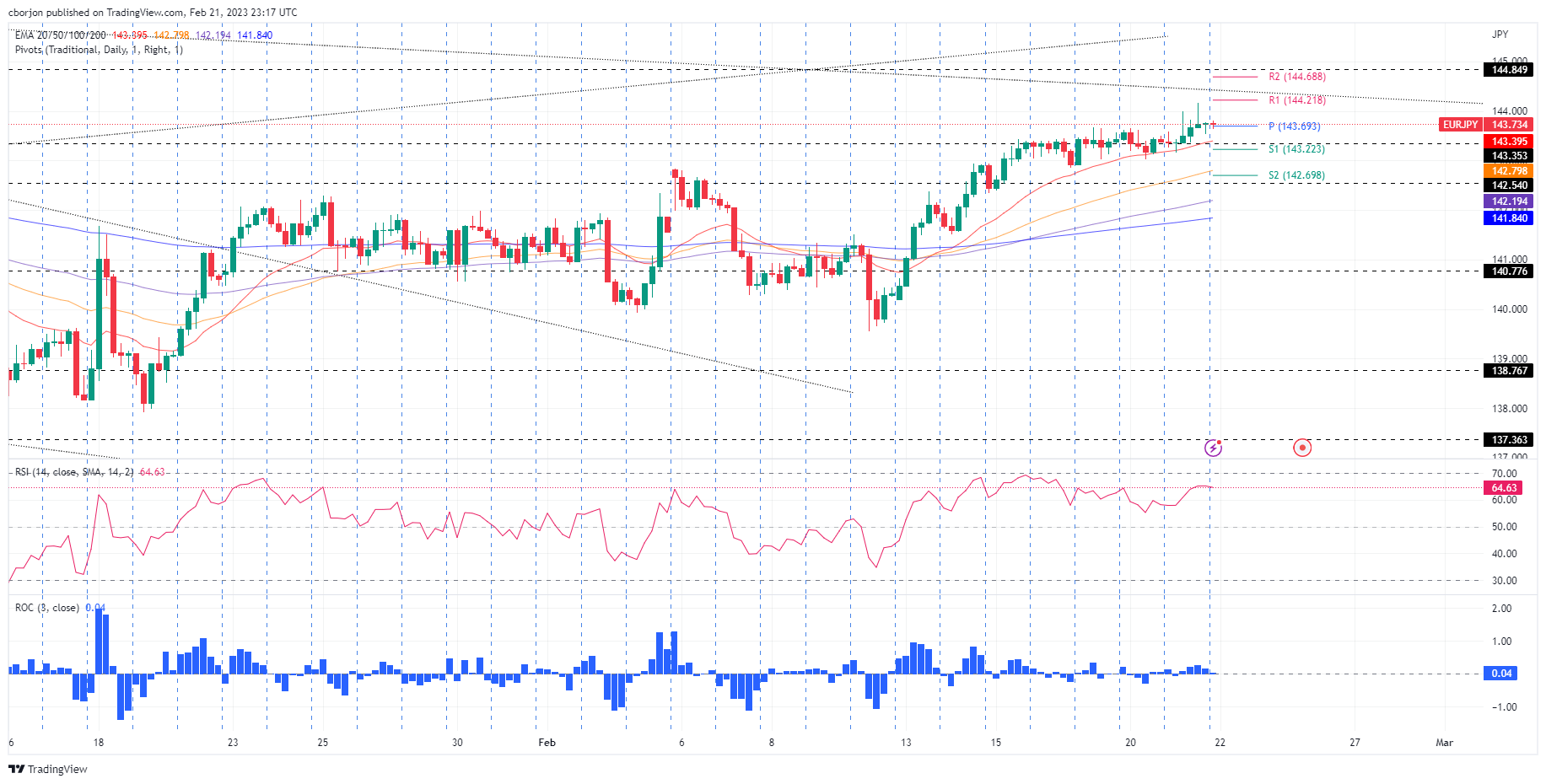- Analytics
- News and Tools
- Market News
CFD Markets News and Forecasts — 21-02-2023
Early Wednesday at 01:00 GMT market sees the key monetary policy decision by the Reserve Bank of New Zealand (RBNZ) amid hopes of another hawkish play by the New Zealand central bank.
RBNZ is up for fueling the market moves with its 10th consecutive rate hike, expectedly worth 0.50%, during early Wednesday. The Interest Rate Decision will be accompanied by the updated economic forecasts in the RBNZ Rate Statement, up for publishing at 01:00 GMT, whereas a press conference with RBNZ Governor Adrian Orr will follow at 02:00 GMT.
The same could push the New Zealand central bank towards announcing 50 basis points (bps) increase to the benchmark rates, from 4.25% to 4.75%.
It’s worth noting that the RBNZ paused its five 50bp rate hike trajectory with a whopping 0.75% increase in the benchmark rate during November 2022.
Ahead of the event, Australia and New Zealand Banking Group (ANZ) said,
We expect a 50bp hike. On balance, local data since the November MPS have pointed towards inflation pressures not being quite as bad as the RBNZ assumed. But the war on inflation is far from won.
On the same line, analysts at Westpac said,
In response to a still intense inflation outlook, the RBNZ is widely expected to deliver a 50bp rate hike to 4.75%, while their forecast for the peak OCR may be lowered slightly. Market pricing is a little short of 50bp for today, perhaps reflecting the cyclone impact on spending and confidence. Markets price the OCR to peak around 5.4%.
On the same line, FXStreet’s Dhwani Mehta said,
Any reaction to the RBNZ policy announcement could be soon reversed, as the dust settles and investors reposition ahead of the Minutes of the US Federal Reserve (Fed) February meeting.
How could it affect NZD/USD?
NZD/USD stays defensive above 0.6200, mildly bid around the seven-week low as the 200-DMA defends Kiwi pair buyers even as the broad US Dollar strength, backed by upbeat US data, weigh on prices. It should be noted that the quote’s latest corrective bounce could be linked to the market’s preparations for the Federal Open Market Committee’s (FOMC) Monetary Policy Meeting Minutes.
Earlier in the week, the RBNZ Shadow board backed the market expectations of witnessing a 0.50% rate hike while the New Zealand Treasury signaled the need for RBNZ to hold the interest rates “higher for longer” due to the Cyclone reconstruction.
Given the clear early signals of witnessing a 0.50% rate hike, the NZD/USD appears well-set to consolidate the latest losses around the seven-week low. However, a negative surprise due to the natural calamity at home won’t hesitate to drown the Kiwi pair.
Apart from the interest rates, the economic forecasts and language of the RBNZ Rate Statement will also be the key for the NZD/USD pair traders to watch. That said, the bleak economic outlook and early signals for peak rates might tease the sellers despite the 0.50% rate hike announcement.
Technically, the Kiwi pair rests on the 200-DMA support surrounding 0.6180, pressured down by a three-week-old resistance line, close to 0.6285-90. However, the RSI (14) line is nearly oversold and hence the downside room appears limited.
Key notes
NZD/USD traders get set for the RBNZ
RBNZ Interest Rate Decision Preview: A 50 bps hike could rescue Kiwi bulls
About the RBNZ interest rate decision and rate statement
The RBNZ interest rate decision is announced by the Reserve Bank of New Zealand. If the RBNZ is hawkish about the inflationary outlook of the economy and raises the interest rates it is positive, or bullish, for the NZD. The RBNZ rate statement contains explanations of their decision on interest rates and commentary about the economic conditions that influenced their decision.
- USD/CHF is aiming to deliver a break above 0.9280 amid the risk aversion theme.
- Rising odds of more rates announcement by the Fed in its March monetary policy meeting are fueling US Treasury yields.
- The Swiss Franc asset has successfully tested the breakout of the downward-sloping trendline placed from 0.9600.
The USD/CHF pair is gathering strength to deliver a break above 0.9280 in the early Asian session. The Swiss franc asset is struggling to deliver more gains despite the risk aversion theme underpinned by the market participants.
An upbeat preliminary United States S&P PMI (Feb) data cleared that the economic activities are getting expansionary again, which could be the result of a rebound in consumer spending. This led to a sheer fall in the risk-perceived assets as expansionary economic activities support a hawkish view from the Federal Reserve (Fed).
S&P500 futures are offering mild gains in the early Tokyo session, however, the overall sentiment is still risk-off. The US Dollar Index (DXY) is struggling to extend gains above 103.90, however, the upside looks favored as volatility in the FX domain might remain high ahead of the Federal Open Market Committee (FOMC) minutes. Rising odds of more rates announcement by the Fed in its March monetary policy meeting are fueling US treasury yields. The return on 10-year bonds has jumped to near 4%.
On the Swiss Franc front, the commentary from Swiss National Bank (SNB) Vice Chairman Martin Schlegel failed to provide strength to the Swiss franc. SNB Schlegel cited the central bank is "still willing" to be active in the foreign currency markets in pursuing its goal of price stability.
USD/CHF technical outlook
USD/CHF has successfully tested the breakout of the downward-sloping trendline placed from November 21 high around 0.9600 on a four-hour scale. Usually, a successful test of a trendline breakout with an absence of solid downside pressure indicates the strength of bulls and prepares a platform for a confident upside move ahead.
The Swiss Franc asset has confidently shifted its auction above the 200-period Exponential Moving Average (EMA) at 0.9245.
Meanwhile, the Relative Strength Index (RSI) (14) is looking to enter into the bullish range of 60.00-80.00.
USD/CHF four-hour chart
-638126191664558028.png)
- Silver price grinds higher after three-day winning streak.
- Upbeat US data, yields underpin US Dollar rebound and probe XAG/USD bulls.
- A mentioning of Fed policymakers’ discussion on pivot could propel Silver price.
Silver price (XAG/USD) seesaws around $21.85 as bulls take a breather during early Wednesday, after three-day uptrend. In doing so, the bright metal fails to respect the US Dollar’s latest rebound but shows traders’ anxiety ahead of the week’s key event.
That said, the XAG/USD bulls could have traced the hopes of more industrial demand amid a recent jump in the manufacturing activity data from major economies, including the UK, the US, Germany and Europe.
On the other hand, the US Dollar Index (DXY) snapped a two-day downtrend to regain 104.00 on Tuesday, grinding higher around 104.20 by the press time, as the US PMIs for February propelled hawkish Fed bets.
It should be noted that the preliminary readings of the US S&P Global Manufacturing PMI rose to 47.8 from 46.9 prior and versus 47.3 market forecasts while the Services PMI jumped to the eight-month high to 50.5 compared to 47.2 expected and 46.8 previous readings. As a result, the S&P Global Composite PMI surpassed 47.5 analysts’ consensus and 46.8 previous reading to mark 50.2 figure.
Following the data, the FEDWATCH tool signals that the money market participants see the benchmark level peaking at 5.3% in July, and staying near those levels throughout the year, versus 5.10% expected by the US Federal Reserve (Fed).
Other than the Fed bets, the upbeat US data also propelled the US Treasury bond yields as the benchmark 10-year bond coupon refreshed a three-month high near 3.95%. Further, the two-year counterpart also jumped to the highest levels since early November 2022, to 4.73% at latest, which in turn propelled the US Dollar and should have capped the XAG/USD upside.
Elsewhere, Wall Street closed in the red as geopolitical fears emanating from Russia and China joined the aforementioned hawkish Fed bets, as well as downbeat earnings forecasts from the tops US retailers including Home Depot and Wall Mart.
Moving on, Fed Minutes should be eyed for policy pivot talks considering the latest cautiously optimistic tone of the policymakers. That said, XAG/USD may rally in case of a policymarkers’ discussion on pausing the rate hikes trajectory.
Technical analysis
Despite the latest rebound, Silver price needs to provide a daily closing beyond the 100-DMA, around $22.00 by the press time.
- EUR/JPY hit a new YTD high, though it dived back below 144.00.
- EUR/JPY Price Analysis: Rejected at 144.00, it could fall back towards 142.50s.
The EUR/JPY hit a fresh year-to-date (YTD) high at 144.16 on Tuesday, closing the session with gains of 0.26%. However, as Wednesday’s Asian Pacific session begins, the EUR/JPY exchanges hands at 143.70, below its opening price by a minuscule 0.03%.
During the last six days, the EUR/JPY was trading sideways, within 142.90-143.60, trapped, although the daily Exponential Moving Averages (EMAs) were resting below the price action. Even though the EUR/JPY pierced 144.00, failure to hold above the latter could exacerbate a re-test of 143.00, as bears take a respite.
The Relative Strength Index (RSI) is still in bullish territory, but its slope turned flat. While the Rate of Change (RoC), suggests that buying pressure is fading.
From an intraday perspective, the EUR/JPY 4-hour chart portrays the pair fluctuating at around Wednesday’s daily pivot point. Albeit the EUR/JPY has managed to extend its gains, the Relative Strength Index (RSI) suggests the cross would advance steadily instead of rallying sharply, which opens the door for a reversal.
The EUR/JPY first resistance would be 144.00. A breach of the latter will expose the R1 daily pivot at 144.21, followed by a downslope trendline that passes around 144.40, ahead of the R2 pivot point at 144.68. Once broken, the EUR/JPY can get to 145.00.
As an alternate scenario, the EUR/JPY first support would be the 20-EMA at 143.40, followed by the S1 daily pivot at 143.22. the next line of defense for EUR/JPY bulls would be the psychological 143.00 figure.
EUR/JPY 4-hour chart
EUR/JPY Key technical levels
“Japan manufacturers gloomy as global slowdown hurts,” said the latest monthly Reuters Tankan survey. The monthly poll, which closely tracks the Bank of Japan's quarterly tankan survey, canvassed 493 big non-financial Japanese firms, of which 244 replied. It was conducted from Feb. 8 to 17, reported Reuters.
The update seems suited after the survey for the manufacturing and services gauges both eased in the last two consecutive months.
That said, Reuters Tankan Manufacturing Index came in as -5.0 for February versus -6.0 in January. On the same line Tankan Non-Manufacturing Index eased to 17 for the said month versus 20.0 prior.
Also read: USD/JPY bulls eye a continuation as the US Dollar bounces back to life
- GBP/USD rose the most in over a week as UK business activity data renew hawkish BoE concerns.
- A pause in UK’s nurse strikes also strengthen the upside bias for the Cable.
- Brexit fears, US Dollar strength keeps bears hopeful.
- FOMC Minutes eyed for clear directions amid hawkish Fed bias, Brexit updates and wage talks between British union, government eyed.
GBP/USD grinds higher past 1.2100, mildly bid around 1.2115 during the initial hours of Wednesday’s Asian trading, as upbeat UK fundamentals keep Cable buyers hopeful ahead of the key Federal Open Market Committee’s (FOMC) Monetary Policy Meeting Minutes.
That said, strong UK data and hopes of overcoming multi-day-old nurse strikes in Britain seemed to have underpinned the GBP/USD pair’s latest run-up. However, upbeat US data and hawkish Fed talks also propelled the US Dollar and challenged the Cable buyers prior to the important Fed Minutes. The Brexit woes join the pre-event anxiety to act as additional filter towards the north.
As per the preliminary readings of the UK S&P Global/CIPS data for February, the Manufacturing PMI rose to 49.2 versus 46.8 expected and 47.0 prior while Services PMI jumped to a seven-month high of 53.3 compared to 48.3 market forecasts and 48.7 previous readings.
Following the upbeat data, Reuters quotes a survey of economists stating that the strength of the survey made it more likely that the BoE - grappling with an inflation rate still above 10% - would raise interest rates to 4.25% in March, despite further signs of easing price pressures in the PMI.
Elsewhere, Reuters reported that nurses will pause strike action in England and begin talks with the British government on Wednesday in a long-running dispute over pay and conditions, the Royal College of Nursing (RCN) said on Tuesday.
Alternatively, Brexit woes loom as the Eurosceptic Conservatives challenge UK Prime Minister’s talks with the European Union (EU) over the Northern Ireland (NI) border issue. The leader of Northern Ireland's largest unionist party (Jeffrey Donaldson, leader of the Democratic Unionist Party) said on Tuesday there was still work to be done to find a resolution to a dispute between Britain and the European Union over their post-Brexit trading arrangements with the province, per Reuters.
On the other hand, the business activity in the United States matched the likes of previously published US inflation numbers, Retail Sales and employment data and boosted the US Dollar.
Following the data, the FEDWATCH tool signals that the money market participants see the benchmark level peaking at 5.3% in July, and staying near those levels throughout the year, versus 5.10% expected by the US Federal Reserve (Fed).
Other than the Fed bets, the upbeat US data also propelled the US Treasury bond yields as the benchmark 10-year bond coupon refreshed a three-month high near 3.95% while the two-year counterpart also jumped to the highest levels since early November 2022, to 4.73% at latest.
As a result, the US Dollar Index (DXY) snapped a two-day downtrend to regain 104.00 on Tuesday, grinding higher around 104.20 by the press time.
Apart from the aforementioned catalysts, the challenges to risk appetite emanating from Russia and China also underpin the US Dollar and test the GBP/USD prices ahead o the Fed Minutes.
To sum up, Fed Minutes should be eyed for policy pivot talks considering the latest cautiously optimistic tone of the policymakers.
Technical analysis
Although the 200-DMA puts a floor under the GBP/USD price near 1.1935, a convergence of the 21-DMA and a three-week-old descending resistance line, close to 1.2165 at the latest, restricts short-term upside of the Cable pair.
- EUR/USD is continuously facing selling pressure from 61.8% Fibo retracement around 1.0700.
- The 89-period (High-Low) SMA band is barricading the Euro consistently.
- A slippage by the RSI (14) into the bearish range of 20.00-40.00 will trigger a downside momentum
The EUR/USD pair has retreated after facing selling interest around 1.0650 in the early Tokyo session. The major currency pair remained extremely volatile as upbeat United States preliminary S&P PMI data resulted in accelerating odds for the continuation of the policy tightening spell by the Federal Reserve (Fed).
Risk-perceived assets like S&P500 witnessed a vertical sell-off as upbeat US PMI data strengthened recession fears. The Fed is going to consider the rebound in the scale of economic activities as a threat to the declining trend in the Consumer Price Index (CPI), which will be addressed by more rate hikes. This pushed the alpha provided on the 10-year US Treasury bonds to 4%.
Meanwhile, the upbeat Eurozone ZEW Survey- Economic Sentiment failed to provide support to the Euro. Higher-than-anticipated sentiment data indicates that the majority of institutional investors are holding an optimistic view on the economic projections.
The presence of potential sellers at the 61.8% Fibonacci retracement (placed from January 6 low at 1.0483 to February high at 1.1033) at 1.0693 is heavily deploying pressure on EUR/USD. This could drag the shared currency pair further.
The 89-period (High-Low) Simple Moving Average (SMA) band is barricading the Euro consistently.
Meanwhile, the Relative Strength Index (RSI) (14) is on the verge of slipping into the bearish range of 20.00-40.00. An occurrence of the same will trigger a downside momentum.
A decisive downside move below February 17 low at 1.0613 will drag the asset toward December 22 low at 1.0573. A slippage below the latter will extend the downside toward January 6 low at 1.0483.
In an alternate scenario, a break above February 16 high at 1.0722 will drive the asset toward 50% Fibo retracement at 1.0758, followed by February 14 high around 1.0800.
EUR/USD two-hour chart
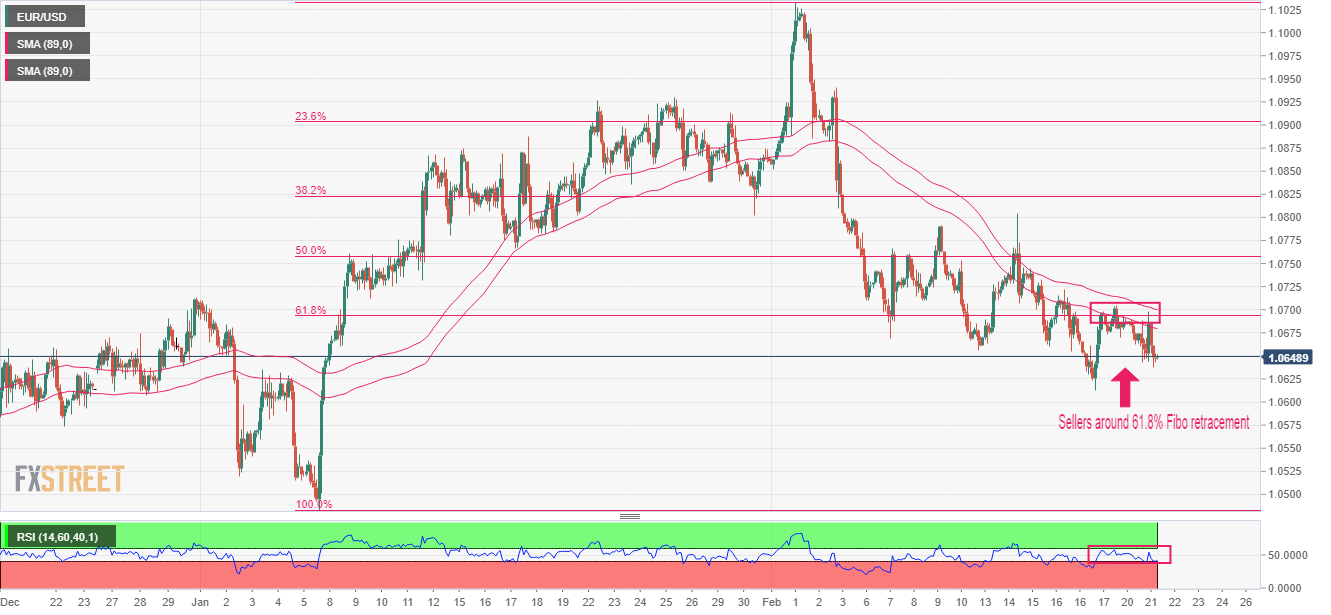
- Gold price remains depressed as United States data, geopolitical risk favor US Dollar bulls.
- XAU/USD technical analysis challenge bears by portraying a falling wedge bullish chart formation.
- Federal Reserve Minutes should defend hawkish bias to keep Gold bears hopeful, otherwise 200-SMA hurdle will be in focus.
Gold price (XAU/USD) holds lower grounds near $1,835, following a two-day downtrend, as markets await the key Federal Open Market Committee’s (FOMC) Monetary Policy Meeting Minutes during early Wednesday. That said, the upbeat prints of the United States activity data and the risk-off mood joined firmer US Treasury bond yields to underpin the US Dollar run-up and weighed on the XAU/USD of late.
Gold price drops on upbeat United States data
With the business activity in the United States matching the likes of previously published US inflation numbers, Retail Sales and employment data, the US Dollar got a boost from the statistics, which in turn weighed on the Gold price.
On Tuesday, the preliminary readings of the US S&P Global Manufacturing PMI rose to 47.8 from 46.9 prior and versus 47.3 market forecasts while the Services PMI jumped to the eight-month high to 50.5 compared to 47.2 expected and 46.8 previous readings. As a result, the S&P Global Composite PMI surpassed 47.5 analysts’ consensus and 46.8 previous reading to mark 50.2 figure.
Following the data, the FEDWATCH tool signals that the money market participants see the benchmark level peaking at 5.3% in July, and staying near those levels throughout the year, versus 5.10% expected by the US Federal Reserve (Fed).
Other than the Fed bets, the upbeat US data also propelled the US Treasury bond yields as the benchmark 10-year bond coupon refreshed a three-month high near 3.95% while the two-year counterpart also jumped to the highest levels since early November 2022, to 4.73% at latest.
Hence, upbeat data propels hawkish Fed bets and underpin the US Treasury bond yields and the US Dollar and exerts downside pressure on the Gold price. That said, the US Dollar Index (DXY) snapped a two-day downtrend to regain 104.00 on Tuesday, grinding higher around 104.20 by the press time.
Geopolitical tension also weighs on XAU/USD
Apart from the Federal Reserve-inflicted losses, the Gold price also bears the burden of the escalation of geopolitical tension surrounding China and Russia. The reason could be linked to comments from US Secretary of State Antony Blinken, who said the United States suspects China is considering providing military support to Russia. On the same line are the market concerns of the US-Taiwan trade deal. On the other hand, Russia suspended its nuclear arms treaty with the US and pledged to maintain its military actions in Ukraine.
That said, Russian President Vladimir Putin delivered his state of the nation address to Russia’s Federal Assembly while speaking to both houses of parliament on Tuesday. During the speech, Russian President Putin clearly mentioned, “Our task is to lead our economy to new frontiers,” which in turn highlights further geopolitical tension surrounding Ukraine. On the same line, US Deputy Treasury Secretary Wally Adeyemo said on Tuesday, “US and allies plan new sanctions this week to continue to isolate Russia over the war in Ukraine.”
It should be noted that the geopolitical fears joined the weaker-than-expected earnings forecasts from the major US retailers, namely Walmart and Home Depot, to highlight the risk-off mood and weighed on the Wall Street benchmark. The same favored the rush towards risk safety and propelled US Dollar while also weighing on the Gold price.
Federal Reserve Minutes appear as the key for Gold bears
Although markets position as bearish ahead of the Federal Reserve (Fed) monetary policy meeting minutes, the US central bank appears cautiously optimistic while announcing the latest rate hike worth 0.25%. Hints of the same will be sought for clear directions of the Gold price. Should the policymakers appear ready to talk policy pivot, the XAU/USD may witness a recovery, an absence of which could keep the Gold price weak.
Gold price technical analysis
Gold price keeps grinding inside a three-week-old falling wedge bullish chart formation on the four-hour (4H) play. That said, the looming bear cross on the Moving Average Convergence and Divergence (MACD) indicator keeps sellers hopeful while a steady Relative Strength Index (RSI) line suggests a continuation of sideways performance near the upper line of the stated wedge, which in turn could be risked on the Federal Reserve (Fed) Minutes.
That said, $1,838 is the key level as a break of which will confirm the falling wedge formation and suggest (theoretically) a run-up toward $1,940.
It’s worth noting that the 61.8% Fibonacci retracement level of the metal’s run-up from mid-December 2022 to early February 2023 and the 200-bar Simple Moving Average (SMA), respectively near $1,845 and $1,892, could test the Gold buyers after the confirmation of the bullish chart pattern.
Meanwhile, XAU/USD pullback should aim for January’s low near $1,825 before testing the latest bottom surrounding $1,818.
Following that, the stated wedge’s lower line, close to $1,812 by the press time, could challenge the Gold bears.
Overall, the Gold price remains bearish but the downward trajectory seems to lose momentum and forms a bullish chart pattern, which in turn can trigger a short-term recovery in case fundamentals support.
Gold price: Four-hour chart

Trend: Upside expected
- AUD/USD is expected to deliver more downside below 0.6850 amid the risk-off market mood.
- A solid case for the continuation of policy tightening by the Fed sent yields on fire.
- Higher Australian Wage Price Index could keep inflationary pressures elevated.
The AUD/USD pair is attempting to build a short-term cushion around 0.6850 in the early Asian session. The Aussie asset is expected to deliver more weakness after surrendering the 0.6850 cushion as the market mood is quite negative ahead of the release of the Federal Open Market Committee (FOMC) minutes.
S&P500 witnessed a massive sell-off on Tuesday as the upbeat preliminary S&P PMI data bolstered the expectations of more rates by the Federal Reserve (Fed) ahead. Upbeat economic activities indicate that the demand for labor could accelerate further, which will result in higher consumer spending. This might propel the United States Consumer Price Index (CPI) ahead. The US Dollar Index (DXY) climbed to near 103.90 amid the risk aversion theme.
A solid case for the continuation of policy tightening by Fed chair Jerome Powell sent yields on fire. The alpha generated on 10-year US Treasury bonds jumped to near 4%.
Preliminary S&P Manufacturing PMI (Feb) climbed to 47.8 from the consensus of 47.3 and the former release of 46.9. The Services PMI soared to 50.5 from the estimates of 47.2 and the prior release of 46.8.
For further guidance, the release of the FOMC minutes will be keenly watched. The FOMC minutes will provide the rationale behind hiking interest rates by 25 basis points (bps) to 4.50-4.75%. Apart from that, cues about the interest rate guidance will be in focus.
On the Australian front, after hawkish Reserve Bank of Australia (RBA) minutes, investors are focusing on the Labor Cost Index (Q4) data. On a quarterly basis, the economic data is seen steady at 1%. The annual data is expected to improve to 3.5% from the former release of 3.1%. Firms are offsetting the demand for labor by providing higher wages, which is going to keep Australian inflationary pressures at elevated levels.
- NZD/USD bears moved in as the US dollar surged on Fed sentiment.
- It is all about the RBNZ for today and then the Fed minutes.
NZD/USD has traded on the offer on Tuesday, falling from a high of 1.0698 to a low of 1.0637 so far. The US Dollar bulls stepped in to clean up some of the stale orders that were in the market contrary to the economic data of late that has flipped the script on the narrative surrounding the Federal Reserve.
DXY, an index that measures the greenback vs. a basket of currencies, rallied into last Friday's shorts and moved back into the 104.20s as investors swallowed yet another hard pill in inflationary pointing to US economic data on Tuesday. US Treasury yields hit new highs after both the services and manufacturing sectors in February with S&P Global PMIs beating their prior outcomes and estimates.
Traders are setting up for a longer-than-anticipated stiff monetary policy stance by the Federal Reserve following a slew of strong economic data. ''This process still has a ways to go, in our view,'' analysts at Brown Brothers Harriman explained. The analysts noted that the WIRP suggests 25 bp hikes in March, May, and June that takes Fed Funds to 5.25-5.50%.
''Given how strong the data have been recently, we see growing risks of a fourth 25 bp hike that takes us up to 5.50-5.75%, though that is not being priced in yet. This should eventually change,'' the analysts said. ''Strangely enough, an easing cycle is still expected to begin in Q4 but at much lower odds. Eventually, it should be totally priced out into 2024 in the next stage of Fed repricing.''
RBNZ eyed
The next major catalyst for the US Dollar will be the Federal Reserve's release of the minutes of its last meeting on Wednesday. However, in the meanwhile, the focus will be on the Reserve Bank of New Zealand.
''Today is all about the RBNZ,'' analysts at ANZ Bank said. ''We expect a 50bp hike, and given the inflation risks posed by Gabrielle, it’d be a surprise to see their OCR projections fall,'' they added.
''Greater uncertainty and a sense of resilience to higher rates locally and globally also potentially poses upside risks to the terminal OCR. We think that’ll ultimately be NZD-positive, as will the rebuilding better vibe, which all lies ahead. Bring on 2pm, let’s get this decision behind us!''
- USD/CAD reclaims 1.3500, distancing from the daily EMAs, as the uptrend accelerates.
- The major is testing a downslope trendline, which, if broken, the USD/CAD can rally to 1.3700.
The USD/CAD advanced in the North American session, though it retraced from 7-week highs at 1.3549, it retreated late in the session. Nevertheless, the USD/CAD is trading at 1.3537 and is gaining 0.65%.
After bottoming around 1.3262, the USD/CAD pair is gaining traction, and it’s approaching a four-month-old downslope resistance area at around 1.3560-75. Albeit, the major cleared significant hurdles on its way north, namely the 20, 50, 100, and 200-day Exponential Moving Averages (EMAs), consolidated within a 200-pip range. Nonetheless, the USD/CAD reclaiming the 1.3500 figure exacerbated the rally to multi-week highs.
For an uptrend resumption, the USD/CAD needs to break a downslope resistance trendline at around 1.3560-75. Once broken, the USD/CAD might test the 1.3600 psychological level. A breach of the latter, the USD/CAD will rally toward the January 3 daily high at 1.3685, followed by 1.3700.
As an alternate scenario, the USD/CAD first support would be 1.3500. Once cleared, the path toward the 50-day EMA at 1.3436 would be clear. The following demand area to be tested by the USD/CAD would be the confluence of the 20 and 100-day EMAs, at 1.3418 and 1.3413, respectively.
USD/CAD Daily chart

USD/CAD Key technical levels
- The US Dollar is resurging and has been taken back into the control of the bulls.
- US Dollar bulls target 105.35 and 106.00 thereafter.
The US Dollar is trading in confluence to the persistent inflationary theme since data over the last several days has turned the screw and flipped the script with regard to the timings of a Federal Reserve pivot.
Higher Treasury yields and a projected 5.3% terminal Fed funds rate have seen a resurgence in the US Dollar index, DXY. This index measures the greenback vs. a basket of currencies as the following technical analysis will illustrate that is leaning with a bullish bias:
Taking into consideration the fundamentals as outlined above, has the US Dollar got room to go on the upside until any major-looking resistance is seen?
DXY monthly chart
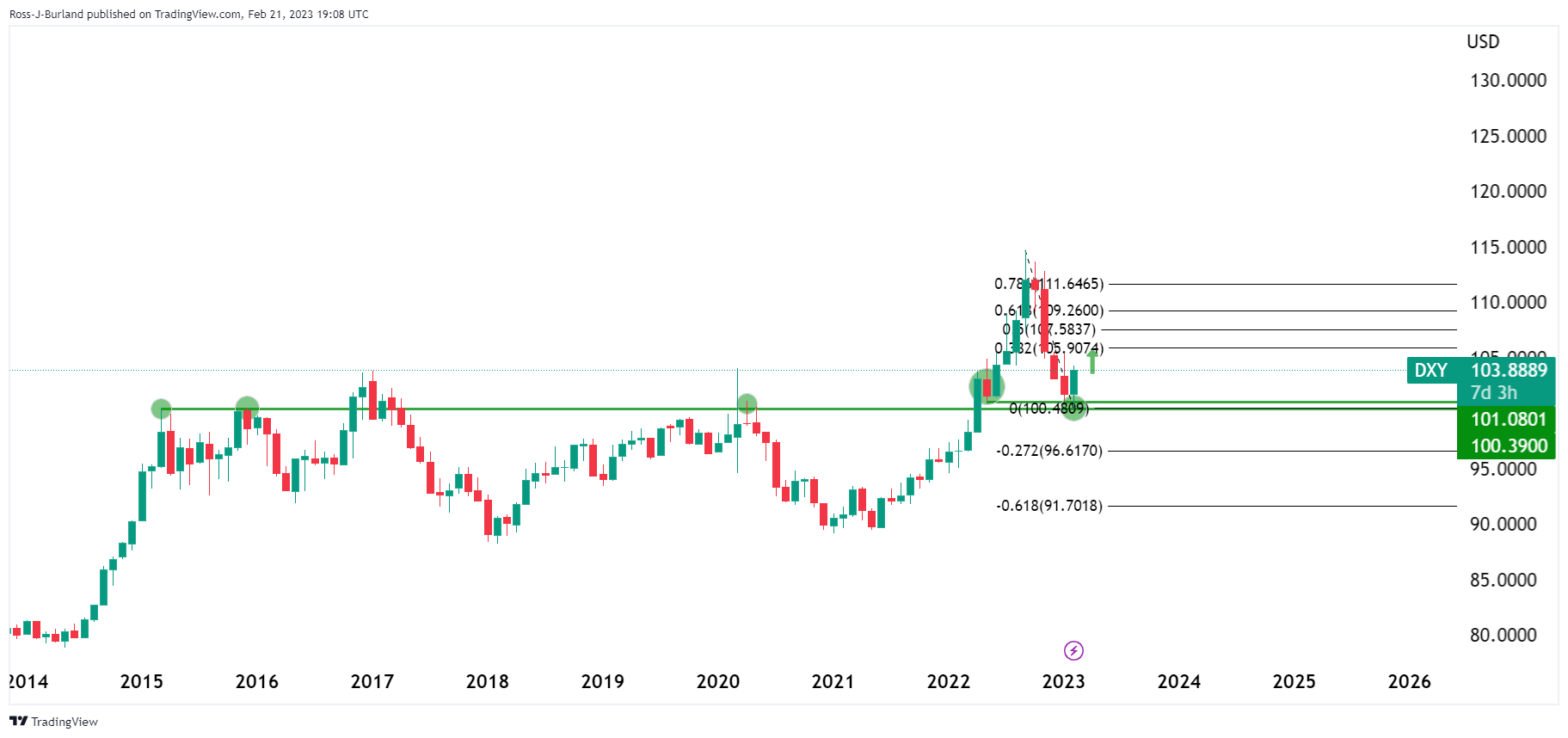
Looking at the above chart and the monthly structures, we can see that there have been plenty of reactions from the recent lows near 101.00 over many months of history in the DXY index. If the index is going to continue to use that as a support base, then where is the next area of liquidity for the greenback as per the DXY chart going to be?
Given the momentum behind the bid as per the monthly chart's recent candle's engulfment of the prior month's body, it is evident that the bulls are in control and by some margin with 105.35 eyed:
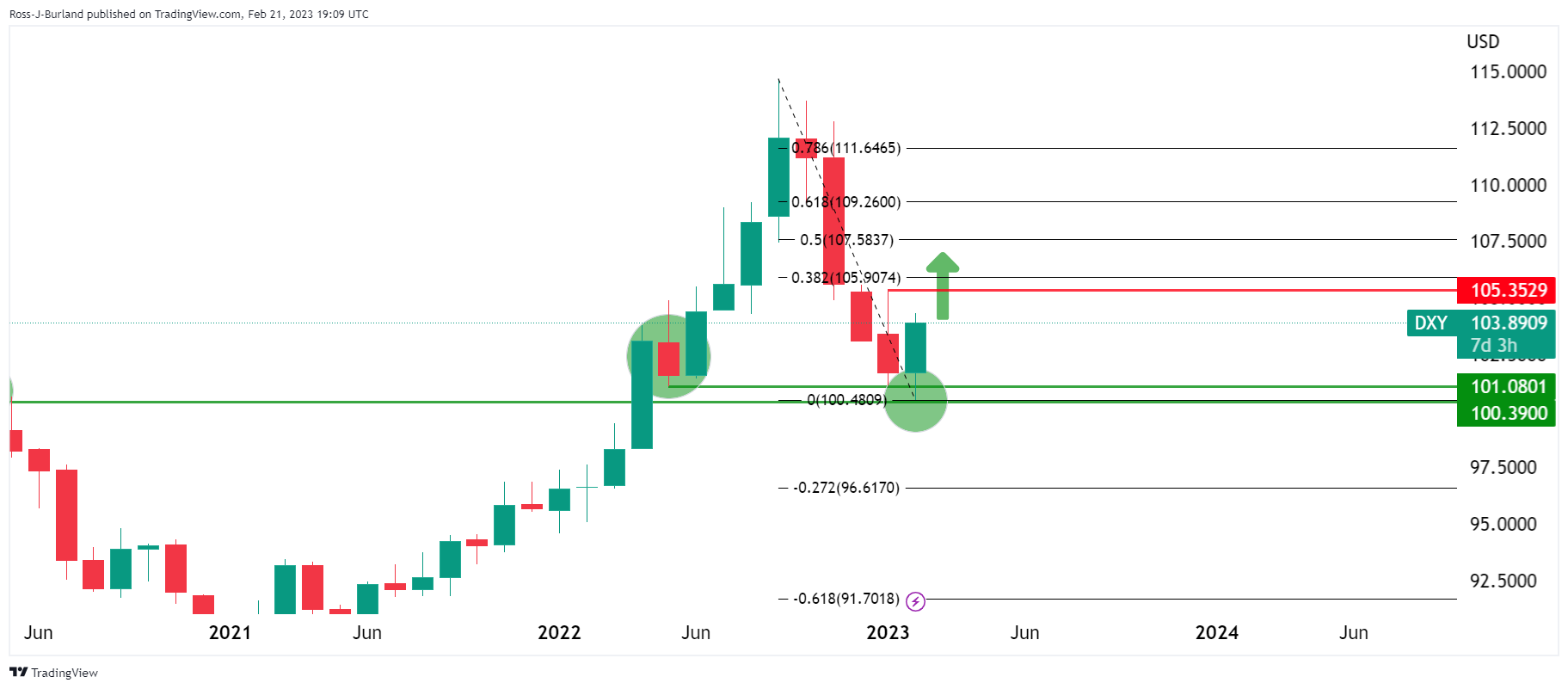
The 38.2% Fibonacci retracement is also compelling near 106.00.
Down on the weekly chart, 106 is seen as a clear target and resistance area:
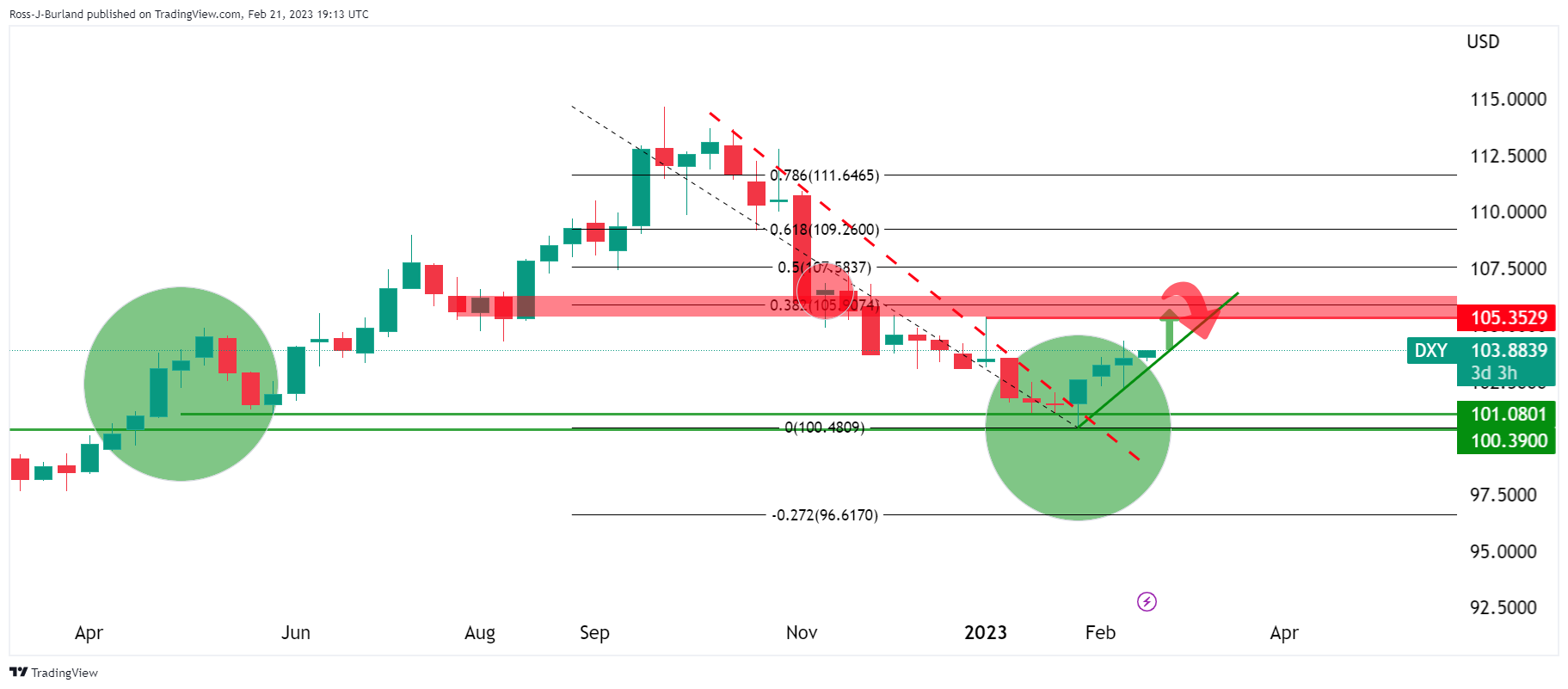
From a daily perspective, the 104.30s were pinned but there is room to go on the upside following the correction into old resistance that is now acting as a support structure.
In conclusion, while being on the front side of the dynamic support line, the bulls can target at least the space between today's highs and all the way to the start of the year's highs near 105.35:
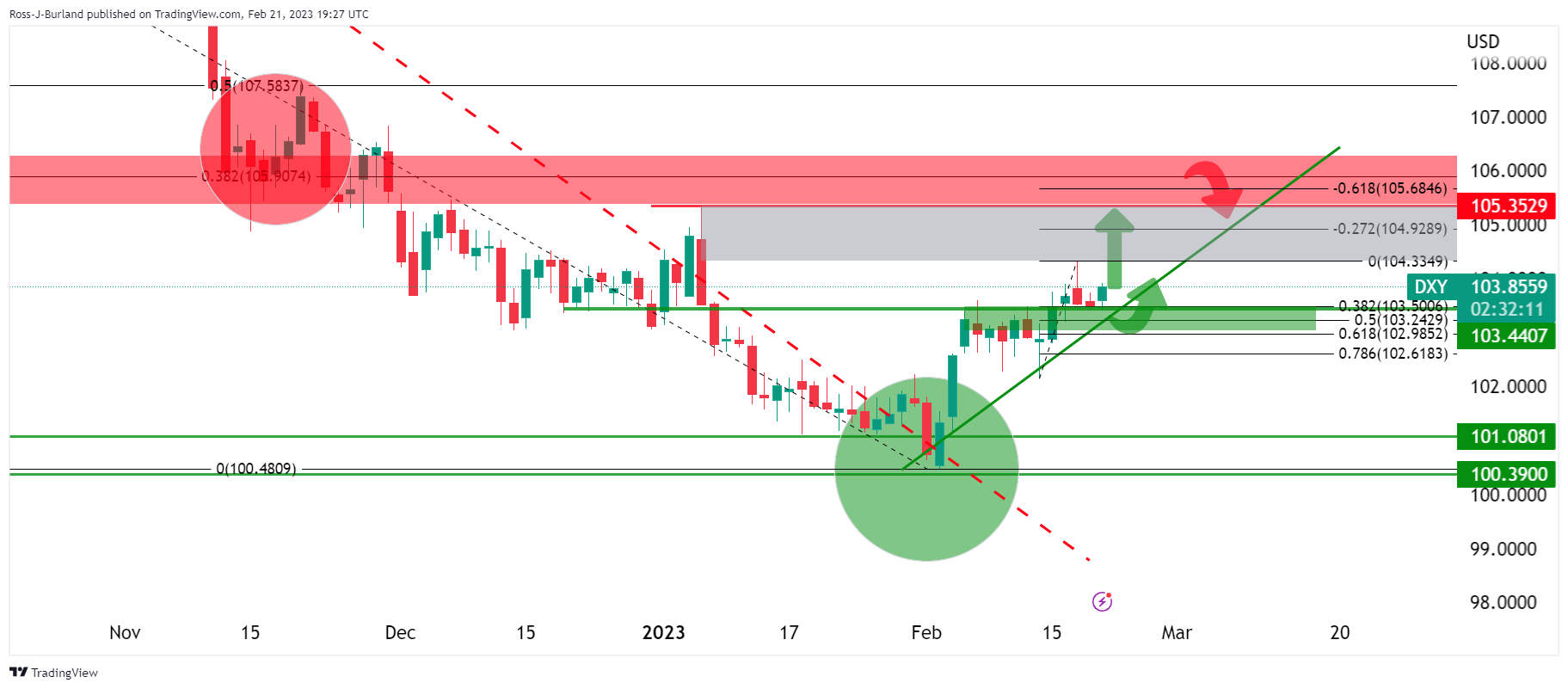
What you need to take care of on Wednesday, February 22:
The US Dollar stands victorious across the FX board as risk aversion led the way. The market focus remained on geopolitical tensions as the conflict between the US and Russia escalated in the last 24 hours. The latest on the matter came from Secretary of State Antony Blinken, who said the United States suspects China is considering providing military support to Russia. Moscow responded by suspending its nuclear arms treaty with the US and pledging to maintain its military actions in Ukraine.
Wall Street returned from the long weekend and followed the negative lead of their overseas counterparts. US indexes are sharply down, losing roughly 2% each. The slump was exacerbated by renewed price pressure concerns after the release of the US S&P Global PMIs. The Manufacturing and Services index came in better than anticipated. Still, the official report noted that "firms continued to seek to pass on greater input costs to customers through hikes in output charges. The rise in selling prices was the quickest for four months and strong overall." Continued inflationary pressures mean the US Federal Reserve will remain on the tightening path for longer.
Annual inflation in Canada rose by 5.9% in January, down from 6.3% in December. Also, the Bank of Canada's Core CPI, which excludes volatile food and energy prices, was up by 5% on a yearly basis from 5.4% in December.
United Kingdom Prime Minister Rishi Sunak Spokesperson said the prime minister had stated unequivocally that there are still substantive issues to be resolved with the EU, bringing back to the table Brexit woes.
Beyond US S&P Global PMIs, European ones were mixed, with the services sector expanding but the manufacturing one still in contraction mode. UK figures, on the other hand, were quite encouraging.
EUR/USD trades at around 1.0650, not far from an early low at 1.0636. GBP/USD hovers around 1.2110, with the Pound supported by upbeat local data.
Commodity-linked currencies are sharply down, with AUD/USD trading at 0.6855 and USD/CAD up to 1.3520.
The USD/JPY flirts with 135.00, while USD/CHF trades at around 0.9270.
Spot gold trades at $1,833 a troy ounce, maintaining its bearish route, while crude oil prices also eased, and WTI stands at $76.60 a barrel.
The Reserve Bank of New Zealand will announce its monetary policy decision early on Wednesday.
Like this article? Help us with some feedback by answering this survey:
- USD/JPY is biased to the upside as a resurgence int he US Dollar is underway.
- 134.50 is a line on the sand and the market has a bullish bias towards 137.50 while above it.
USD/JPY is pressing higher despite the technicals that have been biased to the downside, at least for the meanwhile move into the length that had been piling up in the market over the past several days. Instead, the bulls stay in control and have homed in on the 135 area as volume return to the forex space.
At the time of writing, USD/JPY is trading at 134.98 and has travelled between a low of 134.14 and a high of 135.22 so far. The US Dollar has been offering good two-way business on the day in volatile trading. However, the dominant theme remains an inflationary one and that is fueling the bid in the middle of the US session following yet more positive US economic data.
US Treasury yields hit new highs on Tuesday on the confirmation in the US data that both the services and manufacturing sectors have been robust in the month of February with S&P Global PMIs beating both prior and estimates. Investors are setting up for a longer-than-anticipated stiff monetary policy stance by the Federal Reserve following a slew of strong economic data. ''This process still has a ways to go, in our view,'' analysts at Brown Brothers Harriman explained.
The analysts noted that the WIRP suggests 25 bp hikes in March, May, and June that takes Fed Funds to 5.25-5.50%. ''Given how strong the data have been recently, we see growing risks of a fourth 25 bp hike that takes us up to 5.50-5.75%, though that is not being priced in yet. This should eventually change,'' the analysts said.
''Strangely enough, an easing cycle is still expected to begin in Q4 but at much lower odds. Eventually, it should be totally priced out into 2024 in the next stage of Fed repricing.''
The next major catalyst will be the Federal Reserve's release of the minutes of its last meeting on Wednesday, which will give traders a glimpse of how high officials are projecting interest rates will go following this impressive run of recent data for the first months of the year including stronger than expected jobs and inflation numbers.
USD/JPY & DXY technical analysis
In all of the above, it will be interesting to see how much further the US Dollar, DXY, can go:

We have seen a number of reactions from the recent lows over many months of history in the DXY index as the above illustrates, so why would it be any different this time around? 101.00 is a strong level of support so the thesis is higher from here, in the meanwhile at least.

The 38.2% Fibonacci retracement is eyed as the first target near 106.00 on a break of the prior month's highs of 105.35.
Down on the weekly chart, 106 is a clear target and resistance area:

From a daily perspective, the 104.30s were pinned but there is room to go on the upside following the correction into old resistance that is now acting as a support structure. A continuation, therefore, can be anticipated to breach the space between today's highs and all the way to the start of the year's highs near 105.35:

USD/JPY technical analysis

This leaves a bullish bias on the US Dollar pairs and the Yen would be expected to weaken into the overhead USD/JPY four-hour resistance in the coming days.
Zoomed in ...
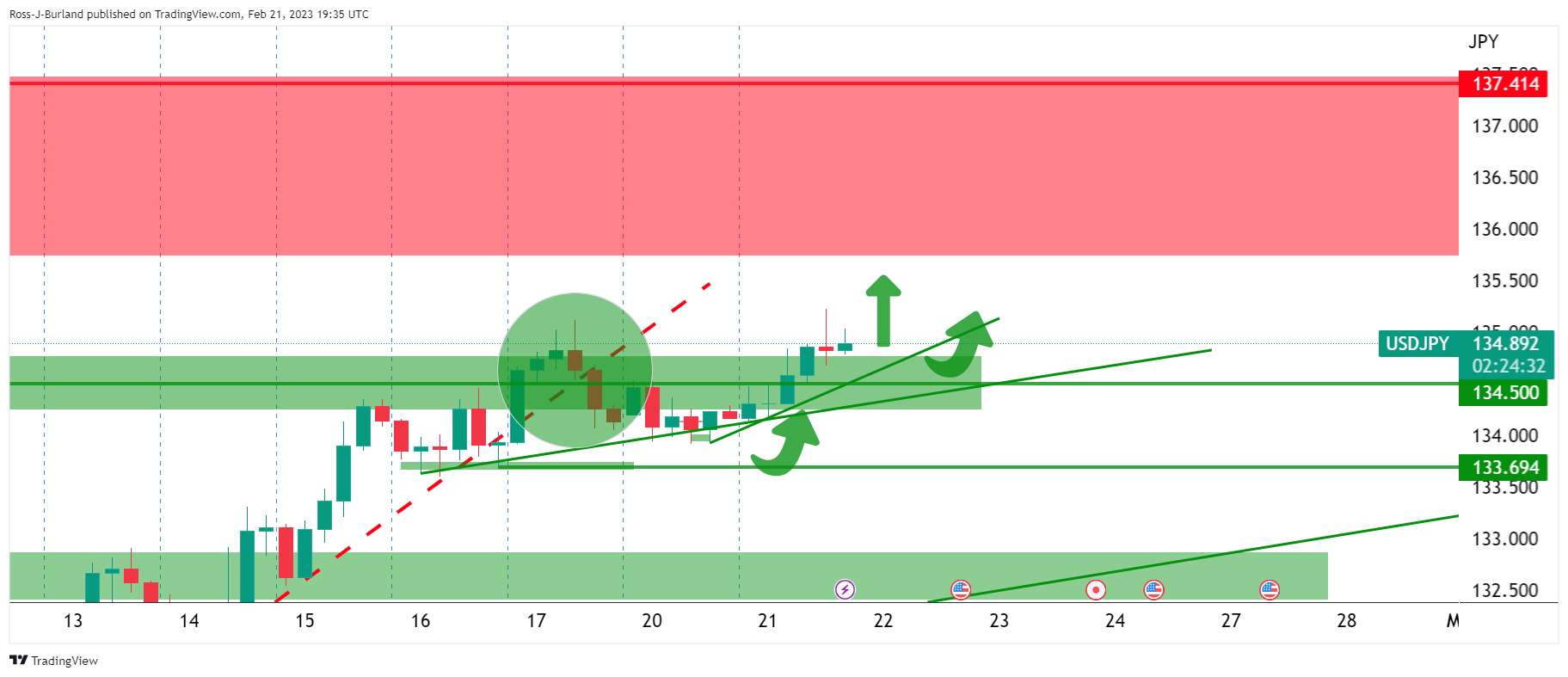
134.50 is a line on the sand and the market has a bullish bias towards 137.50 while above it.
- Speculations for further tightening by the Federal Reserve underpin the US Dollar, a headwind for oil prices.
- China’s reopening and Russia expected to cut its oil production capped WTI’s fall.
- WTI Technical analysis: Neutral to downward biased; once it breaks $75.00, a retest of monthly lows is likely.
Western Texas Intermediate (WTI), the US crude oil benchmark, is erasing Monday’s gains which fell shy of reaching the 20-day Exponential Moving Average (EMA), and dropped towards the lows of the week around 75.97 before settling around the current price. At the time of typing, WTI is losing 0.94%, trading at 76.64 per barrel.
Oil prices affected by a strong US Dollar
The strong US Dollar (USD) narrative is hitting the commodities market. During the last week, Federal Reserve (Fed) officials continued their hawkish rhetoric while data supported some of their comments. Traders should remember that although Cleveland and St. Louis Fed Presidents Loretta Mester and James Bullard do not vote in the FOMC, both supported raising rates by 50 bps.
That spurred speculations that the US Federal Reserve (Fed) might hike rates not twice but three times, which could lift the Federal Funds Rate (FFR) to the 5.25%-5.50% mark.
Meanwhile, the US Dollar Index (DXY), which tracks the buck’s value vs. a basket of six currencies, advances 0.29%, up at 104.184, a headwind for dollar-denominated assets. Therefore, a strong USD makes oil prices expensive for foreign countries.
Aside from this, China’s reopening is a factor playing into WTI’s price, and capped oil prices fall in Tuesday’s session. Russia’s announced that it plans to cut production by 500,000 bpd or about 5% of its output in March as retaliation to the West imposing price caps on Russian oil and oil-related products.
Data-wise, US oil inventories and data, which were to be released on Tuesday, was postponed in observance of President’s Day and moved to Wednesday and Thursday.
WTI Technical analysis
From a technical perspective, WTI is still neutral to downward biased, capped by all the Exponential Moving Averages (EMAs) resting above oil’s price. In addition, the Relative Strength Index (RSI) is in bearish territory and is aiming downwards. The Rate of Change (RoC), albeit steadily, shows that sellers continue gaining momentum.
Hence, WTI’s first support would be $75.97. Once cleared, the oil price would tumble to the last week’s low at $75.36, followed by the MTD low at $72.30.

- GBP/USD target 1.2270 for the days ahead.
- GBP/USD bears need to get below 1.1900.
Forex markets are unforgiving and prices are two-way as volume kicks in again following the slow start to the week on Monday that was put down to a US holiday. GBP/USD rallied from a 50% mean reversion of Friday's bullish run and broke to 1.2150 on Tuesday, breaking a key resistance around 1.2050 which has invalidated the prior downside bias for the time being as the following top-down analysis will illustrate:
At the start of the week, it was shown in the following article that there was a case for lower due to the formation of the weekly head and shoulders:
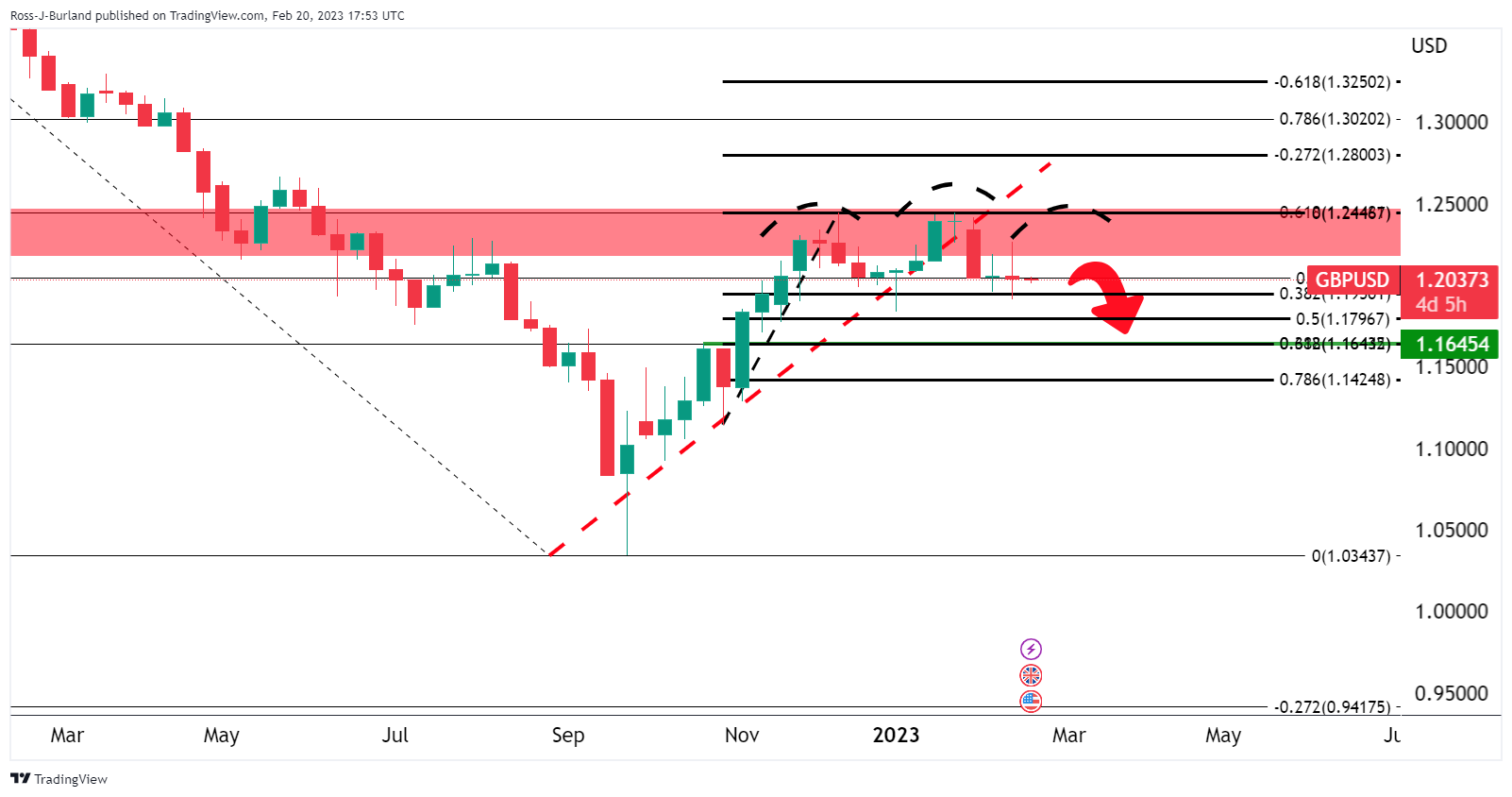
While the thesis remains valid, the meanwhile price action is pointing to a bullish continuation of the correction of the the final days of last week's bearish leg:
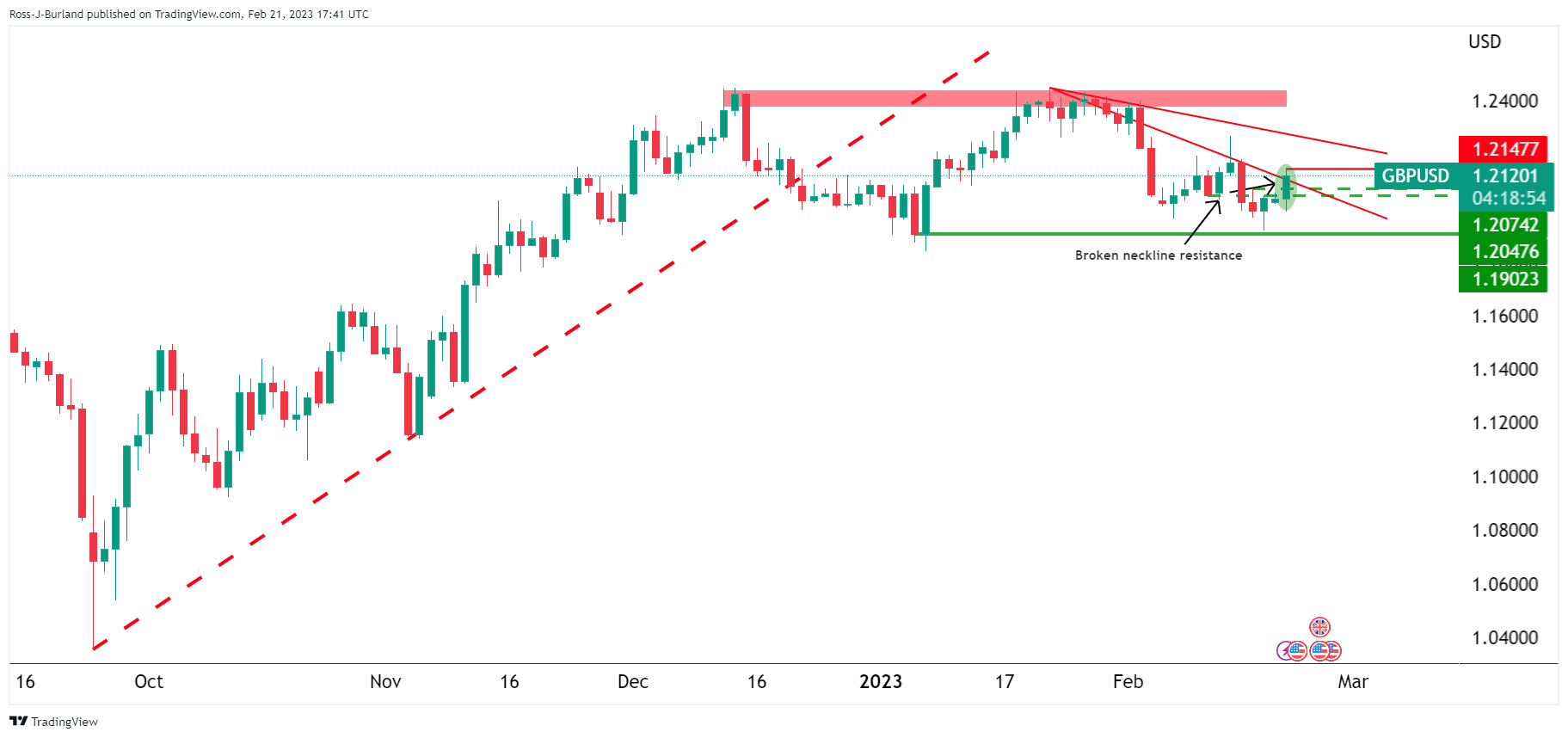
Zoomed in ...
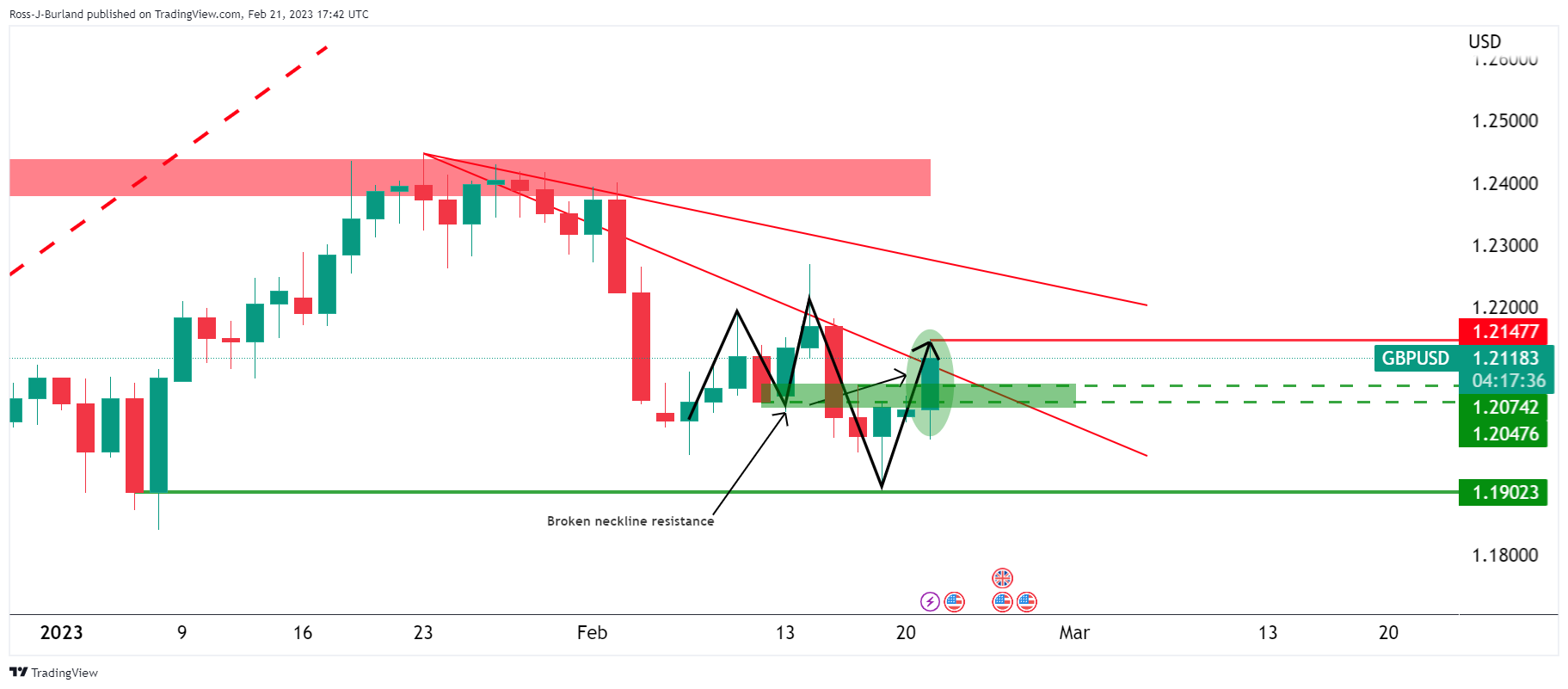
The M-formation's neckline was broken on Tuesday, invalidating the bearish thesis from the start of the week's analysis:
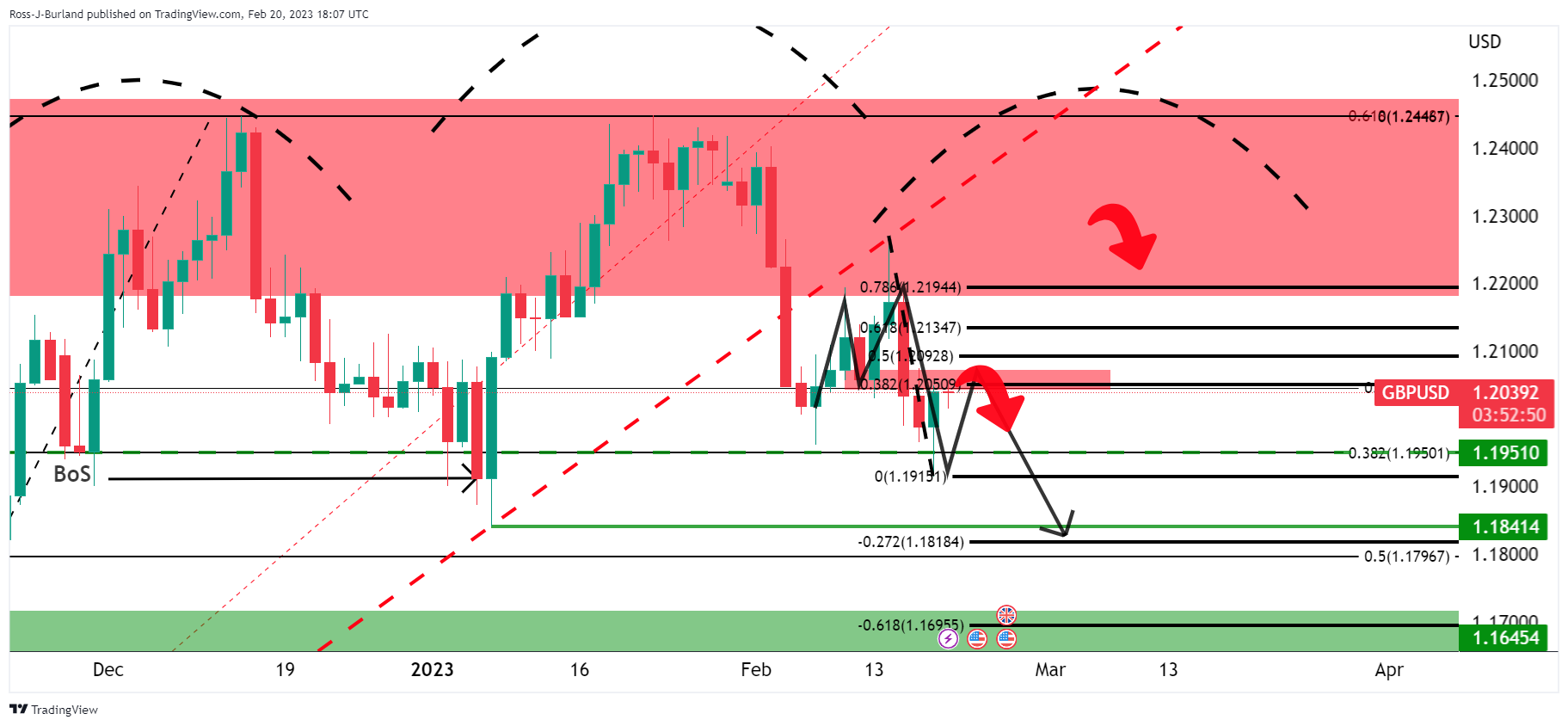
In the meantime, instead, the bulls are in control and are now needing to rely on the 1.2070s as a possible newly formed support structure as illustrated below:
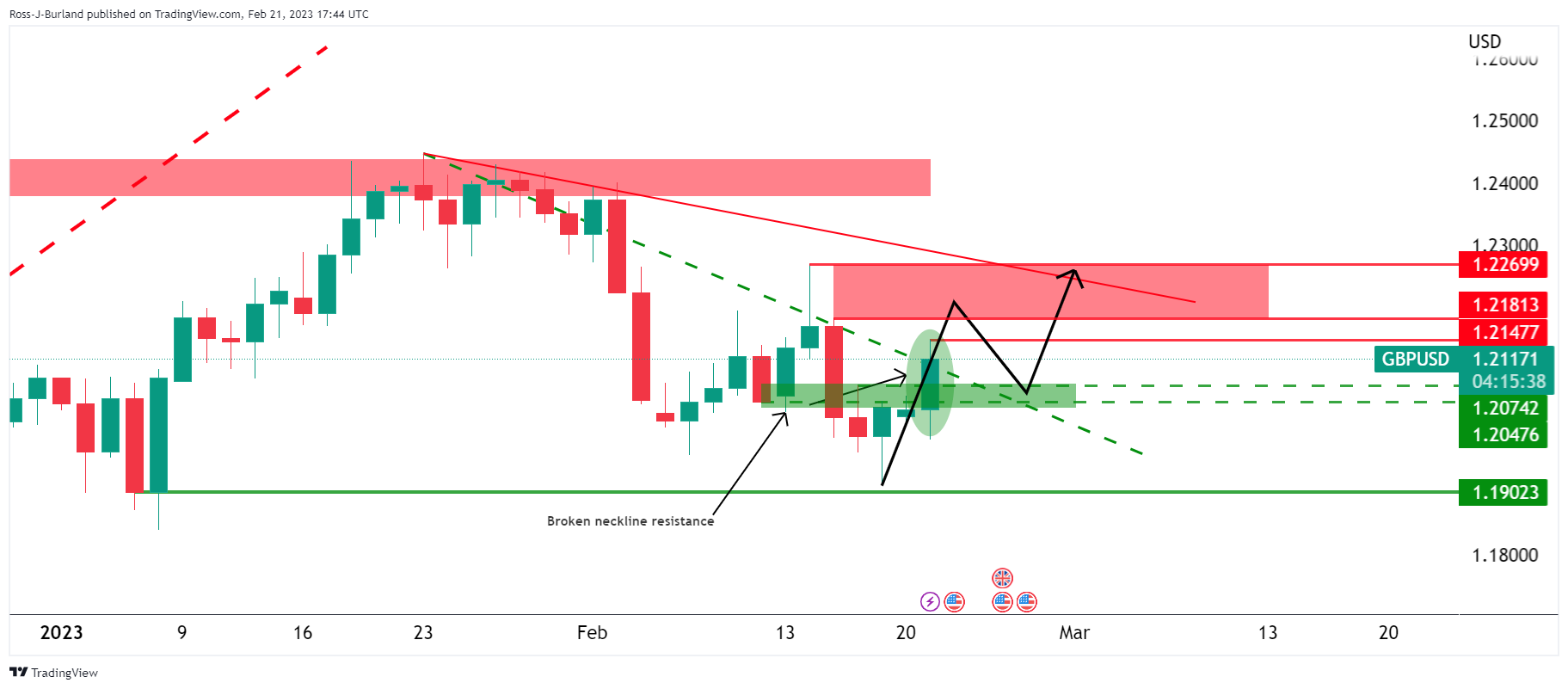
1.2270 is eyed as an upside target for the days ahead of the market and does not just remain in a consolidative structure bounded by 1.1900 and 1.2150.
- EUR/USD drops steadily as traders wait for FOMC’s minutes.
- US S&P Global PMI for February showed the economy’s resilience, except for manufacturing activity.
- ECB’s Rehn commented that lifting rates in March is appropriate and should continue until the summer.
EUR/USD extends its bearish continuation after Monday’s gains, offset by the US Dollar (USD), were sponsored by a risk-off impulse, despite upbeat data revealed in the Euro area. Nevertheless, US PMIs showed after Wall Street’s opening justified US Dollar strength, hence the EUR/USD fall. At the time of writing, the EUR/USD declined 0.37%, trading at 1.0661.
US economic data underpins the US Dollar, a headwind for the EUR
S&P Global announced that the US economy experienced a boost in business activity in February, with all indices exceeding expectations. However, despite this positive development, the S&P Global Manufacturing PMI indicated that manufacturing activity remained in contractionary territory, coming at 47.8.
Meanwhile, according to wires, geopolitical developments surrounding the conflict between Russia and Ukraine have escalated. Anthony Blinken, the US Secretary of State, cautioned China against providing additional military support to Russia during its invasion of Ukraine. He also stated that there would be severe repercussions if such assistance were given. Meanwhile, in a display of US support after Blinken’s remarks, President Joe Biden visited Ukraine’s President Zelenskyy in Kyiv.
Earlier in the European session, mixed PMI data for the bloc was unveiled by S&P Global. The S&P Global Services and Composite PMIs were better than expected in Germany and the Eurozone, though the Manufacturing Indices remained in contraction. Aside from this, the German ZEW economic sentiment improved to 28.1
In central bank speaking, a slew of European Central Bank (ECB) officials added to the chorus of hawks, namely Rehn. He said it’s appropriate to raise rates beyond March, and rates need to peak around the summer of 2023 while pushing back against rate cuts.
Given the backdrop, the EUR/USD fell from around the week’s high and has retraced below the 1.0660 area. However, EUR/USD traders will face a solid support area around the 50 and 20-day Exponential Moving Average (EMAs), followed by further demand areas. Nevertheless, neither sellers/buyers have opened new positions, as they await the release of the latest FOMC meeting minutes.
EUR/USD Technical analysis
The single currency’s failure to crack the 100-day EMA at 1.0842 exacerbated the EUR/USD’s pair fall toward the 1.0600 area. In addition, further Relative Strength Index (RSI) lower readings, as buyers’ pressure fades, and the Rate of Change (RoC) indicating that sellers are gathering momentum justified the leg-down. Therefore, the EUR/USD path of least resistance is downwards.
The EUR/USD next support would be the 1.0600 mark. A breach of the latter will drive prices to the 50-day EMA at 1.0584, followed by the 20-day EMA at 1.0584.
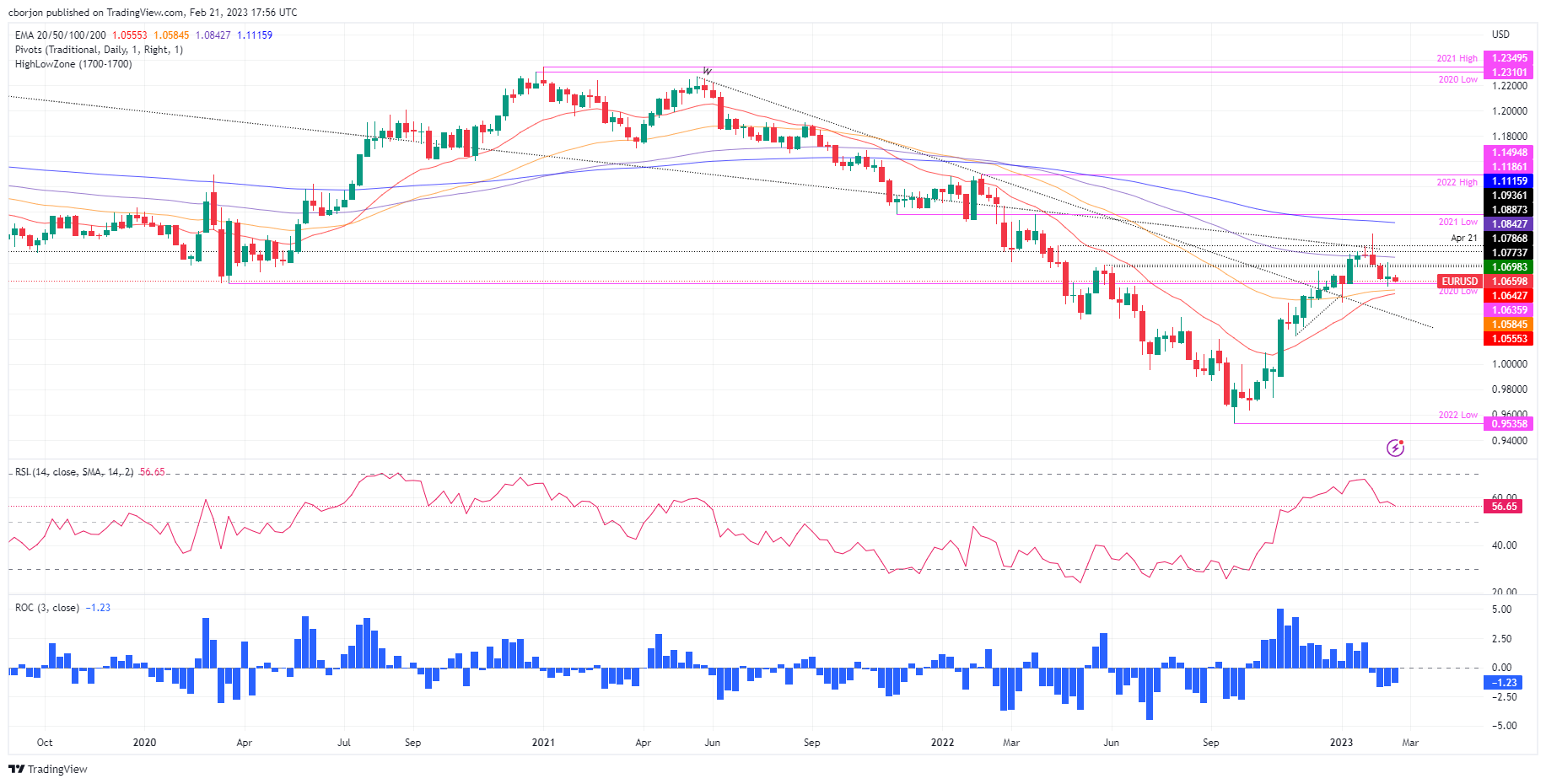
- USD/MXN cannot drop to fresh YTD lows after hitting 18.3301 on February 17.
- Positive divergence between the RSI and USD/MXN price action suggests further upside is warranted.
- USD/MXN: If it reclaims 18.45, it could test $18.70; otherwise, the YTD lows are targeted.
The Mexican Peso (MXN) weakens vs. the US Dollar (USD) as Wall Street’s session begins, yet stills exchanging hands below Monday’s high of 18.4366, which would further warrant downward action. However, the USD/MXN is registering decent gains of 0.23%, trading at 18.3977.
From a daily chart perspective, the USD/MXN remains downward biased. In the last three days, USD/MXN sellers had been unable to drag prices towards the $18.00 psychological barrier, beneath the YTD low of 18.3301.
Momentum indicators like the Relative Strength Index (RSI), albeit in bearish territory, suggest that buying pressure could be building. The Rate of Change (RoC) hit the neutral level after three-straight days of equal to no volatility.
The USD/MXN needs to conquer Monday’s high for an upward reversal. Once cleared, the USD/MXN might rally toward the confluence of February 16 and 17 daily highs and the 20-day EMA at the 18.66/68 area. A decisive break will expose the 50-day EMA at 18.9428, ahead of the psychological $19.00 area.
For a bearish continuation of the USD/MXN, sellers must challenge the $18.00 figure once they cleared the YTD low at 18.3301. If the USD/MXN reclaims 18.0000, the next support would be April 17, 2018, swing low at 17.9388, followed by July 19, 2017, daily low of 17.4498.
USD/MXN Daily chart
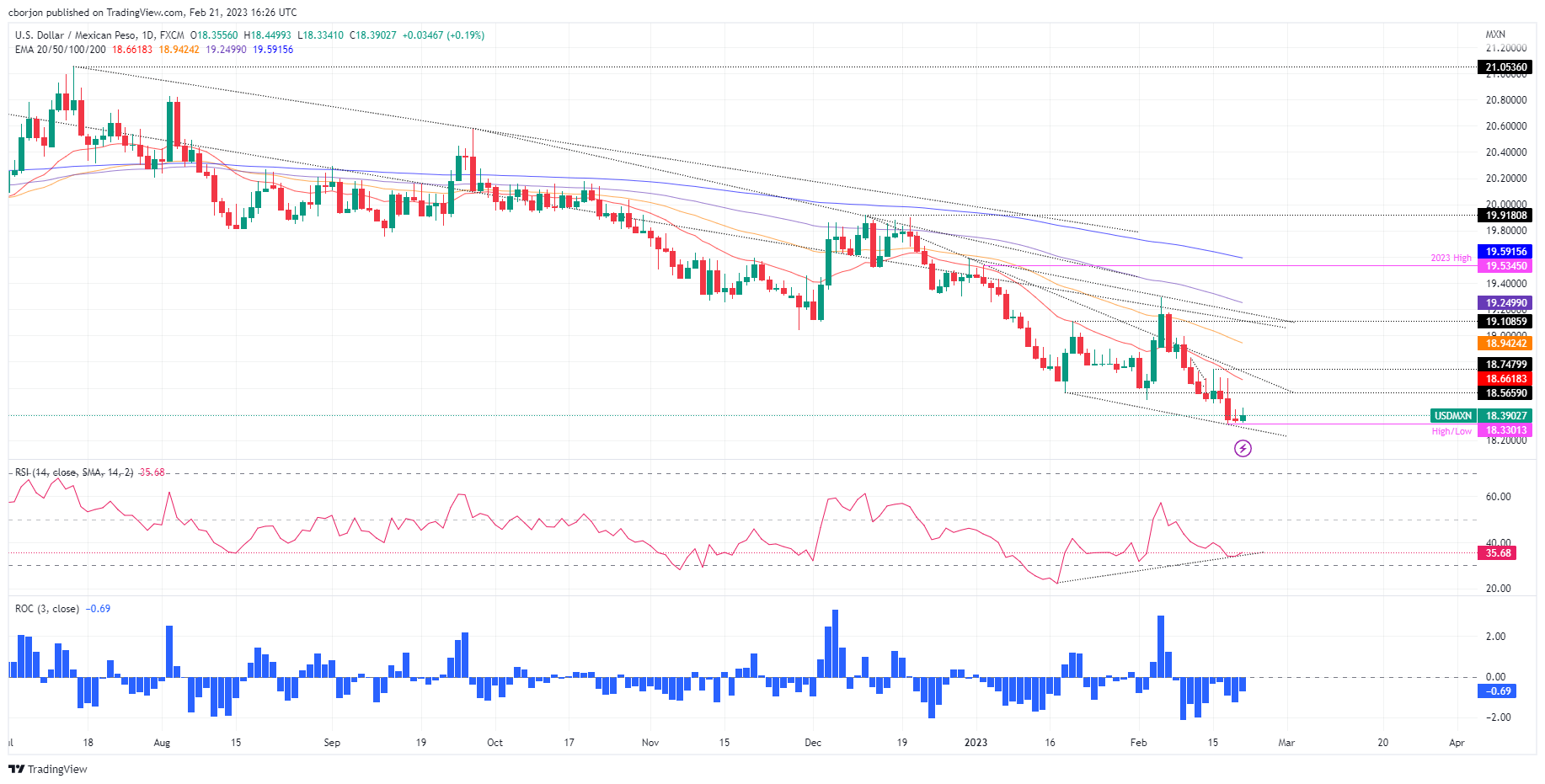
USD/MXN Key technical levels
- Gold price slides after failing to break Monday’s high of 1847.45, down 0.08%.
- US S&P Global PMIs for February were better than expected, except for the Manufacturing Index, which remained in contractionary territory.
- China-US tensions around military aid on Russia dented market mood.
Gold price slides in the North American session while the US Dollar (USD) rises sharply on risk aversion. Expectations that the US Federal Reserve (Fed) would tighten monetary conditions “aggressively” keeps investors uneasy. At the same time, Fed officials hawkish rhetoric added to those speculations, with money market futures expecting rates as high as the 5.25%-5.50% range. The XAU/USD is exchanging hands at around 1838.58.
US business activity in February improved
US equities opened in the red as sentiment remains sour. S&P Global revealed that the US economy in February posted a recovery in business activity, with all the indices above estimates. However, as measured by the S&P Global Manufacturing PMI, manufacturing activity remained at 47.8 in the contractionary territory.
“Despite headwinds from higher interest rates and the cost of living squeeze, the business mood has brightened amid signs that inflation has peaked and recession risks have faded,” said Chris Williamson, a chief business economist at S&P Global Market Intelligence. He added that supply constraints had alleviated delivery times.
US bond yield capped Gold’s advance
The US Dollar Index, a gauge of the buck’s value vs. a basket of currencies, began to trim some of its earlier gains following the release of the PMI report, after hitting a daily high of 104.260, it’s down 0.12% at 103.878. Contrarily, the US 10-year benchmark note rate sits at 3.908%, gains six bps, capping the yellow metal rally, with XAU’s bulls eyeing a test of the $1850 area.
Geopolitical-wise, the US Secretary of State Anthony Blinken warned China not to provide further lethal military help to Russia in its invasion of Ukraine, adding that “serious consequences” would happen if it did so. In the meantime, US President Joe Biden visited Ukraine’s President Zelenskyy in Kyev, showing US support after Blinken’s comments.
What to watch?
Aside from this, Wednesday’s US economic docket will feature the latest FOMC meeting minutes, which could shed some light regarding the forward path that the US Federal Reserve would follow in monetary policy.
Gold technical analysis
XAU/USD’s daily chart suggests the yellow metal as neutral biased. It should be said that if XAU/USD does not print a new high in the week, that could pave the way for further downside. Oscillator-wise, the path of least resistance is downwards, with the Relative Strength Index (RSI) in bearish territory aiming south, while the Rate of Change (RoC) displays buying pressure is fading.
Therefore, the XAU/USD first support would be the 100-day Exponential Moving Average (EMA) at $1820.45, followed the last week’s low of $1818.97. A breach of the latter will expose the $1800 mark.
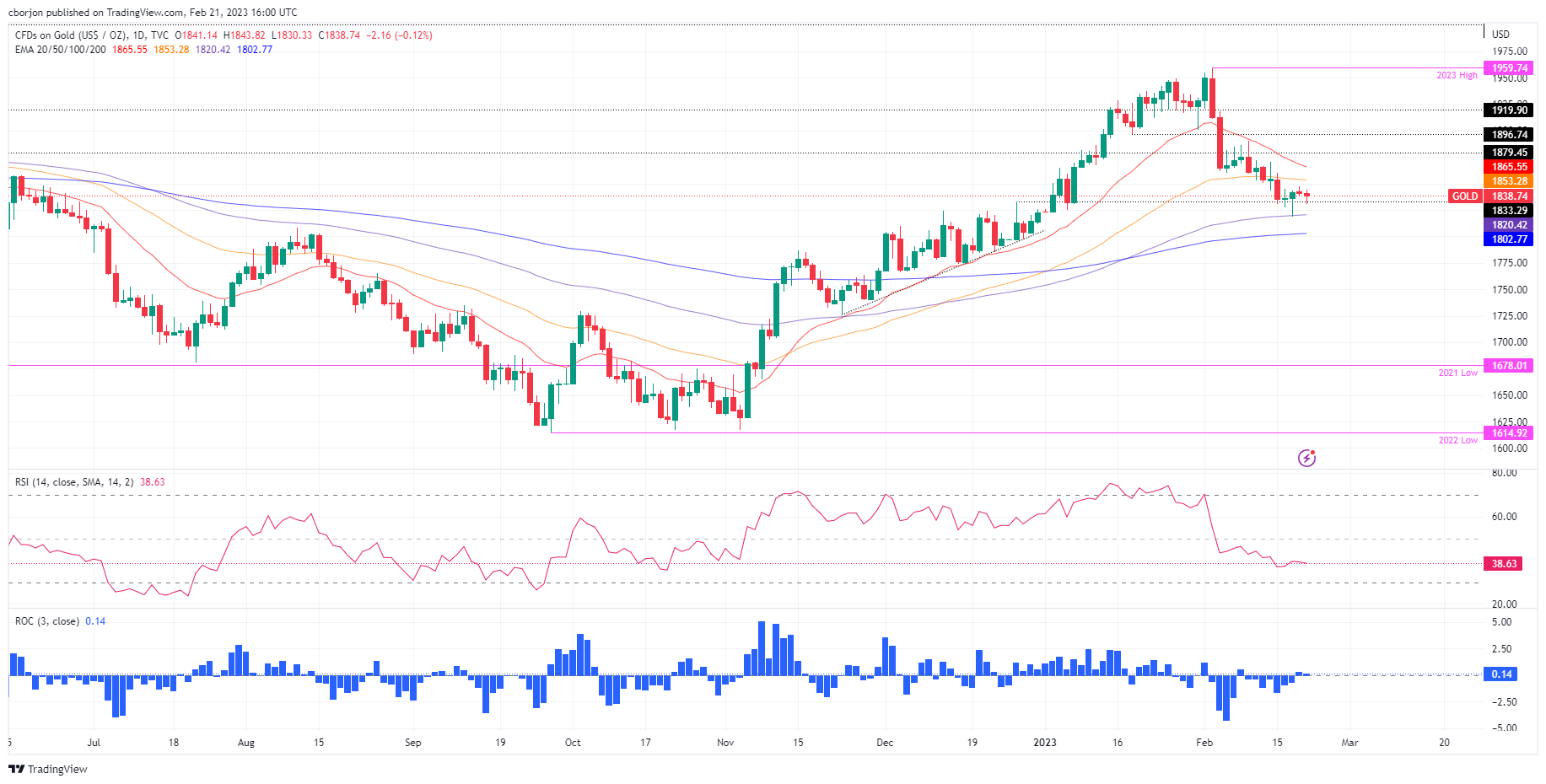
Is there a buying opportunity in Gold after the recent drop? XAU/USD is starting to look oversold. Therefore, strategists at Standard Chartered recommend adding exposure to the yellow metal.
Subsequent support levels for XAU/USD are at $1,810, followed by $1,780
“Gold broke below a strong support level at $1,840; the next support is at $1,810, followed by $1,780.”
“We would gradually add exposure to Gold (especially those who are underinvested), given that XAU/USD is starting to look oversold. Moreover, central bank demand remains strong and we expect that to continue supporting Gold prices.”
“The rebound in real yields and the USD is likely to level off, in our view, fading headwinds against Gold. The bright metal can also serve as an attractive hedge against short-term volatility due to geopolitical tensions.”
Economists at ING expect a hawkish 50 bps RBNZ hike, which could lift the New Zealand Dollar, but dovish risks have risen.
Watch the cyclone risk
“We are aligned with the consensus call for a 50 bps rate hike.”
“There is one key risk to our call though: the impact of the cyclone in New Zealand. This has triggered growing speculation that the RBNZ will only hike by 25 bps or even pause, and is probably behind the drop in NZD/USD to 0.6200. Admittedly, this downside risk has become more material now, but we stick to our call for a hawkish 50 bps hike by the RBNZ, and we think this will lift the New Zealand Dollar tomorrow.”
“However, we think this may be one of the last times the RBNZ has a direct positive impact on NZD as many factors suggest a dovish pivot will come soon.”
See – RBNZ Preview: Forecasts from six major banks, 50 bps seems appropriate
European Central Bank President Christine Lagarde said on Tuesday that they are not seeing a wage-price spiral in the Eurozone and explained that wage growth is a part of 'catching up,' as reported by Reuters.
Lagarde further noted that the headline inflation has begun to slowdown but reiterated that they intend to raise the key rates by 50 basis points at the upcoming policy meeting.
Market reaction
These comments don't seem to be helping the Euro find demand. As of writing, EUR/USD was down 0.2% on the day at 1.0662.
- Existing Home Sales in the US continued to decline in January.
- US Dollar Index stays in positive territory above 104.00.
Existing Home Sales in the US declined by 0.7% in January to an adjusted annual rate of 4 million, the National Association of Realtors (NAR) reported on Tuesday. This reading came in below the market expectation of 4.1 million.
"The median existing-home sales price increased 1.3% from one year ago to $359,000," the NAR further noted in its publication.
Commenting on the data, “home sales are bottoming out,” said NAR Chief Economist Lawrence Yun. “Prices vary depending on a market’s affordability, with lower-priced regions witnessing modest growth and more expensive regions experiencing declines.”
Market reaction
This data doesn't seem to be having a noticeable impact on the US Dollar's performance against its major rivals. As of writing, the US Dollar Index was up 0.22% on the day at 104.10.
The Mexican Peso is the second-best performing EM currency with a gain of nearly 6% YTD. Analysts at Société Générale ponder the possibility of a move below 18.00 in the USD/MXN pair.
50-DMA near 19.00 set to provide resistance
“Whether USD/MXN has a go at 18.00 is probably down to the FOMC minutes and US PCE.”
“The 50-Day Moving Average near 19.00 is likely to provide resistance.”
“Failure to hold 18.30 can lead to persistence in the decline towards the lower band of a multi-month channel near 18.10 and 17.90/17.60.”
- S&P Global Services PMI recovered above 50 in February's flash estimate.
- US Dollar Index continues to push higher above 104.00.
Business activity in the US services sector expanded in early February following January's contraction with S&P Global Services PMI rising to 50.5 from 46.8 in January. This reading surpassed the market expectation of 47.2.
Additionally, the Manufacturing PMI edged higher to 47.8 from 46.9, compared to analysts' estimate of 47.3, and the Composite PMI improved to 50.2 from 46.8.
Commenting on the data, "February is seeing a welcome steadying of business activity after seven months of decline," said Chris Williamson, Chief Business Economist at S&P Global Market Intelligence.
"The improved supply situation has taken price pressures out of manufacturing supply chains but the survey data underscore how the upward driving force on inflation has now shifted to wages amid the tight labor market," Williamson added. "By potentially stoking concerns over a wageprice spiral, accelerating service sector price growth will add to calls for higher interest rates, which could in turn subdue the nascent expansion."
Market reaction
The US Dollar gathered strength against its rivals with the initial reaction and the US Dollar Index was last seen rising 0.35% on the day at 104.22.
The minutes from the Reserve Bank of Australia's (RBA) February Board meeting were relatively hawkish. Stronger than expected Australian wages could lift the AUD/USD pair towards the 0.70 level, in the view of economists at Commerzbank.
Minutes confirm RBA's hawkish shift
“The minutes of the RBA’s February meeting has confirmed the RBA's renewed hawkish bias. The minutes show that in view of higher-than-expected inflation and wage data, a 50 bps hike was also considered at the last interest rate decision.”
“The focus now turns to the wage index data for Q4 2022 due for release on Wednesday, which, if stronger than expected, underlines the upside risks to the RBA outlook and is likely to push AUD/USD more towards the upside of its current 0.68-0.70 trading range.”
- The index clings to daily gains around the 104.00 hurdle.
- US yields resume the upside and prop up the dollar on Tuesday.
- Advanced PMIs are seen rebounding a tad in February.
The greenback, when measured by the USD Index (DXY), manages well to keep business around the 104.00 neighbourhood on Tuesday, up modestly for the day so far.
USD Index looks bid amidst higher yields
The index keeps the buying interest well in place in the wake of the opening bell in Wall St. on Tuesday, as US markets return to the usual activity following Monday’s holiday.
The move higher in US yields underpins the resumption of the uptrend in the dollar, while the somewhat offered stance in the risk complex also collaborates with the upside pressure in the buck.
In the US data space, the flash Manufacturing PMI is seen at 47.1 in February and 50.5 when it comes to the Services gauge, both prints surpassing estimates and higher than the January readings.
Later in the session, Existing Home Sales for the month of January are due followed by a 3-month/6-month Bill Auctions.
So far, market participants are expected to remain on the cautious side in light of the publication of the FOMC Minutes and the release of inflation figures measured by the PCE on Wednesday and Friday, respectively, all against the backdrop of the persistent broad debate between market expectations of the Fed’s next steps and the hawkish narrative from policy makers.
What to look for around USD
The dollar flirts once again with the key 104.00 zone amidst some tepid weakness in the risk complex as US traders resume the activity on Tuesday.
The probable pivot/impasse in the Fed’s normalization process narrative is expected to remain in the centre of the debate along with the hawkish message from Fed speakers, all after US inflation figures for the month of January showed consumer prices are still elevated, the labour market remains tight and the economy maintains its resilience.
The loss of traction in wage inflation – as per the latest US jobs report - however, seems to lend some support to the view that the Fed’s tightening cycle have started to impact on the still robust US labour markets somewhat.
Key events in the US this week: Flash Manufacturing/Services PMI, Existing Home Sales (Tuesday) – MAB Mortgage Applications, FOMC Minutes (Wednesday) – Advanced Q4 GDP Growth Rate, Initial Jobless Claims, Chicago Fed National Activity Index (Thursday) – PCE, Core PCE, Personal Income/Spending, Final Michigan Consumer Sentiment, New Home Sales (Friday).
Eminent issues on the back boiler: Rising conviction of a soft landing of the US economy. Slower pace of interest rate hikes by the Federal Reserve vs. shrinking odds for a recession in the next months. Fed’s pivot. Geopolitical effervescence vs. Russia and China. US-China trade conflict.
USD Index relevant levels
Now, the index is gaining 0.25% at 104.13 and faces the next hurdle at 104.66 (monthly high February 27) seconded by 105.63 (2023 high January 6) and then 106.44 (200-day SMA). On the other hand, the breach of 102.58 (weekly low February 14) would open the door to 100.82 (2023 low February 2) wand finally 100.00 (psychological level).
Sterling is a notable out-performer on the day, following better-than-expected UK data. Economists at Scotiabank believe that the GBP/USD could extend its rise to the 1.2165/70 zone.
Sterling’s technical condition looks more positive
“A surprise monthly budget surplus added to the lift for the GBP as it casts government finances in a generally more favourable light for the fiscal year overall ahead of next month’s budget. The Chancellor might use some of that unexpected cash to ease the domestic cost of living crunch.”
“The GBP has found support against the 200-DMA (1.1937 today) over the past two weeks and intraday gains through the 1.21 area are bullish from a short-term point of view, setting Cable up for a test of 1.2165/70.”
Economist at UOB Group Lee Sue Ann assesses the prospects for further tightening by the Bank of England.
Key Takeaways
“While the UK economy managed to avert a recession at the end of 2022; the fall in Jan’s PMIs shows the manufacturing sector kicking off 2023 on the back foot, in much the same way as it ended 2022. Consumer confidence is below levels seen during the financial crisis, COVID-19 pandemic, and recessions in both the 1980s and 1990s.”
“The latest jobs numbers suggest that the tight labour market will remain a stubborn source of domestic inflationary pressure for some months. Meanwhile, inflation remains in double digits, five times above the Bank of England (BOE)’s target. And there seems to be little signs that UK wage growth is slowing.”
“We are penciling in 25bps hikes at the next 2 meetings on 23 Mar and 11 May, seeing the Bank Rate peak at 4.5%. We recognize, though, the risks to our forecasts given the BOE’s challenge of fighting inflation amid a difficult economic outlook, as reflected by the range of views on the MPC at their last meeting on 2 Feb.”
EUR/USD continued to trade in a subdued range at the start of the week. Economists at OCBC Bank expect the world’s most popular currency pair to remain confined within 1.0620-1.0720.
Risks remain skewed to the downside
“Risks remain skewed to the downside but the range of 1.0620-1.0720 should hold.”
“Support at 1.0610, 1.05 and 1.0460 (38.2% fibo retracement of September low to February high).”
“Resistance at 1.0730 (50-Day Moving Average) and 1.08 (21-DMA).”
See – EUR/USD: Downside pressure to build on a clear daily close under 1.0680 – Scotiabank
- USD/CAD regains positive traction on Tuesday and is supported by a combination of factors.
- Softer Canadian CPI print, sliding oil prices undermine the Loonie amid modest USD strength.
- Traders now eye US PMIs for some impetus; focus remains on FOMC minutes on Wednesday.
The USD/CAD pair catches fresh bids during the early North American session on Tuesday and spikes to the top end of its daily range in reaction to rather unimpressive Canadian macro data. The pair is currently trading just below the 1.3500 psychological mark, up around 0.30% for the day, and seems poised to appreciate further.
Against the backdrop of weaker crude oil prices, softer Canadian consumer inflation figures weigh on the commodity-linked Loonie and provide a modest lift to the USD/CAD pair. In fact, Statistics Canada reported that the headline CPI rose by 0.5% in January, slightly lower than the 0.6% expected. Adding to this, the yearly rate decelerated more than anticipated, to 5.9% from the 6.3% previous.
Moreover, the Bank of Canada's (BoC) Core CPI, which excludes volatile food and energy prices, also missed estimates and came in at a 5% YoY rate, down from the 5.4% previous. This fuels speculations that the BoC will pause the policy-tightening cycle and overshadows the better-than-expected Canadian monthly Retail Sales figures, which recorded a strong growth of 0.5% in December.
The US Dollar (USD), on the other hand, continues to draw support from rising bets for at least a 25 bps lift-off at the next two FOMC policy meetings in March and May. Apart from this, the prevalent risk-off mood - amid looming recession risks and geopolitical tensions - benefits the safe-haven Greenback and supports prospects for a further appreciating move for the USD/CAD pair.
Next on tap is the US economic docket, featuring the release of the flash PMI prints for February and Existing Home Sales data. This, along with the broader risk sentiment, will influence the USD and provide some impetus to the USD/CAD pair. Apart from this, traders will take cues from oil price dynamics to grab short-term opportunities ahead of the FOMC minutes on Wednesday.
Technical levels to watch
- EUR/USD adds to Monday’s pullback, always below 1.0700.
- Further weakness could retest the monthly low near 1.0610.
EUR/USD keeps the side-lined theme well in place in the lower end of the range in the sub-1.0700 region so far on Tuesday.
If bears push harder, then the pair could confront the next support of note at the February low at 1.0612 (February 17). The breakdown of this level could prompt a potential test of the 2023 low at 1.0481 (January 6) to start shaping up in the short-term horizon.
So far, the bearish sentiment is expected to persist as long as the 3-month resistance line, today just beyond 1.0900 the figure, caps the upside.
In the longer run, the constructive view remains unchanged while above the 200-day SMA, today at 1.0328.
EUR/USD daily chart
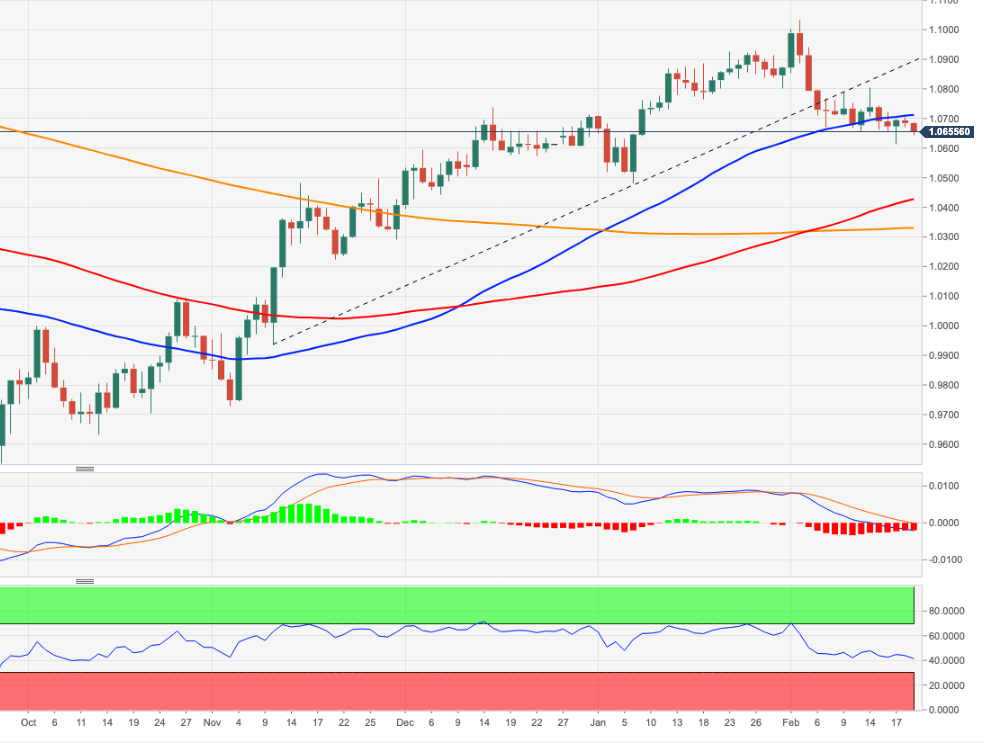
- Retail Sales in Canada increased at a stronger pace than expected in December.
- USD/CAD pushes higher toward 1.3500 in the early American session.
Statistics Canada reported on Tuesday that Retail Sales rose by 0.5% on a monthly basis in December. This reading came in higher than the market expectation for an increase of 0.2%.
"Core retail sales—which exclude gasoline stations and motor vehicle and parts dealers—increased 0.4%," Statistics Canada noted in its publication. "In volume terms, retail sales increased 1.3% in December."
Market reaction
Despite the upbeat data, USD/CAD trades in positive territory and edges higher toward 1.3500 in the early American session. Soft inflation figures from Canada seem to be weighing on the Canadian Dollar.
- Monthly CPI in Canada rose at a softer pace than expected in January.
- USD/CAD rises toward 1.3500 after soft inflation data.
Annual inflation in Canada, as measured by the Consumer Price Index (CPI), declined to 5.9% in January from 6.3% in December. This reading came in below the market expectation of 6.1%. On a monthly basis, CPI rose 05% in January, compared to analysts' estimate of 0.7%.
Additionally, the Bank of Canada's Core CPI, which excludes volatile food and energy prices, dropped to 5% on a yearly basis from 5.4% in December.
Market reaction
USD/CAD pushed higher with the initial reaction and was last seen gaining 0.22% on the day at 1.3480.
- NZD/USD edges lower on Tuesday and is pressured by a combination of factors.
- Hawkish Fed expectations continue to underpin the USD and act as a headwind.
- A weaker risk tone contributes to driving flows away from the risk-sensitive Kiwi.
- Traders now eye US PMIs for some impetus ahead of the RBNZ on Wednesday.
The NZD/USD pair comes under some renewed selling pressure on Tuesday and remains depressed heading into the North American session. Spot prices, however, manage to recover a few pips from the daily low and defend the 0.62000 round-figure mark, at least for the time being.
The US Dollar buying interest remains unabated amid firming expectations for further policy tightening by the Fed, which, in turn, is seen as a key factor weighing on the NZD/USD pair. In fact, the markets seem convinced that the US central bank will stick to its hawkish stance for longer and are pricing in at least a 25 bps lift-off at the next two FOMC meetings in March and May. This, in turn, triggers a fresh leg up in the US Treasury bond yields and continues to underpin the buck.
Meanwhile, worries about economic headwinds stemming from rapidly rising borrowing costs, along with geopolitical tensions, take a toll on the global risk sentiment. This is evident from a generally weaker tone around the equity markets, which further benefits the Greenback's relative safe-haven status and drives flows away from the risk-sensitive Kiwi. The downside for the NZD/USD pair, however, remains limited ahead of the Reserve Bank of New Zealand (RBNZ) meeting on Wednesday.
The RBNZ is expected to hike interest rates by 50 bps, though some investors anticipate a pause in the policy tightening cycle in the wake of severe flooding and cyclone damage. Apart from this, investors will take cues from the accompanying policy statement for clues about the future rate-hike path. The focus will then shift to the FOMC meeting minutes, which will play a key role in influencing the USD price dynamics and help determine the next leg of a directional move for the NZD/USD pair.
Heading into the key central bank event risk, Tuesday's US economic docket - featuring the flash PMI prints and Existing Home Sales data - might provide some impetus to the NZD/USD pair. Apart from this, the broader risk sentiment should allow traders to grab short-term opportunities.
Technical levels to watch
EUR/USD has slipped somewhat intraday. A daily close below the 1.0680 mark would add downside pressure, economists at Scotiabank report.
Intraday gains to remain limited
“EUR/USD drift from resistance around the 1.0700/10 area looks poised to extend a little more.”
“Short-term trend dynamics are EUR-negative and broader price trends are tilting more negative for the EUR below key trend and retracement support at 1.0680.”
“Look for intraday gains to remain limited and for downside pressure on spot to build on a clear daily close under 1.0680.”
- Silver faces rejection near the 100-day SMA and comes under some selling pressure on Tuesday.
- The setup still favours bearish traders and supports prospects for a further depreciating move.
- A sustained strength beyond the $22.55-$22.60 region is needed to negate the bearish outlook.
Silver edges lower on Tuesday and snaps a two-day winning streak, albeit manages to hold above the $21.50 level heading into the North American session.
From a technical perspective, the recent bounce from the YTD low, around the $21.20-$21.15 region set last Friday faltered ahead of the $22.00 mark on Monday. The said handle coincides with the 100-day Simple Moving Average (SMA) support breakpoint and should now act as a pivotal point for the XAG/USD.
Some follow-through buying beyond the $22.15 zone, representing the 38.2% Fibonacci retracement level of the recent rally from October 2022, might prompt some technical buying. The momentum could lift the XAG/USD further, though is more likely to meet with a fresh supply near the $22.55-$22.60 hurdle.
That said, a sustained strength beyond the latter will shift the bias back in favour of bullish traders and pave the way for additional gains. The XAG/USD might then accelerate the positive move to 23.6% Fibo. level, around the $23.00 mark, before climbing to the $23.35-$23.40 strong horizontal resistance.
On the flip side, the 50% Fibo. level, around the $21.35 area, seems to protect the immediate downside ahead of Friday's swing low, around the $21.20-$21.15 zone. Failure to defend the said support levels could make the XAG/USD vulnerable to weaken below the $21.00 mark, towards the $20.60 region.
Given that technical indicators on the daily chart are holding deep in the negative territory, the downward trajectory could get extended further towards challenging the $20.00 psychological mark. The XAG/USD could eventually drop to test the next relevant support near the $19.75-$19.70 horizontal zone.
Silver daily chart
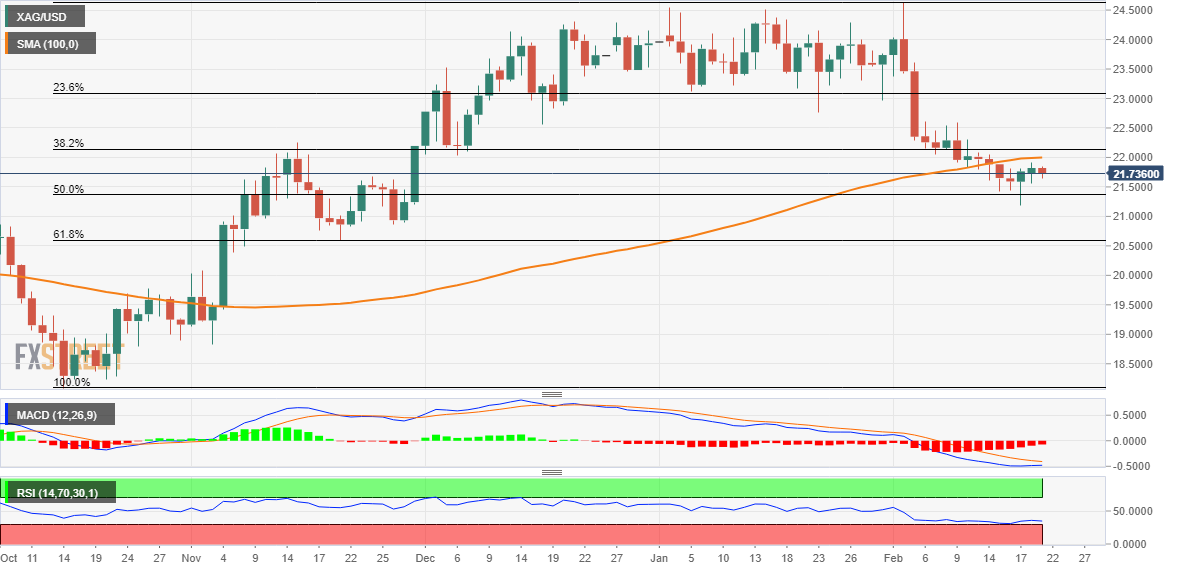
Key levels to watch
UOB Group’s Senior Economist Julia Goh and Economist Loke Siew Ting review the latest trade balance results in Malaysia.
Key Takeaways
“Exports posted the smallest gain since Oct 2020 at 1.6% y/y in Jan (Dec 2022: revised down to +5.9% from +6.0%), undershooting our estimate (+7.5%) and Bloomberg consensus (+9.0%). It also marked the fifth straight month of growth slowdown, in part due to a shorter working month as a result of Chinese New Year celebration. Similarly, import growth dwindled to a 24-month low of 2.3% (UOB est: +10.0%, Bloomberg est: +9.6%, Dec: revised down to +11.5% from +12.0%), leaving a narrower trade surplus of MYR18.2bn last month (Dec: revised up to +MYR28.1bn from +MYR27.8bn).”
“Jan’s export growth surprised on the downside as external demand for both manufactured and agriculture goods declined, which fully offset the impact of higher overseas sales of mining products. Almost all export destinations recorded sluggish performance last month, led by China (-11.9%), the US (-0.6%) and India (-30.6%).”
“We maintain our marginal export growth forecast of 1.5% for this year (MOF est: +2.2%, 2022: +25.0%) given the lingering macro headwinds and year-ago high base effects. Potential spillover effects from China’s economic reopening, Malaysia’s trade diversification and greater access to global markets, as well as commodity price earnings will be wildcards for the country’s export growth outlook this year.”
- The index reverses two consecutive daily pullbacks on Tuesday.
- Further rebound could see the monthly high near 104.70 revisited.
DXY picks up pace and advances to 2-day highs past the 104.00 hurdle on turnaround Tuesday.
The ongoing price action favours some consolidation in the upper end of the range. Immediately to the upside now comes the February top at 104.66 (February 17), while the surpass of this level exposes a probable move to the 2023 high at 105.63 (January 6) in the not-so-distant future.
In the longer run, while below the 200-day SMA at 106.44, the outlook for the index remains negative.
DXY daily chart
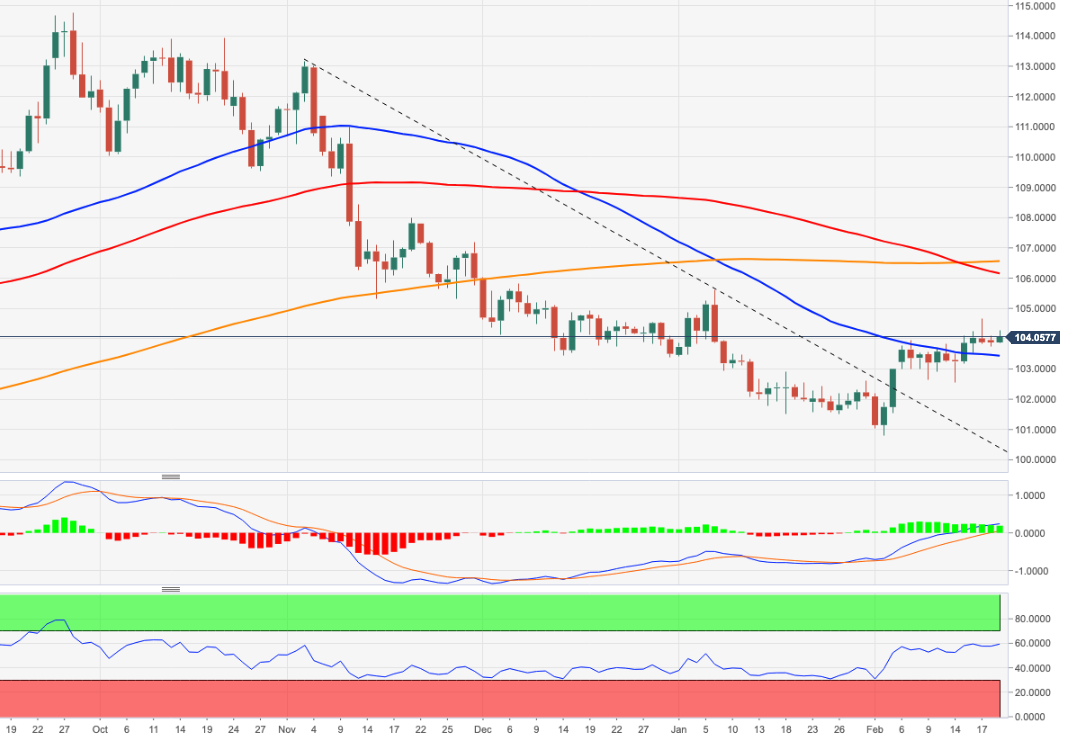
The Canadian Dollar little changed ahead of Consumer Price Index (CPI) data. Strong monthly figures could help the Loonie to cope with USD strength, economists at Scotiabank report.
USD gains should resume above 1.3475/80
“Jan CPI data is forecast to rise 0.6% in the month. Headline inflation is likely to slow somewhat 6.1%, from 6.3%, and core inflation is expected to slow somewhat as well.”
“Strong, monthly gains in prices and still elevated core price pressures will bolster market expectations that the Bank of Canada still might have to tighten monetary policy still further. This should help contain CAD losses against the stronger USD to recent ranges and give the CAD a boost on the crosses.”
“We expect USD support on dips to the low/mid 1.34s.”
“Resistance is 1.3475/80. USD gains should resume above this point.”
See – Canadian CPI Preview: Forecasts from six major banks, downward path could see a minor detour
Canada CPI Overview
Statistics Canada will release the consumer inflation figures for January later during the early North American session on Wednesday, at 13:30 GMT. The headline CPI is expected to rise by 0.7% during the reported month, more than the 0.6% fall in December. The yearly rate, however, is expected to ease to 6.1% from the 6.3% in the previous month. More importantly, the Bank of Canada's (BoC) Core CPI, which excludes volatile food and energy prices, is estimated to rise 0.2% in January and edge higher to 5.5% on a yearly basis as compared to -0.3% and 5.4%, respectively, in December.
Analysts at CIBC offer a brief preview of the key macro data and explain: “A slight rebound in gasoline prices, coupled with a further rapid increase in mortgage interest costs, could have seen prices rise by 0.8% on the month and the annual rate of inflation hold steady at 6.3%. However, further moderation in imported goods prices should mean that core inflation excluding food, energy and mortgage interest likely rose at a monthly pace which is broadly consistent with a 2% inflation target.”
How Could it Affect USD/CAD?
Ahead of the key release, the USD/CAD pair struggles to capitalize on its intraday positive move and once again fails near the 1.3500 psychological mark. A modest recovery in crude oil prices underpins the commodity-linked Loonie and acts as a headwind for the major. A stronger-than-expected Canadian CPI print will be enough to provide a fresh lift to the domestic currency and drag the pair further away from its highest level since January 6 touched last Friday.
Conversely, a weaker-than-expected report should reaffirm market expectations that the BoC will pause the policy-tightening cycle following eight rate hikes in the past 11 months. This, along with the underlying bullish sentiment surrounding the US Dollar, bolstered by bets for additional rate hikes by the Fed and looming recession risks, could boost the USD/CAD pair. Nevertheless, the data is likely to infuse some volatility ahead of the FOMC meeting minutes on Wednesday.
Key Notes
• Canadian CPI Preview: Forecasts from six major banks, downward path could see a minor detour
• USD/CAD Analysis: Setup favours bullish traders ahead of Canadian CPI
• USD/CAD to extend bounce towards December peak of 1.3700 on a move beyond 1.3530 – SocGen
About Canadian CPI
The Consumer Price Index (CPI) released by Statistics Canada is a measure of price movements by the comparison between the retail prices of a representative shopping basket of goods and services. The purchasing power of CAD is dragged down by inflation. The Bank of Canada aims at an inflation range (1%-3%). Generally speaking, a high reading is seen as anticipatory of a rate hike and is positive (or bullish) for the CAD.
NZD/USD is expected to continue its downside movement, in the opinion of economists at OCBC Bank.
Support at 0.6170/85 levels, resistance at 0.6280
“Bearish momentum on daily chart intact while RSI shows signs of falling. Risks remain skewed to the downside for now.”
“Support at 0.6170/85 levels (100, 200-DMAs), 0.6130 (38.2% fibo retracement of October low to Jan-Feb double top) and 0.6010 (50% fibo).”
“Resistance at 0.6280 (23.6% fibo), 0.6360 (21, 50-DMAs).”
See – RBNZ Preview: Forecasts from six major banks, 50 bps seems appropriate
A drop below 6.8490 should be indicative that a visit to 6.9000 in USD/CNH could be running out of steam in the near term, comment Markets Strategist Quek Ser Leang and Senior FX Strategist Peter Chia at UOB Group.
Key Quotes
24-hour view: “We expected USD to trade sideways between 6.8650 and 6.8880 yesterday. However, USD dropped to a low of 6.8548 before settling at 6.8586 (-0.18%). Despite the drop, there is no marked increase in downward momentum and USD is unlikely to weaken much further. Today, USD is more likely to trade in a range, expected to be between 6.8530 and 6.8800.”
Next 1-3 weeks: “We have expected USD to strengthen since early this month. After USD exceeded our previous target of 6.8800, we highlighted last Friday (17 Feb, spot at 6.8780) that ‘the outlook for USD remains positive and the focus is at 6.9000’. Since then, USD has not been able to make any headway on the upside. Upward pressure has waned somewhat but only a break of 6.8480 (no change in ‘strong support’ level) would indicate that USD is not advancing further to 6.9000.”
Gold price is falling towards the $1,830 mark. Tomorrow, the release of the minutes of the February 1 FOMC meeting is unlikely to provide fresh trade impetus, in the opinion of economists at Commerzbank.
Demand picks up in China and India following slide in Gold
“Market participants will be focusing on tomorrow’s publication of the minutes of the Fed’s meeting in early February. As it took place before the buoyant US labour market and inflation data that led to interest rate expectations being reassessed on the market, however, the significance of the minutes is likely to be limited.”
“Price slide seems to have pushed up Gold demand in India and China last week. The higher demand is meeting with reduced supply after Fold imports were postponed in anticipation of a possible cut in import tax that did not then materialise.
“Jewellery retailers there are replenishing their stocks following the New Year festivities. This reveals yet again how price sensitive Gold buyers are in India and China. Though this does not mean that they are able to drive prices significantly up, they can preclude or at least slow any further price fall.”
Canada will release inflation figures at 13:30 GMT. Economists at Société Générale highlight the key technical levels to watch in the USD/CAD pair.
1.3260/1.3220 is likely to be an important support
“CPI in Canada could be a mover today after the towering employment gains. A stronger inflation outcome could pile pressure on the BoC to delay the pause and raise rates again in March.”
“USD/CAD is facing interim hurdle at 1.3530 representing the 61.8% retracement from December.”
“An initial pullback is not ruled out however the ascending trend line drawn since last June at 1.3260/1.3220 which is now also the 200-DMA is likely to be an important support.”
“A move beyond 1.3530 can result in an extended bounce towards December peak of 1.3700.”
See – Canadian CPI Preview: Forecasts from six major banks, downward path could see a minor detour
- EUR/JPY clinches new 2023 peaks around 144.00 on Tuesday.
- The continuation of the uptrend targets the December 2022 high near 146.70.
EUR/JPY fades the initial bull run to new yearly tops just below the 144.00 mark on Tuesday.
While the cross looks somewhat side-lined for the time being, a convincing breakout of the 2023 high at 143.99 (February 21) could trigger a move higher to, initially, the December 2022 peak at 146.72 (December 15).
In the meantime, while above the 200-day SMA, today at 141.29, the outlook for the cross is expected to remain positive.
EUR/JPY daily chart
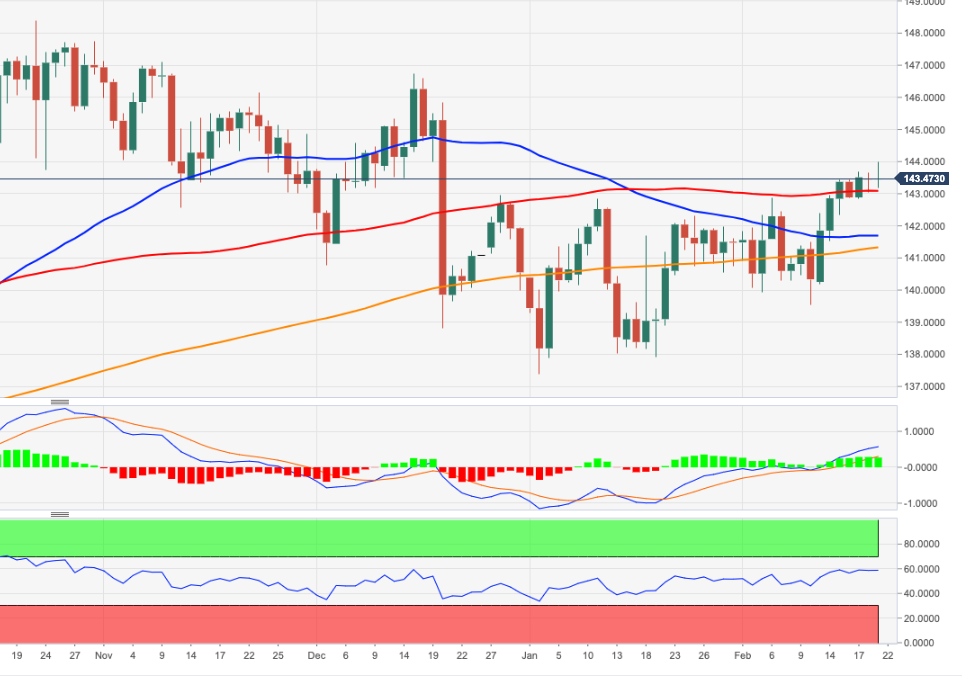
With the Fed's hawkish rate repricing having gone a long way, economists at ING suspect the USD rally may soon run out of steam, even though risk-off may delay a downtrend.
Supported by risk-off mood, but rally looks tired
“This could be the week where the Dollar rally starts losing some steam. The main reason for this is that the recent hawkish rhetoric and strong data have likely been absorbed by now and a further hawkish repricing in Fed rate expectations (currently embedding a 5.40/45% peak rate) is looking increasingly harder.”
“We think that at this stage, it may be mostly down to external factors – like news from Ukraine/China or a general deterioration in risk sentiment – to push the Dollar even higher.”
“Still, signs of deterioration in the global risk sentiment this morning suggest today might not be the day for the start of a Dollar downtrend, but – equally – we struggle to see DXY extend the recent rally to 105.00 and we could instead witness the start of a decline again towards 102.50-103.00 in the coming days.”
USD/JPY could likely embark on further consolidation ahead of potential extra gains in the next few weeks, note Markets Strategist Quek Ser Leang and Senior FX Strategist Peter Chia at UOB Group.
Key Quotes
24-hour view: “Yesterday, USD traded between 133.91 and 134.54, narrower than our expected sideways trading range of 133.80/134.80. Further sideways trading appears likely, even though the slightly firmed underlying tone suggests a higher range of 134.00/134.80.”
Next 1-3 weeks: “We continue to hold the same view as yesterday (20 Feb, spot at 134.35). As highlighted, USD could consolidate for a couple of days before heading higher to the next target at 135.50. On the downside, a break of 133.30 (‘strong support’ level was at 133.10 yesterday) would indicate that the USD strength that started in the middle of last week has come to an end.”
The government is hoping to reach a compromise this week about the Northern Ireland Protocol. Still, economists at Commerzbank stick to their GBP sceptical view.
Brexit, once again
“An agreement is unlikely to have an immediate effect on the economic outlook of the UK. An end of the conflict is likely to normalise the relations between the trade partners and pave the way for a closer cooperation in other areas (such as science and security). However, for the GBP outlook to improve on a sustainable basis, the economic inefficiencies caused by Brexit will have to be resolved.”
“The resistance from within the Tory party against any sort of Northern Ireland compromise seems to suggest though that even amongst government members there is insufficient backing for an ambitious economic agenda. For example, it is still planned to transfer any retained EU legislation to the British statute books. A mammoth task which will cause legal uncertainty and further potential inefficiency according to industry representatives. We therefore stick to our GBP sceptical view.”
- GBP/USD witnessed a dramatic intraday turnaround from sub-1.2000 levels on Tuesday.
- The upbeat UK PMI prints boost the Sterling and prompt an aggressive short-covering move.
- Hawkish Fed expectations, a softer risk tone underpins the USD and caps any further gains.
The GBP/USD pair reverses an early European session dip to levels just below the 1.2000 psychological mark and rallies over 125 pips from the daily low. Spot prices turn positive for the third straight day and climb beyond the 1.2100 round figure, hitting a four-day high in the last hour.
The British Pound strengthens across the board in reaction to the better-than-expected UK PMI prints and prompts aggressive short-covering around the GBP/USD pair. In fact, S&P Global's flash UK Manufacturing PMI unexpectedly improved to 49.2 in February from 47.0 in the previous month. Adding to this, the gauge for the UK services sector returns to expansion territory and jumps to 53.3 during the reported month, squashing the recession narrative and boosting the Sterling.
That said, expectations that the Bank of England's (BoE) current rate-hiking cycle is nearing the end, along with sustained US Dollar buying, act as a headwind for the GBP/USD pair. Firming expectations that the Fed will stick to its hawkish stance trigger a fresh leg up in the US Treasury bond yields and underpin the buck. Apart from this, a generally weaker tone around the equity markets further benefits the Greenback's relative safe-haven status against its British counterpart.
Hence, it will be prudent to wait for strong follow-through buying before placing fresh bullish bets around the GBP/USD pair and positioning for an extension of the recent bounce from the 1.1915 area, or the lowest level since January 6 touched last Friday. Market participants now look forward to the flash US PMI prints and Existing Home Sales. This, along with the US bond yields and the broader risk sentiment, will drive the USD demand and provide some impetus to the major.
Technical levels to watch
NZD/USD has slipped firmly toward 0.6200. RBNZ hogs limelight but economists at ANZ Bank highlight some factors that could strengthen the Kiwi.
Kiwi’s immediate future will depend on what the RBNZ does
“The Kiwi held fairly steady, with US markets closed for Presidents’ Day and markets awaiting tomorrow’s RBNZ decision. On the latter, market expectations seem to have swung slightly away from arguments to go easy post-cyclone and back toward the economic arguments to press ahead with hikes.”
“The Kiwi’s immediate future will depend on what the RBNZ do, but as markets contemplate the cost of rebuilding and the impact that’s likely to have on inflation, insurance flows and infrastructure spending, it’s quickly becoming a potential driver of sustained NZD strength – more than we thought just a few days ago.”
See – RBNZ Preview: Forecasts from six major banks, 50 bps seems appropriate
Yesterday's inflation surprise in Sweden dragged the EUR/SEK pair down. Nonetheless, economists at ING believe that a sustainable move below 11.00 still looks premature.
Activity data and outcome of wage negotiations can still generate significant SEK volatility
“Yesterday’s core CPIF inflation print came in hotter than expected at 8.7%, and EUR/SEK dropped on expectations of more Riksbank tightening. While this fits our view for a recovery in the Krona over the course of the year, we warn against celebrating too early. Remember that the slump in SEK was originally triggered by concerns about the Swedish economic and housing situation, and while more Riksbank tightening helps SEK in the near term, it raises the risks of a black-swan scenario materialising down the road.”
“We think activity data and the outcome of wage negotiations can still generate significant volatility in the Krona, and a sustainable move below 11.00 in EUR/SEK still looks premature.”
US Deputy Treasury Secretary Wally Adeyemo said on Tuesday, “US and allies plan new sanctions this week to continue to isolate Russia over the war in Ukraine.”
Additional quotes
US plans to crack down on Russia's use of dual-use goods, trans-shipment through bordering countries
US. and allies will cut off companies and banks doing business with Russia from western markets and financial systems
Will act against intermediaries helping Russia evade G7 oil price cap.
US concerned about deepening Russia-China ties, but beijing can't supply advanced semiconductors moscow needs
US to tell Chinese firms, financial institutions they face sanctions if they materially support Russia.
Market reaction
Amidst escalating geopolitical tensions surrounding the Rusisa-Ukraine war, markets continue to sell risk, reflective of the 0.65% drop in the US S&P 500 futures. The safe-haven US Dollar is holding the upside just above 104.00 against its major peers.
- Economic sentiment in Germany and the Eurozone improved further in February.
- EUR/USD remains uninspired by the upbeat ZEW surveys, holding lower ground around 1.0660.
The German ZEW headline number showed that the Economic Sentiment Index improved further, arriving at 28.1 in February from 16.9 in January, beating the market expectation of 22.0.
Meanwhile, the Current Situation Index came in at -45.1 from -58.6 but outpaced the market expectation of -50.0
During the same period, the ZEW Economic Sentiment Index for the Eurozone jumped to 29.7 from 16.7.
Key points
A large fraction of the survey participants expects the economic situation to improve in six months’ time.
Current situation is still assessed as relatively unfavourable.
As in the previous month, the increase in expectations can be traced back to higher profit expectations in the energy- and export-oriented sectors as well as the consumer-related parts of the economy.
Expectations for longterm interest rates are also rising and the banking sector indicator has reached its highest level since 2004.
Market reaction
The EUR/USD pair is uninspired by the upbeat data, keeping its range near 1.0660, down 0.22% on the day.
Today’s inflation data from Canada poses few risks for the Loonie, in the opinion of economists at Commerzbank.
Threat of a rate pause
“Consensus expects a small fall in the rate of inflation. A result in line with expectations or below is likely to support the case for a rate pause to assess how the real economy has absorbed the tightening so far.”
“A surprise on the upside would cause doubts in the rate pause and support the expectation that the rate pause will be short-lived. As a result, the Loonie could even appreciate.”
“Already now the swap market is pricing in a high likelihood of a further rate hike in the summer. The risk that the BoC will stick to the rate pause if it emerges that inflation is more stubborn than expected is clearly seen to be smaller. That limits the Loonie’s downside potential.”
See – Canadian CPI Preview: Forecasts from six major banks, downward path could see a minor detour
Russian President Vladimir Putin is delivering his state of the nation address to Russia’s Federal Assembly, addressing both houses of parliament.
Key quotes
Russian economy shrank by 2.1% in 2022.
Russian business has rebuilt logistics.
We will continue working with our partners on new settlement systems.
It's not us who cut settlements in dollars, they do it with their own hands.
We have everything to provide security and sustainable development of our country.
We will be able to export 55-60 mln t of grain.
I am sure we have possibility for breakthrough in other sectors.
Unemployment is at historic low.
We have new niches after withdrawal of western companies.
Changes of structure of our economy is vital.
Our task is to lead our economy to new frontiers.
We will expand foreign ties, new logistic corridors.
We will develop ports of Black, Azov Seas.
We expect cooperation to enhance with India, Iran, Pakistan.
Market reaction
Risk sentiment continues to remain in a weaker spot while the US Dollar Index clings to recovery gains at around the 104.00 level.
- USD/JPY catches fresh bids on Tuesday amid the prevalent USD buying interests.
- Hawkish Fed expectations push the US bond yields higher and underpin the buck.
- Recession fears, geopolitical risks benefit the safe-haven JPY and cap the upside.
The USD/JPY pair regains positive traction on Tuesday and maintains its bid tone through the first half of the European session. The pair steadily climbs back closer to the 135.00 psychological mark and moves well within the striking distance of a nearly two-month high touched last Friday.
The US Dollar buying remains unabated amid firming expectations for further policy tightening by the Fed and turns out to be a key factor acting as a tailwind for the USD/JPY pair. In fact, the markets have been pricing in at least a 25 bps lift-off at each of the next two FOMC meetings in March and May in the wake of stubbornly high inflation. This, in turn, triggers a fresh leg up in the US Treasury bond yields and continues to underpin the Greenback.
The Japanese Yen (JPY), on the other hand, is weighed down by the disappointing release of the flash Manufacturing PMI from Japan, which fell more than expected to 47.4 in February. That said, a rise in the service sector activity, along with a generally softer risk tone, lend some support to the safe-haven JPY and cap gains for the USD/JPY pair. The market sentiment remains fragile amid looming recession risks and fresh geopolitical tensions.
In the latest developments, North Korea launched two more ballistic missiles off its east coast on Monday after firing an intercontinental ballistic missile (ICBM) into the sea off Japan's west coast over the weekend. Furthermore, talks of Russia ramping up attacks in Ukraine temper investors' appetite for riskier assets. Traders also seem reluctant ahead of the newly nominated head of the Bank of Japan (BoJ) Governor Kazuo Ueda's testimony on Friday.
In the meantime, the FOMC meeting minutes, due for release on Wednesday, will be looked upon for fresh clues about the US central bank's rate-hike path. This will play a key role in influencing the near-term USD price dynamics and help determine the next leg of a directional move for the USD/JPY pair. Ahead of the key event risks, the flash US PMI prints might produce short-term opportunities later during the early North American session this Tuesday.
Technical levels to watch
- UK Manufacturing PMI improves to 49.2 in February, a big beat.
- Services PMI in the UK comes in at 53.3 in February, a positive surprise.
- GBP/USD jumps to test daily highs near 1.2075 on encouraging UK PMIs.
The seasonally adjusted S&P Global/CIPS UK Manufacturing Purchasing Managers’ Index (PMI) unexpectedly improved to 49.2 in February versus 46.8 expected and, January’s 47.0 final readout.
Meanwhile, the Preliminary UK Services Business Activity Index for February jumped to 53.3 as against January’s 48.7 final print and 48.3 expected.
Chris Williamson, Chief Business Economist at S&P Global, commented on the survey
“Much better than anticipated PMI data for February indicate encouraging resilience of the economy in the face of headwinds which include rising interest rates, the ongoing cost of living crisis, labor shortages and strikes.”
“While many companies continue to report tough operating conditions, especially in the manufacturing sector, the broader business mood has been buoyed by signs of inflation peaking, supply chains improving and recession risks easing. The stress created by last autumn's mini-budget is also continuing to work its way out of the financial system.”
FX implications
The unexpected improvement in the UK Manufacturing and Services PMI has a positive impact on the GBP/USD pair. The spot is adding 0.29% on the day to trade at daily highs near 1.2075.
The Reserve Bank of New Zealand (RBNZ) will announce its monetary policy decision on Wednesday, February 22 at 01:00 GMT and as we get closer to the release time, here are the expectations as forecast by the economists and researchers of six major banks.
RBNZ is expected to raise the key Official Cash Rate (OCR) by 50 basis points from 4.25% to 4.75%. The recent floods will certainly complicate the RBNZ’s job.
ANZ
“We expect the RBNZ will raise the OCR 50 bps to 4.75%. In terms of alternatives, a 75 bps hike is more likely than 25 bps. On balance, local data since the November MPS have pointed towards inflation pressures not being quite as bad as the RBNZ assumed. But inflation pressures are far too strong, and we are certainly not expecting the RBNZ to go ‘soft’. A hawkish tone is likely, along with only a marginally lower OCR track, if it’s lowered at all. And it’s no small beer for the RBNZ to deliver a double hike when they’ve already raised 400 bps, house prices are down 15% and still falling, and business and consumer confidence are on the floor.”
Westpac
“We expect the RBNZ to lift the OCR by 50 bps to 4.75%. While still a large increase, it’s less than the 75 bps move that the RBNZ seemed to have in mind at its November Monetary Policy Statement. Inflation pressures have remained strong, but not quite to the degree that the RBNZ was bracing for. We expect the OCR to rise further to a peak of 5.25% this year. Borrowers will continue to roll onto higher interest rates for some time to come, even if the OCR is reduced over 2024 as we’re forecasting.”
ING
“We expect the RBNZ to hike rates by 50 bps to 4.75%, in line with market pricing. Peaking inflation and a deteriorating housing market and activity suggest the RBNZ will not reach its projected 5.50% peak rate. A hawkish hike (unchanged projections) should lift NZD, but more NZD strength may soon rely only on external factors.”
TDS
“We expect the RBNZ to hike the OCR by 50 bps to 4.75%. After a historic 75 bps hike at the November meeting, the subsequent inflation and labour market outcomes undershooting RBNZ forecasts support a return to RBNZ hiking in 50 bps clips. The downshift would also be consistent with global central banks stepping down the pace of hikes. New economic projections will accompany the Board's decision with most focus on whether the Bank retains a 5.5% OCR peak by May. We don't think the RBNZ will do many favors for NZD at its February meeting, especially as market pricing looks a bit aggressive.”
Citibank
“Last week the NZ Government declared a nationwide state of emergency for the third time in the country’s history, this time due to Cyclone Gabrielle. The cyclone comes at a time when inflation pressures are acute and against that backdrop, the RBNZ is still likely to increase the OCR but will need to communicate carefully accompanying policy rhetoric. The RBNZ unexpectedly cut the OCR by 50 bps to 2.50% following the Christchurch earthquake rather than keep it steady. Precedent in responding to a natural disaster with a change in policy would suggest that the RBNZ now possibly keep OCR unchanged on February 23 rather than increase it as expected by the market and previously communicated by the RBNZ. Such an outcome may be discussed by the MPC, but in the end, the need to stop the economy overheating will likely force a decision to increase the OCR by 50 bps to 4.75%.”
NAB
“We are holding to our view of a 50 bps hike to 4.75%. As for the forecast track, the RBNZ is also likely to tone down its projected rate peak by 25 bps, to 5.25%, on the grounds of lessening steam in the economy’s broader trajectory, compared to the November MPS. The case for 75 bps has become a harder sell, especially given recent severe weather events.”
- AUD/USD meets with a fresh supply on Tuesday and reverses a major part of the overnight gains.
- Hawkish Fed expectations, recession fears boost the USD and weigh on the risk-sensitive Aussie.
- Hawkish-sounding RBA minutes fail to impress bullish traders or lend any support to the major.
The AUD/USD pair comes under some renewed selling pressure on Tuesday and reverses a major part of the previous day's positive move. The pair remains depressed below the 0.6900 mark through the first half of the European session and for now, seems to have stalled the recent bounce from its lowest level since January 6 touched last Friday.
A combination of factors pushes the US Dollar higher, which, in turn, is seen weighing on the AUD/USD pair. The prospects for further policy tightening by the Federal Reserve trigger a fresh leg up in the US Treasury bond yields and continue to underpin the Greenback. Apart from this, a generally softer tone around the equity markets further benefits the safe-haven buck and drives flows away from the risk-sensitive Aussie.
The markets now seem convinced that the US central bank will stick to its hawkish stance and have been pricing in at least a 25 bps lift-off at the next two FOMC meetings in March and May. The bets were reaffirmed by the US CPI and PPI data last week, which showed that inflation isn't coming down quite as fast as hoped. Furthermore, a slew of FOMC members stressed the need to keep lifting rates gradually to tame inflation.
The market sentiment, meanwhile, remains fragile amid growing worries about economic headwinds stemming from rapidly rising borrowing costs. This, along with geopolitical tensions, take temper investors' appetite for riskier assets. This, to a larger extent, overshadows a more hawkish tilt from the Reserve Bank of Australia (RBA) meeting minutes and does little to impress bullish traders or lend any support to the AUD/USD pair.
In fact, the minutes showed that the Australian central bank had considered raising interest rates by 50 bps during its February meeting, though eventually settled on a 25 bps hike. Furthermore, the board agreed that more interest rate hikes are needed over the coming months to bring down inflation. The AUD/USD pair's inability to attract any buyers suggests that the recent pullback from a multi-month top is far from being over.
Market participants now look to the US economic docket, featuring the release of flash PMI prints and Existing Home Sales data. This, along with the US bond yields and the broader risk sentiment, could influence the USD price dynamics and provide some impetus to the AUD/USD pair. The focus, however, will remain glued to the latest FOMC meeting minutes, which will play a key role in determining the near-term trajectory.
Technical levels to watch
- Rising tensions around the Russian-Ukraine war support the US Dollar in risk-off mood.
- United States trading week opens with February PMI releases on both sides of the pond.
- Gold price traders will scrutinize last Federal Reserve meeting minutes looking for more monetary policy clues.
- PCE disinflation should continue, but any surprise could have a notable impact on Gold.
Gold price is trading once again on the wrong foot on Tuesday, as it trades close to thick support at $1,830-$1,835, the area of the 38.2% Fibonacci retracement of the November'22-January'23 uptrend. The US Dollar market dominance is rising again on the back of growing geopolitical tensions ahead of the one-year anniversary of the Russian invasion of Ukraine and a day after US President Joe Biden made a significant appearance in Kyiv. Russian President Vladimir Putin’s speech on the state of the nation on a busy Tuesday European session could have a significant impact on the market risk sentiment and, therefore, on Gold price.
Gold news: German Manufacturing PMI in the red, Gold price continues downtrend
European trading session has seen the publication of the European S&P Global Purchasing Managers Indexes (PMI) preliminary reports for the month of February. The all-important German Manufacturing PMI came out in the red at 46.5 (vs 47.8 expected), showing that the economic engine of Europe is still weary of high energy prices and inflation as the Russian-Ukraine war continues. Even if the Services and Composite PMIs both for the German and the whole Eurozone economy came out better than expected, Gold price was sold on the release, as US Dollar stays bid across the board.
Markit Economics will also publish the February preliminary releases for the United States S&P Global PMIs in all sectors, expected to come in contraction territory (below 50) across the board, but picking a bit of strength compared to January.
If the S&P Global Services PMI show that rising wages continue to ramp up input price pressures, the US Dollar is likely to preserve its strength and limit the Gold price potential recovery gains. On the other hand, lower-than-expected headline PMI prints combined with a decline in the private sector’s payrolls could weigh on the USD and help XAU/USD edge higher.
Small details in the FOMC Minutes can be market-moving
The Federal Reserve (Fed) will publish the minutes of its last policy meeting on Wednesday at 19:00 GMT, with the whole Federal Open Market Committee (FOMC) assessing the monetary policy. It will be key to see whether some policymakers saw the need for the Fed to reconsider 50 bps rate hikes in case they saw enough evidence to suggest that the slowdown in inflation was temporary. Such a development could revive bets for a 50 bps hike at the next meeting and weigh heavily on Gold price.
If not, markets are unlikely to read too much into the FOMC Minutes ahead of the Fed March meeting, where the revised Summary of Projections will be unveiled.
US PCE disinflation trend to continue
The US Bureau of Economic Analysis (BEA) will publish on Friday at 13:30 GMT the Personal Consumption Expenditures (PCE) Price Index, the Fed’s preferred gauge of inflation. Gold traders and investors will watch the data release closely, as Core PCE inflation is forecast to rise by 0.4% on a monthly basis. Still, the annual figure is expected to decline to 4.1% in January from 4.4% in December. The market reaction should be straightforward, with a softer-than-expected monthly PCE inflation weighing on the US Dollar and vice versa, with Gold price reacting the opposite way.
Considering that the CPI report already revealed that inflation remained sticky in January, it would be surprising to see this data have a long-lasting impact on markets.
Commerzbank lowers mid-year Gold price forecast to $1,800
Strategists at Commerzbank have noticed the correction in Gold price seen over the course of February and have adjusted their mid-year target for the yellow metal down in consequence:
“In response to the Fed’s steeper rate hikes – we now expect rates to peak at 5.5% – we have lowered our forecast of the mid-year Gold price to $1,800 (previously $1,850). A lasting recovery should ensue in the second half of the year, however, as the US economy is then likely to experience a dip that will probably spark renewed expectations of rate cuts. We are therefore sticking with our year-end forecast of $1,950.”
Gold price in 2023: Up-and-down action
Financial markets have been a two-tale story for the early part of 2023, in which Gold price has reflected in its price action like no other asset. XAU/USD rode an uptrend during all of January with the market optimism about inflation slowing down and constant Federal Reserve dovish talk, only to see a drastic turnaround back to the old dynamics in February after a hot US Nonfarm Payrolls (NFP) report. The US economy adding more than 500K jobs in the month of January shifted the market expectations for the Fed easing its monetary policy, and the US Dollar has come back to the market King throne.
Gold price opened the year at $1,823.76 and reached a year-to-date high of $1,960 on February 2, right in between the first Federal Reserve meeting of the year and the surprising release of the US jobs report for January. Since then, the ongoing downtrend has been relentless, reaching levels close to the yearly open, around $1,830.
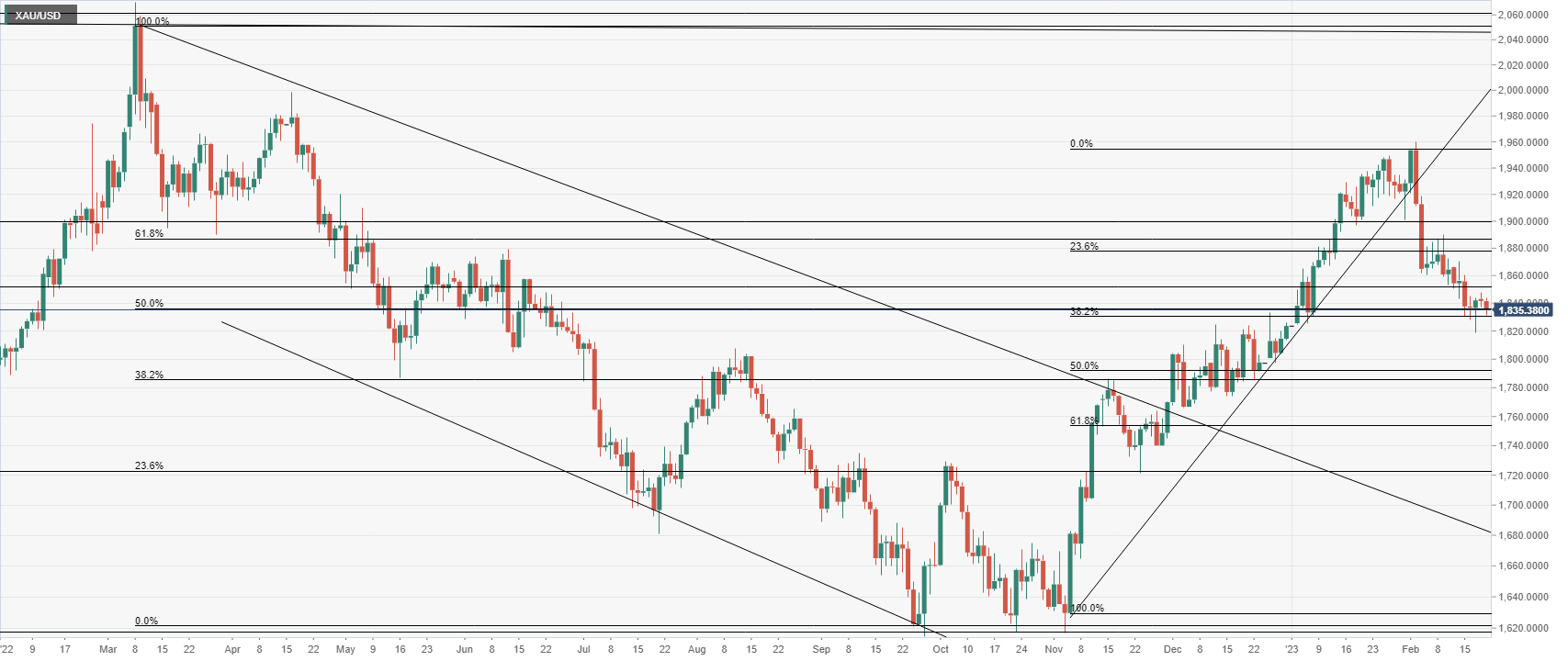
Gold price daily chart
- Eurozone Manufacturing PMI arrives at 48.5 in February vs. 49.3 expected.
- Bloc’s Services PMI rises to 53.0 in February vs. 51.0 expected.
- EUR/USD extends losses toward 1.0650 on the mixed Eurozone PMIs.
The Eurozone manufacturing sector downturn continued in February, the latest manufacturing activity survey from S&P Global research showed on Tuesday.
The Eurozone Manufacturing Purchasing Managers Index (PMI) arrived at 48.5 in February vs. 49.3 expected and 48.8 previous. The index reached a two-month bottom.
The bloc’s Services PMI stood at 53.0 in February vs. 51.0 estimates and January’s 50.8, hitting an eight-month high.
The S&P Global Eurozone PMI Composite jumped to 52.3 in February vs. 50.6 estimated and 50.3 last. The gauge recorded a new nine-month high.
Comments from Chris Williamson, Chief Business Economist at S&P Global
“Business activity across the eurozone grew much faster than expected in February, with growth hitting a nine-month high thanks to resurgent service sector activity and a recovering manufacturing economy. February’s PMI is broadly consistent with GDP rising at a quarterly rate of just under 0.3%.”
“Growth has been buoyed by rising confidence as recession fears fade and inflation shows signs of peaking, though manufacturing has also benefitted from a major improvement in supplier performance.”
FX implications
EUR/USD remains pressured toward 1.0650 following the release of the Eurozone PMIs. The spot is losing 0.16% on the day.
Sweden’s January core inflation surprised on the upside. Thus, economists at Commerzbank expect the Riksbank to deliver more rate hikes, lifting the Krona.
The Riksbank might have to do more
“Even though headline inflation fell slightly more significantly in January to 9.3% the core rate rose to a new high of 8.7%. That means there is broad-based price pressure and it is showing no sign of abating. Against this background the Riksbank’s hawkish February decision, which became obvious once again with the publication of the minutes yesterday, is more than justified.
“It is possible that Riksbank will have to do even more, especially to control core inflation if it turned out to be too stubborn or risen even further. And particularly because the Riksbank was so hawkish in February it is credible in its fight against inflation so that the likelihood of it actually hiking its key rate above the signalled peak if necessary has risen.”
“Future inflation data will be decisive as to how far the Riksbank will have to move in the end. However, after the February meeting it has become less questionable that it will take all necessary measures. That is why I feel confident in my view that SEK still has some catching up to do and is likely to appreciate.”
The PMIs will be released in the UK this morning as well as in the Eurozone. In the view of economists at ING, the GBP is unlikely to sustainably outperform EUR.
EUR/GBP may stay range-bound or climb gradually
“UK PMIs should continue to fall below the eurozone ones and therefore continue to point to the UK’s relative economic underperformance.”
“Ultimately, we struggle to see the Pound consistently strengthening against the Euro, especially as we expect the Bank of England to deliver only one last 25 bps hike in March, while markets are partly pricing in further tightening after that.
“EUR/GBP may stay range-bound or climb gradually at this stage.”
- EUR/USD adds to the bearish note seen on Monday.
- The greenback starts the week in a firm note.
- Flash PMIs, ZEW Economic Sentiment next of note in the region.
Sellers seem in control of the sentiment around the European currency and drag EUR/USD back to the 1.0670/60 region on Tuesday.
EUR/USD now focuses on data releases, dollar
EUR/USD extends the pessimism seen at the beginning of the week and trades slightly on the defensive on Tuesday on the back of the mild recovery in the greenback, as US markets return to the usual activity following Monday’s holiday.
No news on the macro scenario for the pair, which keeps tracking developments/messages from both the European Central Bank (ECB) and the Federal Reserve when it comes to the next decisions on interest rates, particularly beyond the upcoming March events.
In the calendar, Germany’s flash Manufacturing PMI is expected at 46.5 in February (from 47.3) and the Services PMI is seen at 51.3 (from 50.7). Later in the session, advanced PMIs are also due for the broader euro area followed by the Economic Sentiment tracked by the ZEW Institute in Germany and the Euroland. Earlier in the session, New Car Registrations in the EU expanded 11.3% in the year to January.
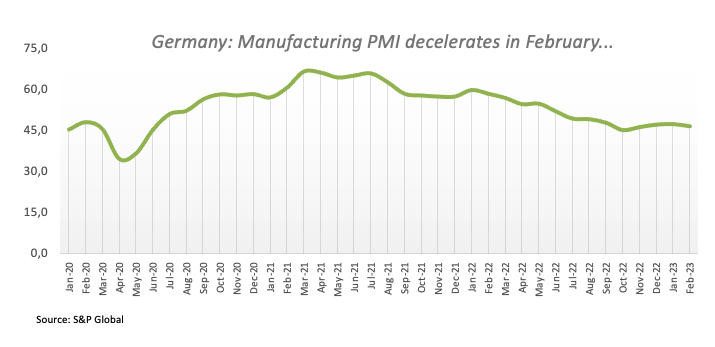
In the US, advanced Manufacturing and Services PMIs are due followed by Existing Home Sales and a 3-month/6-month Bill Auctions.
What to look for around EUR
EUR/USD loses further traction amidst the tepid bounce in the greenback on Tuesday, while the release of key results from fundamentals on both sides of the ocean are expected to grab all the attention.
In the meantime, price action around the European currency should continue to closely follow dollar dynamics, as well as the potential next moves from the ECB after the bank has already anticipated another 50 bps rate raise at the March event.
Back to the euro area, recession concerns now appear to have dwindled, which at the same time remain an important driver sustaining the ongoing recovery in the single currency as well as the hawkish narrative from the ECB.
Key events in the euro area this week: EMU New Car Registrations, EMU/Germany/France Advanced PMIs, Germany ZEW Economic Sentiment (Tuesday) – Germany Final Inflation Rate/IFO Business Climate, France Business Confidence (Wednesday) – EMU Final Inflation Rate (Thursday) – Germany Final Q4 GDP Growth Rate/GfK Consumer Confidence (Friday).
Eminent issues on the back boiler: Continuation of the ECB hiking cycle amidst dwindling bets for a recession in the region and still elevated inflation. Impact of the Russia-Ukraine war on the growth prospects and inflation outlook in the region. Risks of inflation becoming entrenched.
EUR/USD levels to watch
So far, the pair is retreating 0.13% at 1.0670 and a drop below 1.0612 (monthly low February 17) would target 1.0481 (2023 low January 6) en route to 1.0328 (200-day SMA). On the other hand, the next up barrier emerges at 1.0804 (weekly high February 14) seconded by 1.1032 (2023 high February 2) and finally 1.1100 (round level).
- German Manufacturing PMI arrives at 46.5 in February vs. 47.8 expected.
- Services PMI in Germany jumps to 51.3 in February vs. 51.0 expected.
- EUR/USD keeps losses near 1.0670 on mixed German PMIs.
The German manufacturing sector contraction unexpectedly deepened in February even as supply bottlenecks eased rapidly, the preliminary manufacturing activity report from S&P Global/BME research showed this Tuesday.
The Manufacturing PMI in Eurozone’s economic powerhouse came in at 46.5 this month vs. 47.8 expected and 47.3 prior. The index dropped to a new three-month low.
Meanwhile, Services PMI jumped from 50.7 in December to 51.3 in February as against the 51.0 consensus forecast. The PMI hit the highest level in eight months.
The S&P Global/BME Preliminary Germany Composite Output Index arrived at 51.1 in February vs. 50.4 expected and January’s 49.9. The gauge recorded its best level in eight months.
Key comments from Phil Smith, Economics Associate Director at S&P Global
“February’s flash PMI survey showed the German private sector economy return to growth territory for the first time eight months, alongside continued resilience in the labor market and a further slight recovery in business confidence.”
“Encouragingly, the increase in business activity was broad-based by sector. However, whereas the upturn in services activity was at least partly demand-related, higher manufacturing output owed almost exclusively to a substantial easing of supply-chain bottlenecks, which merely allowed goods producers to catch up on backlogs of work.”
FX implications
EUR/USD is keeping its downside momentum intact at around 1.0670 on the mixed German data.
- USD/CAD regains strong positive traction and is supported by a combination of factors.
- Sliding crude oil prices undermines the Loonie and acts as a tailwind amid a stronger USD.
- Traders now look to the Canadian CPI report and the flash US PMIs for a fresh impetus.
The USD/CAD pair attracts fresh buying near the 1.3445-1.3440 horizontal support zone and continues scaling higher through the early part of the European session. Spot prices reverse the previous day's downfall, with bulls now awaiting a sustained move beyond the 1.3500 psychological mark before placing fresh bets.
Crude oil prices come under some renewed selling pressure amid worries that rapidly rising borrowing costs will dampen economic growth and dent fuel demand. This, in turn, weighs on the commodity-linked Loonie, which, along with sustained US Dollar buying, provides a goodish lift to the USD/CAD pair and remains supportive of the intraday positive move.
The USD remains well within the striking distance of a six-week high touched last Friday and continues to draw support from expectations that the Fed will stick to its hawkish stance. In fact, the markets are pricing in at least a 25 bps lift-off at the next two FOMC meetings in March and May, which pushes the US Treasury bond yields higher and underpins the buck.
Apart from this, the cautious market mood - amid looming recession risks and geopolitical tensions - further benefits the Greenback's relative safe-haven status. The USD/CAD pair, however, remains below the 1.3500 mark as traders seem reluctant ahead of monthly Canadian consumer inflation figures, due for release later during the early North American session.
Traders will take cues from the flash US PMI prints, which, along with the US bond yields and the broader risk sentiment, will drive the USD demand. Apart from this, oil price dynamics should traders to grab short-term opportunities around the USD/CAD pair. The focus, however, will remain glued to the FOMC monetary policy meeting minutes on Wednesday.
Technical levels to watch
It’s PMI day, and economists at ING think the Euro could benefit from the reinforcement of its growth story after a period of few domestic drivers.
A reminder of the improved growth outlook
“The Euro has been left without strong domestic drivers on the data front over the past week, so today’s PMIs will be watched quite closely. Consensus is leaning in favour of some modest improvement in both manufacturing and service gauges, and investors might see this as an opportunity to re-enter strategic medium-term long-EUR positions now that the Dollar correction seems to be losing momentum.”
“Instability in global risk appetite today may delay the beneficial effects on EUR/USD today, but we still see the balance of risks tilted to the upside for EUR/USD in the coming days, and a return to the 1.0750-1.0800 range seems possible.”
In the opinion of Markets Strategist Quek Ser Leang and Senior FX Strategist Peter Chia at UOB Group, NZD/USD could extend the decline once 0.6195 is cleared.
Key Quotes
24-hour view: “We highlighted yesterday that NZD ‘has likely moved into a consolidation phase’ and we expected it to trade between 0.6210 and 0.6260. NZD subsequently traded within a range of 0.6223/0.6263. The underlying tone has firmed somewhat and NZD is likely to edge higher to 0.6275 before the risk of pullback increases. The strong resistance at 0.6300 is unlikely to come under threat. Support is at 0.6235, a break of 0.6215 would indicate that the current mild upward pressure has faded.”
Next 1-3 weeks: “Our update from yesterday (20 Feb, spot at 0.6230) still stands. As highlighted, NZD has to break below 0.6195 within these 1-2 days or the chance for further weakness will diminish quickly. Conversely, a break of 0.6300 (no change in ‘strong resistance’ level) would indicate that the decline in NZD that started late last week has made a bottom at 0.6195.”
The preliminary February PMI surveys are set to gain more market attention as real economy performance will determine the outlook for the Fed but and for the ECB, economists at Commerbank report.
Sideways move in EUR/USD for now
“As Fed and ECB monetary policy are in lockstep a lot is pointing towards a sideways move in EUR/USD for now.”
“Which currency will have a better run medium-term will depend heavily on which central bank will sustain the ‘higher for longer’ for longer. And that will in part depend on the real economic performance of the two economic areas so that the significance of indicators such as the PMI for exchange rates might increase for now.”
- GBP/JPY gains some positive traction on Tuesday, albeit lacks follow-through buying.
- Weaker Japanese Manufacturing PMI undermines the JPY and lends some support.
- Expectations that the BoE rate-hiking cycle is nearing the end cap any further gains.
- Traders also seem reluctant ahead of the nominated BoJ Governor Ueda's testimony.
The GBP/JPY cross edges higher for the third straight day on Tuesday and sticks to its mildly positive bias through the early European session. The cross is currently placed just above the 161.50 area and remains well within the striking distance of a nearly two-month high touched last week.
The Japanese Yen (JPY) weakens a bit in reaction to mixed domestic data and turns out to be a key factor lending some support to the GBP/JPY cross. In fact, the flash Manufacturing PMI fell more-than-expected, to 47.4 in February, offsetting a rise in the service sector activity. That said, looming recession risks, along with geopolitical tensions, help limit losses for the safe-haven JPY.
Apart from this, expectations that the Bank of England's (BoE) current rate-hiking cycle is nearing the end undermines the British Pound and contributes to capping the upside for the GBP/JPY cross. Traders also seem reluctant to place aggressive bets and prefer to wait on the sidelines ahead of the newly nominated head of the Bank of Japan (BoJ) Governor Kazuo Ueda's testimony on Friday.
Market participants will closely scrutinize Ueda's view on the future of yield curve control (YCC) and super-easy monetary policy. This will play a key role in influencing the JPY and provide a fresh directional impetus to the GBP/JPY cross. In the meantime, Tuesday's release of the flash UK PMI prints for February might provide some impetus and allow traders to grab short-term opportunities.
Technical levels to watch
Statistics Canada will release January Consumer Price Index (CPI) data on Tuesday, February 21 at 13:30 and as we get closer to the release time, here are the forecasts by the economists and researchers of six major banks regarding the upcoming Canadian inflation data.
Headline is expected at 6.1% year-on-year vs. 6.3% in December. However, on a monthly basis, it is expected to have risen by 0.7%.
RBC Economics
“Canadian inflation pressures are expected to have lightened up again in January, with headline inflation growing at 6.1%. Core CPI is also expected to have edged lower again, to 5.1% YoY. The Bank of Canada’s preferred CPI trim and median measures are also expected to tick lower. We continue to look for the Bank of Canada to hold rates at current levels.”
TDS
“We look for CPI to decline to 6.0% in January as higher gasoline and food prices drive a 0.6% MoM increase. Mortgage interest costs and rents will remain a key driver for shelter, while household furnishings and clothing should weigh on the headline index. We also look for improvement across core CPI measures, with CPI-trim/median edging 0.2pp lower to 4.95%.”
NBF
“Rising gasoline prices, combined with a strong showing in the services segment, should have contributed to boosting the headline figure. Core goods inflation, on the other hand, should have continued to decelerate, but not enough to prevent the headline index from advancing 0.6% MoM (before adjustments for seasonality). If we’re right, the 12-month rate could still drop three ticks to 6.0%. The annual rate of core measures should have moderated as well, with CPI-trim likely easing from 5.3% to 5.1% and CPI-median moving from 5.4% to 5.2%.”
CIBC
“A slight rebound in gasoline prices, coupled with a further rapid increase in mortgage interest costs, could have seen prices rise by 0.8% on the month and the annual rate of inflation hold steady at 6.3%. However, further moderation in imported goods prices should mean that core inflation excluding food, energy and mortgage interest likely rose at a monthly pace which is broadly consistent with a 2% inflation target.”
Citibank
“Canada CPI NSA MoM (Jan) – Citi: 0.8%, prior: -0.6%; CPI YoY – Citi: 6.3%, prior: 6.3%. The evolution of the core measures will be the most important element of the CPI report. Based on Citi analyst estimates of the monthly profile of core inflation, CPI-trim and CPI-median could drop somewhat this month due to base effects but there are risks of core inflation stabilizing over the summer around a still-too-high 3-4%.”
Wells Fargo
“As the pressure from high energy prices continues to dissipate, we expect headline inflation to have eased further to 6.0% in January. Against a backdrop of improving inflation dynamics, the Bank of Canada (BoC) formally announced an end to its monetary tightening cycle with a final 25 bps hike to 4.50%. In our view, the Bank of Canada will remain on hold for the next few quarters before being among the first to start cutting policy rates. Our forecast sees the BoC beginning its easing cycle in Q4 of this year as recessionary conditions start to crystallize.”
Here is what you need to know on Tuesday, February 21:
Following Monday's subdued action, markets seem to have turned cautious early Tuesday amid escalating geopolitical tensions. S&P Global will release the preliminary February PMI surveys for Germany, the Eurozone, the UK and the US. ZEW Survey from Germany will also be looked upon for fresh impetus. Later in the day, Existing Home Sales will be looked upon for fresh impetus and Bank of Canada will release inflation figures.
Secretary of State Antony Blinken told China’s top diplomat, Wang Yi, at the Munich Security Conference that they had information suggesting that China was planning to provide lethal support to Russia. On the same matter, Russian news outlets reported that Wang Yi was expected to visit Moscow on Tuesday and possibly meet with Russian President Vladimir Putin.
Meanwhile, US President Joe Biden unexpectedly travelled to Kyiv and met with Ukrainian President Volodymyr Zelensky. In a joint press conference afterward, Biden reiterated that the US will continue to support Ukraine in its fight against Russia for as long as it takes and said Russia's war of conquest is failing.
Putin will deliver his state of the nation address to Russia’s Federal Assembly at 0900 GMT and address both houses of parliament, during which he will analyze the international situation following the West's sweeping sanctions against Moscow.
Reflecting the risk-averse market atmosphere, US stock index futures are down between 0.3% and 0.4% early Tuesday. The US Dollar Index, which edged slightly lower on Monday, clings to modest gains at around 104.00 in the European morning.
EUR/USD continues to trade in a narrow channel below 1.0700 on Tuesday. European Central Bank (ECB) Governing Council member Olli Rehn said on Tuesday that it would be appropriate for the ECB to continue to raise rates beyond March. Later in the day, ECB President Christine Lagarde will respond to questions from the Finnish public TV.
GBP/USD stays relatively quiet early Tuesday and continues to fluctuate in a narrow channel above 1.2000. British Foreign Secretary James Cleverly said on Monday that they will have more talks with the EU in the coming days on the Northern Ireland Protocol. Cleverly is expected to address Tory MPs on negotiations on Wednesday.
Bank of Japan Governor Haruhiko Kuroda said early Tuesday that wage growth in Japan will likely accelerate as companies increase pay to compensate households for the higher cost of living, and cope with an intensifying labour shortage. These comments failed to trigger a noticeable market reaction and USD/JPY was last seen trading modestly higher on the day at around 134.50.
Gold price registered small daily gains on Monday but retreated below $1,840 early Tuesday. Following the three-day weekend, the 10-year US Treasury bond yield holds in positive territory at 3.86%, weighing on XAU/USD.
Bitcoin regained its traction on Monday and rose more than 2%. At the time of press, BTC/USD was trading within a touching distance of the key $25,000 level. Ethereum trades at around $1,700 in the European morning after having snapped a two-day losing streak on Monday.
FX option expiries for Feb 21 NY cut at 10:00 Eastern Time, via DTCC, can be found below.
- USD/JPY: USD amounts
- 133.50 300m
- AUD/USD: AUD amounts
- 0.6410 747m
- 0.6730 743m
- NZD/USD: NZD amounts
- 0.5600 450m
- 0.6550 449m
- EUR/GBP retreats from intraday high to extend Friday’s U-turn from two-week high.
- Full market’s return, cautious mood probe Euro bulls ahead of Eurozone ZEW Sentiment data, monthly PMI.
- The British Pound braces for UK PMI amid mixed concerns surrounding Brexit.
EUR/GBP holds lower ground around 0.8870, after recently reversing from the daily top, as bears keep the reins for the third consecutive day to early Tuesday in Europe. In doing so, the cross-currency pair portrays the broad retreat in the Euro, as well as the recovery in the British Pound (GBP), ahead of the key data for the bloc and Britain.
That said, a fresh run-up in the US Treasury bond yields, and the fears emanating from China, North Korea and Russia seemed to have underpinned the market’s rush for the US Dollar as traders from Washington return after a long weekend. As a result, the Euro witnesses a pullback in the demand due to its contrast with the greenback.
It’s worth noting that the recent statistics from the Euro area have been firmer while those from the UK have been mixed, which in turn keeps the pair buyers hopeful ahead of the key numbers. Additionally teasing the EUR/GBP buyers are the hawkish comments from the European Central Bank (ECB) official. That said, ECB governing council member and Finnish central bank Chief Olli Rehn recently said, per Reuters, “ECB should keep raising interest rates beyond March and the rate peak, which should be stuck to for some time, could be reached over the summer.”
On the same line, upbeat prints of Eurozone Consumer Confidence matched the market forecasts of -19 versus -20.9 prior. Further, Germany's Bundesbank released its monthly report and noted that the economic outlook was somewhat brighter with the short-term outlook turning more favorable than seen just a few months ago.
Alternatively, fears of no imminent Brexit deal should have weighed on the British Pound (GBP) as the UK’s Conservative Members of the Parliament (MPs) dislike the deal with the European Union (EU) on Northern Ireland (NI). Some of them are threatening to resign, per The Times, amid fears of the compromised deal. The news also mentioned that UK Prime Minister Rishi Sunak spent notable time in the House of Commons to convince the MPs that no deal had yet been agreed and talks were continuing. “He was told he ‘hasn’t got a hope’ of succeeding without the support of the Democratic Unionist Party,” per The Times.
Amid these plays, stock futures are down and the Treasury bond yields, as well as the US Dollar, are firmer, which in turn weigh on the Euro amid a sluggish start to the key day.
Looking forward, Eurozone ZEW sentiment figures for February will precede the preliminary readings of the bloc’s, as well as the UK’s, Purchasing Managers Index (PMI) data for the said month to direct short-term pair moves. Given the cross-currency pair’s latest retreat, backed by the market speculations that the Euro rally is about to end amid the European Central Bank’s (ECB) inability to offer higher rates, the sellers may keep the reins unless the scheduled data mark any surprise.
Technical analysis
EUR/GBP fades bounce off the 50-day Exponential Moving Average (EMA), around 0.8815 by the press time, which in turn joins bearish MACD signals and failure to cross the 0.8915-10 horizontal hurdle to keep bears hopeful.
Gold price recovery fizzles. Downside remains favored, FXStreet’s Dhwani Mehta reports.
$1,825 support needs to fail
“The critical horizontal trendline support from the January 5 low at $1,825 remains a tough nut to crack for Gold bears. Ahead of that, the $1,830 round figure should be taken out on a sustained basis. Friday’s low of $1,819 will be next on Gold sellers’ radars should the downside gather traction once again.”
“On the other side, any recovery attempts will need to find acceptance above the $1,850 psychological level, above which a fresh run-up toward the flattish 50-Daily Moving Average (DMA) at $1,864 cannot be ruled out. Further, Valentine’s Day at $1,870 will be the next stop for Gold bulls.”
- GBP/USD edges lower on Tuesday and stalls a two-day-old recovery trend from a multi-week low.
- Hawkish Fed expectations, recession fears underpin the safe-haven USD and exert some pressure.
- The technical setup favours bearish traders and supports prospects for a further depreciating move.
The GBP/USD pair comes under some selling pressure on Tuesday and stalls its recent recovery from the 1.1915 area or the lowest level since January 6 touched last week. Spot prices remain on the defensive through the early European session, though manage to hold above the 1.2000 psychological mark, at least for the time being.
The US Dollar continues to draw support from rising bets for further policy tightening by the Fed and looming recession risks. Apart from this, speculations that the Bank of England's (BoE) current rate-hiking cycle might be nearing the end undermine the British Pound and contribute to a mildly offered tone around the GBP/USD pair.
The downside, however, remains cushioned as traders seem reluctant to place aggressive directional bets ahead of the release of the FOMC meeting minutes on Wednesday. Heading into the key event risk, the flash version of the PMI prints from the UK and the US could produce short-term opportunities around the GBP/USD pair on Tuesday.
From a technical perspective, any subsequent downfall is likely to find decent support near the very important 200-day SMA, currently around the 1.1935 region. This is closely followed by last Friday's swing low, around the 1.1915 zone and the 1.1900 mark, which if broken decisively should pave the way for a further depreciating move.
Against the backdrop of the recent failures near the 1.2450 area, which constitute the formation of a bearish double top, the downfall will mark a fresh breakdown. The GBP/USD pair might then accelerate the slide towards the YTD low, around the 1.1840 region touched in January and extend the downward trajectory towards the 1.1800 round figure.
On the flip side, the 1.2050-1.2055 region now seems to have emerged as an immediate hurdle. This is followed by the 1.2070-1.2075 resistance zone and the 1.2100 mark. A sustained strength beyond the latter has the potential to lift the GBP/USD pair beyond the 1.2130-1.2135 barrier, towards the 50-day SMA, currently around the 1.2170 area.
The latter should act as a pivotal point, which if cleared could trigger a near-term short-covering rally. The GBP/USD pair might then reclaim the 1.2200 mark and climb further to the last week's swing high, around the 1.2265-1.2270 region, before aiming to reclaim the 1.2300 round-figure mark.
GBP/USD daily chart
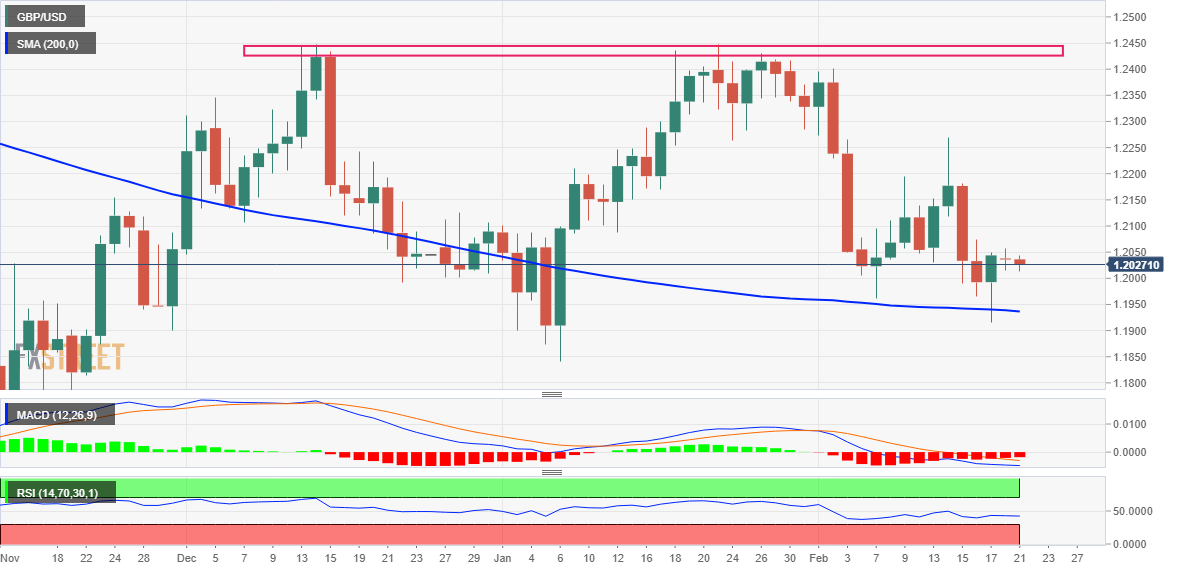
Key levels to watch
GBP/USD risks a potential test of the 1.1900 region in the near term, according to Markets Strategist Quek Ser Leang and Senior FX Strategist Peter Chia at UOB Group.
Key Quotes
24-hour view: “Our expectations for ‘the strong rebound in GBP to extend’ did not materialize as it traded in a quiet manner between 1.2015 and 1.2057 before closing largely unchanged at 1.2040. The price actions appear to be consolidative and GBP is likely to trade in a range today, expected to be between 1.1990 and 1.2060.”
Next 1-3 weeks: “There is not much to add to our update from yesterday (20 Feb, spot at 1.2035). As highlighted, as long as the ‘strong resistance’ at 1.2100 (no change in level from yesterday) is not breached within the next few days, there is still a slim chance for GBP to break below 1.1900. A breach of 1.2100 would indicate that the weakness in GBP that started late last week has come to an end.”
- The index picks up some upside traction near 104.00.
- US markets return to normal activity following Monday’s holiday.
- Flash PMIs, housing data, short-term bill auctions next on tap.
The USD Index (DXY), which gauges the greenback vs. a bundle of its main competitors, trades with decent gains north of the 104.00 barrier on turnaround Tuesday.
USD Index looks to data, risk trends
The index manages to reverse two consecutive daily pullbacks so far on Tuesday and regains the key 104.00 region on the back of the tepid offered stance in the risk-associated universe and a mild uptick in US yields ahead of the opening bell in Euroland.
In the meantime, market participants are expected to remain on the cautious side in light of the publication of the FOMC Minutes and the release of inflation figures measured by the PCE on Wednesday and Friday, respectively, all against the backdrop of the persistent broad debate between market expectations of the Fed’s next steps and the hawkish narrative from policy makers.
In the US data space, advanced Manufacturing and Services PMIs are due seconded by Existing Home Sales and a 3-month/6-month Bill Auctions.
What to look for around USD
The dollar flirts once again with the key 104.00 zone amidst some tepid weakness in the risk complex as US traders resume the activity on Tuesday.
The probable pivot/impasse in the Fed’s normalization process narrative is expected to remain in the centre of the debate along with the hawkish message from Fed speakers, all after US inflation figures for the month of January showed consumer prices are still elevated, the labour market remains tight and the economy maintains its resilience.
The loss of traction in wage inflation – as per the latest US jobs report - however, seems to lend some support to the view that the Fed’s tightening cycle have started to impact on the still robust US labour markets somewhat.
Key events in the US this week: Flash Manufacturing/Services PMI, Existing Home Sales (Tuesday) – MAB Mortgage Applications, FOMC Minutes (Wednesday) – Advanced Q4 GDP Growth Rate, Initial Jobless Claims, Chicago Fed National Activity Index (Thursday) – PCE, Core PCE, Personal Income/Spending, Final Michigan Consumer Sentiment, New Home Sales (Friday).
Eminent issues on the back boiler: Rising conviction of a soft landing of the US economy. Slower pace of interest rate hikes by the Federal Reserve vs. shrinking odds for a recession in the next months. Fed’s pivot. Geopolitical effervescence vs. Russia and China. US-China trade conflict.
USD Index relevant levels
Now, the index is gaining 0.15% at 104.03 and faces the next hurdle at 104.66 (monthly high February 27) seconded by 105.63 (2023 high January 6) and then 106.44 (200-day SMA). On the other hand, the breach of 102.58 (weekly low February 14) would open the door to 100.82 (2023 low February 2) wand finally 100.00 (psychological level).
- USD/JPY sticks to mild gains during three-day winning streak.
- Convergence of 200-day EMA, 13-day-old ascending trend line restricts short-term downside.
- 100-day EMA guards immediate upside near two-month high.
USD/JPY seesaws around intraday high near 134.40 as bulls keep the reins for the third consecutive day amid early Tuesday morning in Europe. In doing so, the Yen pair also prints mild gains near the highest levels in two months, poked on Friday.
That said, the 200-day Exponential Moving Average (EMA) joins an upward-sloping trend line from February 02 to restrict the USD/JPY pair’s immediate downside near 133.80. However, the 100-day EMA level surrounding 134.75 guards nearby the upside.
It’s worth noting, however, that the bullish MACD signals and higher low bullish formation on the daily chart keep the USD/JPY pair buyers hopeful.
That said, the recent top surrounding 135.10, marked on Friday, acts as an extra filter towards the north past 100-day EMA.
Following that, a run-up towards mid-December 2022, close to 138.20, can’t be ruled out. Though, the 140.00 psychological magnet may challenge the Yen pair buyers afterward.
Meanwhile, a downside break of the 133.80 support confluence could quickly drag the USD/JPY price towards an early month swing high near 132.90.
Though, multiple levels near 31.30-20 and the 130.00 round figure could challenge the USD/JPY pair’s downside past 132.90.
In a case where the quote remains bearish below 132.90, the previous monthly low of 127.21 will be in the spotlight.
USD/JPY: Daily chart
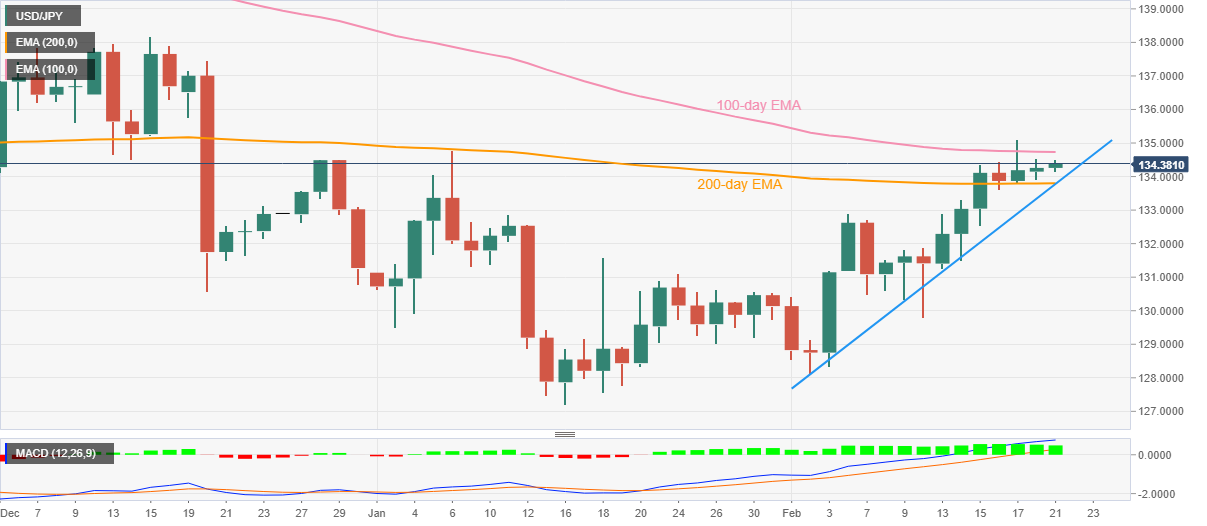
Trend: Further upside expected
Markets Strategist Quek Ser Leang and Senior FX Strategist Peter Chia at UOB Group suggest a sustained decline in EUR/USD has lost impulse as of late.
Key Quotes
24-hour view: “We highlighted yesterday that EUR ‘is unlikely to weaken further’ and we expected it to ‘consolidate within a range of 1.0650/1.0720’. Our view was not wrong even though EUR traded within a narrower range than expected (1.0669/1.0704). The muted price actions offer no fresh clues and EUR could continue to consolidate, likely between 1.0660 and 1.0710.”
Next 1-3 weeks: “We have held a negative view in EUR since last Thursday. After EUR dropped to 1.0611 and rebounded strongly, we indicated yesterday (20 Feb, spot at 1.0685) that that downward momentum has waned somewhat and the likelihood of a sustained decline in EUR below 1.0615 is not high. We continue to hold the same view. Overall, only a breach of 1.0740 (no change in ‘strong resistance’ level from yesterday) would indicate that the current downward pressure has eased. To put it another, a breach of 1.0740 would indicate that EUR could consolidate and range trade for a period of time.”
- NZD/USD has slipped firmly below 0.6240 as the risk-off market mood has strengthened.
- Anxiety among investors is soaring ahead of the opening of the US markets after an extended weekend.
- A promise of a cyclone relief package from NZ Hipkins could propel inflationary pressures further.
The NZD/USD pair has slipped below 0.6240 in the early European session. The Kiwi asset is expected to continue its downside movement as anxiety among investors is soaring ahead of the opening of the US markets after an extended weekend.
S&P500 futures are showing losses as the US markets are yet to show the impact of US-China tensions. Apart from that, missile launching by North Korea on weekend near Japan’s EEC region event will also be discounted by the market participants. The struggle of the US Dollar Index (DXY) for pushing its auction above 103.70 is intact, at the time of writing. Meanwhile, the 10-year US Treasury yields have trimmed some gains and have slipped to near 3.85%.
Investors’ entire focus will remain on the interest rate decision by the Reserve Bank of New Zealand (RBNZ), which is scheduled for Wednesday. February’s monetary policy of RBNZ is extremely important as New Zealand Prime Minister (PM) Chris Hipkins has promised a cyclone relief package of NZ$300 million ($187.08 million).
In times, when the New Zealand economy is struggling to tame galloping inflation, the fresh release of the helicopter money carries the potential of propelling inflationary pressures further. The situation is extremely troublesome for RBNZ Governor Adrian Orr as more rates could impact the economic activities ahead. As per the consensus, the RBNZ is expected to announce a hike in the Official Cash Rate (OCR) by 50 basis points (bps) to 4.75%.
Junichi Ishii, head of the Japanese Parliament’s Upper House steering committee, said on Tuesday that the Upper House will hold a confirmation hearing for the Bank of Japan (BoJ) governor nominee, Kazuo Ueda, on February 27.
Ishii added that the Upper House will hold a confirmation hearing for nominees for BoJ’s two deputy governors on February 28.
Note that the country’s Parliament Lower House is set to hold a confirmation hearing on the government nominees for the Bank of Japan (BoJ) governor and deputies on February 24.
Market reaction
USD/JPY is keeping its rebound intact at around 134.40, adding 0.12% on the day, as of writing.
- Gold bears flirt with intraday low during two-day losing streak, fades Friday’s bounce off seven-week low.
- Sour sentiment, full markets underpin US Dollar rebound and weigh on XAU/USD amid firmer yields.
- Global PMIs, Fed Minutes eyed for clear directions amid bearish bias.
Gold price (XAU/USD) retreats towards the previous weekly low, also the lowest since late December, as risk aversion joins the return of full markets to underpin the US Dollar. Adding strength to the greenback, as well as weighing on the XAU/USD, could be the upbeat US Treasury bond yields.
That said, geopolitical fears surrounding China and Russia seem to propel the latest rush toward risk safety. On the same line are fresh concerns over the Federal Reserve's (Fed) hawkish move, following the strong US data. It’s worth noting, however, that the cautious mood ahead of the preliminary readings of the US Purchasing Managers Index (PMI) data for February seems to challenge the Gold price. Also important is Wednesday’s Federal Open Market Committee’s (FOMC) Monetary Policy Meeting Minutes.
In addition to the cautious mood and fears of higher Fed rate, technical confluence also keeps Gold bears hopeful.
Also read: Gold Price Forecast: XAU/USD sellers lurk at $1,850, downside remains favored
Gold Price: Key levels to watch
The Technical Confluence Detector shows that the Gold price attacks the short-term key support near $1,837, comprising Pivot Point one day S1, 50-HMA and previous lows on the four-hour, one-hour and one-day.
That said, the metal’s latest weakness could be linked to the pullback from another key technical level, namely $1,845 that comprises Fibonacci 61.8% one-day, previous high on four-hour and the upper Bollinger on 15-minutes.
Also acting as a short-term important resistance is the 200-HMA, Pivot Point one-day R2 and Pivot Point one-month S1, close to $1,852.
Meanwhile, the Gold price weakness below the immediate $1,837 support has an open space towards the south unless hitting the previous monthly low surrounding $1,825.
Following that, the previous weekly low and Pivot Point one week S1 could entertain the XAU/USD bears around $1,819-17 before highlighting the $1,800 threshold.
Here is how it looks on the tool
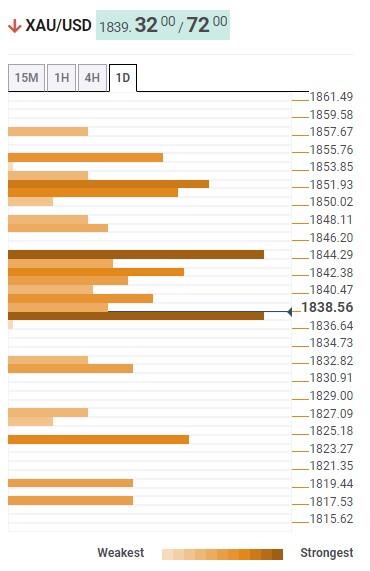
About Technical Confluences Detector
The TCD (Technical Confluences Detector) is a tool to locate and point out those price levels where there is a congestion of indicators, moving averages, Fibonacci levels, Pivot Points, etc. If you are a short-term trader, you will find entry points for counter-trend strategies and hunt a few points at a time. If you are a medium-to-long-term trader, this tool will allow you to know in advance the price levels where a medium-to-long-term trend may stop and rest, where to unwind positions, or where to increase your position size.
- AUD/USD has shifted its auction profile below 0.6900 amid the risk-off mood.
- Federal Reserve policymakers have been citing it would be premature to consider a pause in the policy tightening spell this year.
- Reserve Bank of Australia also considered the option of a 50 bps rate hike as the Australian inflation has not peaked yet.
- AUD/USD has confidently shifted above the neckline of the Head and Shoulder formation, indicating a bullish reversal.
AUD/USD has surrendered the round-level support of 0.6900 in the early European session as investors getting worried that higher interest rates by western central banks are getting nightmares for the producers. The market sentiment is turning risk-averse ahead of the opening of the United States markets after a long weekend.
S&P500 futures have extended their losses as the renewal of higher inflation projections after a significant jump in US Retail Sales has triggered fears of more rate hikes beyond March. The US Dollar Index (DXY) is making deliberate efforts in shifting its auction profile above 103.70. The recovery move by the USD Index in the Asian session was higher confident, however, further range extension is facing pressure.
This week, the show-stopper will be the release of the Federal Open Market Committee (FOMC) minutes, which will release on Wednesday. Investors are expecting a sheer hawkish stance on the interest rate guidance as Federal Reserve (Fed) policymakers have been citing it would be premature considering a pause in the policy tightening spell this year. This has trimmed demand for US government bonds. Lower demand for government bonds has propelled the 10-year yields above 3.85%.
Hawkish Reserve Bank of Australia minutes fail to support the Australian Dollar
It was widely anticipated that Reserve Bank of Australia Governor Philip Lowe and his mates would be advocating for more interest rate hikes as Australian inflation is critically stubborn. The Australian Consumer Price Index (CPI) has refreshed its multi-decade of 7.8% and is showing no signs of softening ahead in spite of the fact that the Official Cash Rate (OCR) has been already pushed to 3.35%.
The message from the RBA minutes was clear that more interest rates are warranted as strong consumer demand is not allowing Australian inflation to soften from its peak.
According to the RBA minutes, policymakers also considered the option of 50 basis points (bps) interest rate hike considering the persistence of inflation. The RBA members also highlighted that the Unemployment Rate is the lowest in the past 50 years and job vacancies are extremely high, which is delighting households for flushing surplus funds into the economy.
Aussie PMI is out, US PMI is due yet
Apart from the hawkish RBA minutes, upbeat preliminary Australian S&P PMI (Feb) data has also failed to strengthen the Australian Dollar. The Manufacturing PMI landed at 50.1, higher than the consensus of 49.9 and the former release of 50.0. The Services PMI scaled firmly to 49.2 versus the estimates of 48.4 and the prior release of 48.6.
Economic activities in the Australian economy are accelerating despite higher interest rates by the Reserve Bank of Australia, which indicates that consumer demand is extremely robust.
In Tuesday’s New York session, preliminary US S&P PMI numbers will be keenly watched. The Manufacturing PMI (Feb) is seen lower at 46.8 vs. the prior release of 46.9. And the Services PMI is seen at 46.6 against the former release of 46.8.
There is no denying the fact that producers have trimmed their dependency on borrowings from commercial banks due to higher interest rates by the Federal Reserve. And are exploiting their retained earnings to avoid higher interest obligations. Firms have postponed their expansion plans, therefore, a continuation of contraction in economic activities is highly expected.
FOMC minutes to guide further movement to the FX market ahead
The minutes from the Federal Reserve will provide a detailed explanation of hiking interest rates by 25 basis points (bps) in the February monetary policy meeting.
The street always tries to remain ahead of the Federal Reserve (Fed) policymakers. Therefore, the major focal point for investors in the Federal Open Market Committee (FOMC) minutes is the meaningful cues that could provide guidance on interest rates. Information on the terminal rate and targets for inflation will be keenly watched.
AUD/USD technical outlook
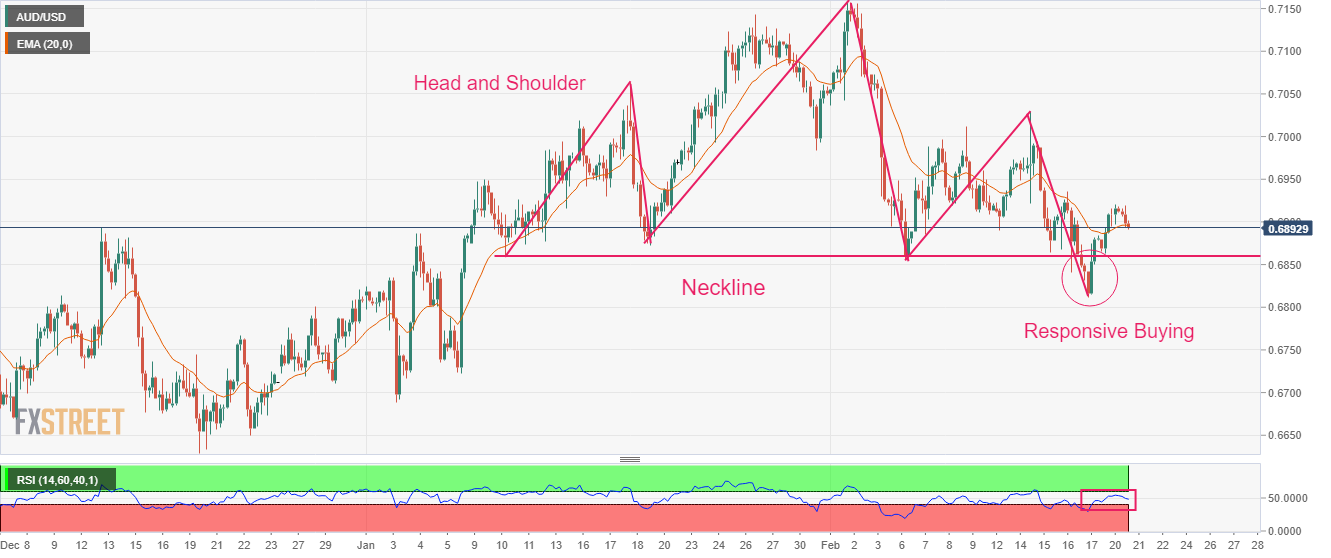
AUD/USD has shifted its business above the neckline of the Head and Shoulder chart pattern plotted from January 10 low at 0.6860 on a four-hour scale. The responsive buying action from the market participants negated the downside break of the above-mentioned chart pattern. The 20-period Exponential Moving Average (EMA) at 0.6900 is acting as a cushion for the Australian Dollar.
The Relative Strength Index (RSI) (14) has rebounded into the 40.00-60.00 range, which indicates a bullish reversal. A break into the bullish range of 60.00-80.00 will trigger the bullish momentum.
Bank of Korea (BOK) Governor Rhee Chang-yong said in a statement on Tuesday, “more delicate policy response is necessary as uncertainty is high both externally and internally.”
Additional quotes
“Difficult to predict future inflation path due to uncertainty over China's reopening, Ukraine war.”
“Will respond in a timely manner in case of uneasiness in financial, forex markets.”
Market reaction
USD/KRW remains on the offers below the $1,300 mark following the above comments, keeping its range trade intact so far this Tuesday.
- Silver price holds lower ground near intraday bottom, snaps two-day winning streak.
- U-turn from key moving average, Fibonacci retracement level joins bearish MACD signals to favor XAG/USD bears.
- 61.8% Fibonacci retracement adds to the upside filters, $21.40 acts as immediate support.
Silver price (XAG/USD) remains depressed around $21.70 during the first loss-making day in three heading into Tuesday’s European session. In doing so, the bright metal portrays a clear reversal from the 200-Hour Moving Average (HMA), as well as the 50% Fibonacci retracement level of its moves between February 09 and 17.
Not only the U-turn from the key technical hurdles but the bearish MACD signals also keep XAG/USD sellers hopeful.
With this, the precious metal’s further declines toward one-week-old horizontal support near $21.40 appear imminent.
However, the monthly low near $21.20 and the 61.8% Fibonacci Expansion (FE) of the metal’s moves from February 09 to 20, around the $21.00 threshold, could challenge the Silver bears.
In a case where the metal remains bearish past $21.00, the odds of witnessing a slump toward the $20.00 psychological magnet can’t be ruled out.
Alternatively, the 200-HMA and the 50% Fibonacci retracement level, respectively close to $21.85 and $21.90, restrict short-term recovery of the XAG/USD.
Following that, the $22.00 round figure will precede the 61.8% Fibonacci retracement level, also known as the gold Fibonacci ratio, could challenge the Silver buyers around $22.05.
Should the XAG/USD remains firmer past $22.05, the February 10 swing high near $22.30 could act as the last defense of the bears.
Silver price: Hourly chart
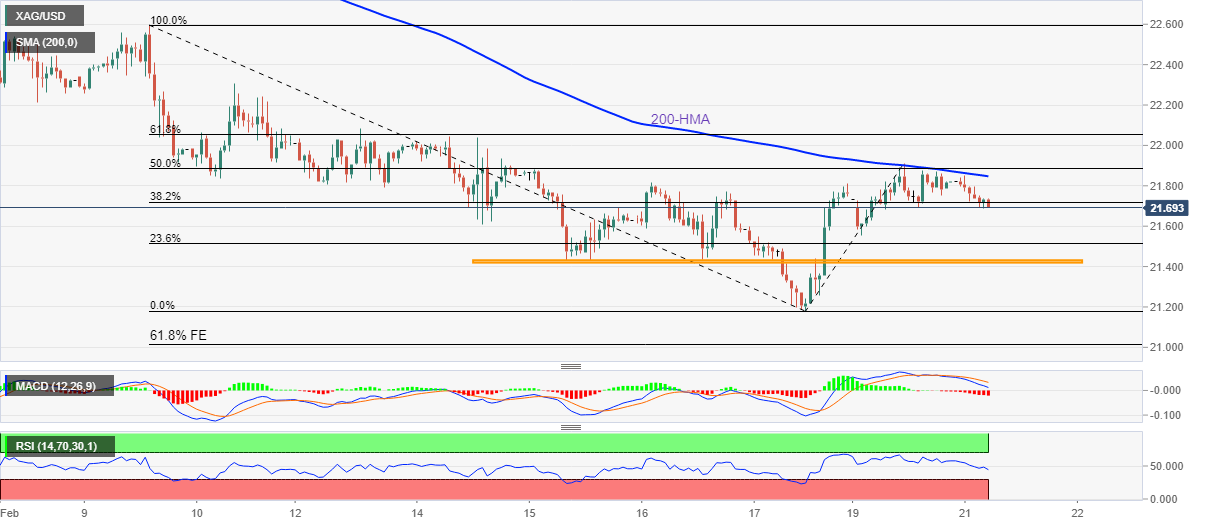
Trend: Further downside expected
- USD/CHF grinds near intraday high during the first positive day in three.
- Risk aversion joins firmer yields to underpin US Dollar rebound amid full markets.
- Geopolitical concerns surrounding China, North Korea and Russia weigh on sentiment.
- Swiss trade numbers, US PMI eyed for immediate directions, Fed Minutes is the key.
USD/CHF remains mildly bid around 0.9240, despite recently easing from the intraday high, as the Swiss pair (CHF) traders benefit from the US Dollar rebound amid sour sentiment.
It’s worth noting, however, that the cautious mood ahead of the key data/events favors the USD/CHF buyers.
That said, the US Dollar Index (DXY) snaps a two-day losing streak while marking mild gains near 104.00. In doing so, the greenback’s gauge versus the six major currencies traces the US Treasury bond yields, as well as benefits from the traditional haven status. That said, the US 10-year Treasury bond yields pick up bids to near the highest levels marked since early November 2022, mildly bid around 3.86% at the latest. While portraying the mood, S&P 500 Futures declined 0.40% intraday to 4,070 at the latest.
While tracing the run-up in the US Treasury bond yields, the fears emanating from China, North Korea and Russia seemed to have underpinned the fresh run-up in the US Treasury bond yields, amid hawkish hopes from the US Federal Reserve (Fed), as well as the US Dollar rebound. That said, the US and China alleged each other over the balloon shooting whereas the US diplomatic ties with Taiwan teased Beijing on Monday. On the same line, the United Nations (UN) Security Council is alarmed by Japan for North Korea’s missile testing and could help the US Dollar to remain firmer due to its safe-haven status.
At home, the Swiss National Bank’s (SNB) previous warnings to use open market operations to defend the CHF seemed to have weighed on the USD/CHF prices. However, the cautious mood ahead of today’s Swiss trade numbers for January and the preliminary readings of the US Purchasing Managers Index (PMI) data for February will be important for the US Dollar ahead of Wednesday’s Federal Open Market Committee’s (FOMC) Monetary Policy Meeting Minutes.
Overall, USD/CHF is likely to remain directed towards the north unless the US PMIs disappoint the watchers.
Technical analysis
Given the USD/CHF pair’s rebound from the previous resistance line from late November, close to 0.9225 at the latest, the buyers are likely approaching the weekly top of 0.9332. However, the 50-DMA restricts the immediate upside of the quote near 0.9245.
- USD/CAD picks up bids to reverse the week-start losses but previous support line challenges the bulls.
- Geopolitical fears, return of full markets weigh on sentiment and underpin US Dollar rebound.
- Oil price bears the burden of firmer USD and fears of slow demand growth, higher inventories.
- Canada inflation eyed as BoC signaled a pause in rate hikes, US PMIs should be observed too.
USD/CAD clings to mild gains near 1.3480 as it reverses the previous day’s losses during early Tuesday in Europe. In doing so, the Loonie pair buyers cheer downbeat prices of Canada’s key export item, WTI crude oil, as well as the full market’s favor to the US Dollar, ahead of the key US and Canadian statistics.
WTI crude oil drops nearly 1.0% on a day as it renews its intraday low to near $76.60 by the press time. In doing so, the black gold reverses the previous day’s corrective bounce off a two-week low, the first in six days, amid fears of more supplies from the US and Saudi Arabia as Saudi Arabian Energy Minister Prince Abdulaziz bin Salman said on Monday, “OPEC+ is flexible enough to change decisions whenever required.”
Elsewhere, fears emanating from China, North Korea and Russia seemed to have joined the fresh run-up in the US Treasury bond yields, amid hawkish hopes from the US Federal Reserve (Fed), to underpin the US Dollar rebound. That said, the US and China alleged each other over the balloon shooting whereas the US diplomatic ties with Taiwan teased Beijing on Monday. On the same line, the United Nations (UN) Security Council is alarmed by Japan for North Korea’s missile testing and could help the US Dollar to remain firmer due to its safe-haven status.
It should be noted that the US Dollar Index (DXY) snaps a two-day losing streak while marking mild gains near 104.00. In doing so, the greenback’s gauge versus the six major currencies traces the US Treasury bond yields, as well as benefits from the traditional haven status. That said, the US 10-year Treasury bond yields pick up bids to near the highest levels marked since early November 2022, mildly bid around 3.86% at the latest. While portraying the mood, S&P 500 Futures declined 0.40% intraday to 4,070 at the latest.
Looking forward, the Canadian Consumer Price Index (CPI) for January, as well as the Bank of Canada (BoC) CPI Core for the said month, will be observed closely for immediate directions as the BoC has already teased a pause in the rates. As a result, softer prints of inflation data may allow the BoC to announce the policy pivot and propel the USD/CAD.
On the other hand, the preliminary readings of the US Purchasing Managers Index (PMI) data for February will be important for the US Dollar ahead of Wednesday’s Federal Open Market Committee’s (FOMC) Monetary Policy Meeting Minutes.
Given the recently hawkish bias for the Fed, versus the BoC’s dovish tone, the USD/CAD is likely to witness further upside unless the Oil prices witness a strong rally.
Technical analysis
A one-week-old support-turned-resistance line near 1.3490 guards the USD/CAD pair’s immediate upside ahead of the 61.8% Fibonacci retracement level of the pair’s December 2022 to February 2023 downside, near 1.3540 at the latest.
Meanwhile, the USD/CAD bears may aim for the 200-Simple Moving Average (SMA), close to 1.3400 by the press time, as an immediate target during the quote’s fresh downside past the latest low of 1.3440. Following that, the monthly bottom surrounding 1.3260 will be in focus.
- EUR/USD has slipped firmly to near 1.0660 as the USD Index eyes more upside.
- S&P500 futures are showing losses ahead of the US opening after an elongated weekend.
- The majority of institutional investors are having pessimist view for Eurozone economic projections.
The EUR/USD pair has slipped to near 1.0660 in the Asian session as the risk appetite of the market participants has trimmed ahead of the global PMI figures. Investors are worried that higher interest rates by the majority of central banks in taming the stubborn inflation have impacted the scale of economic activities. Firms have no other option than to tap funding on higher borrowing costs. Therefore, producers are dodging borrowing or limiting them to fulfill the essential requirements.
The major currency pair has witnessed a steep fall after surrendering the 1.0670 cushion and is expected to display more weakness ahead as the US Dollar Index (DXY) has rebounded firmly. The USD Index is shifting its auction profile above 103.70 after a recovery move as the risk aversion theme has improved the appeal for safe-haven assets.
S&P500 futures have reported losses in the Asian session ahead of the opening of the equity markets in the United States after an extended weekend. The weekend was full of geopolitical tensions including the US-China tensions and missile attacks by North Korea near Japan’s Essential Economic Zone (EEC) region. The demand for US government bonds has also dropped, which has led to a jump in the 10-year yields to 3.86%.
Going forward, the release of the Eurozone ZEW Survey- Economic Sentiment will be keenly watched. The sentiment data is seen as negative at 29.7 vs. the positive figure of 16.7 released earlier. A pessimist view from the majority of institutional investors could impact the Euro ahead.
The reason behind the pessimist view of institutional investors could be the hawkish stance on interest rates by the European Central Bank (ECB) President Christine Lagarde and other policymakers. On Monday, ECB Governing Council member Olli Rehn cited “It would be appropriate for the European Central Bank to raise rates beyond March and reach the terminal rate this summer,” as reported by Reuters. He further added that Eurozone may avoid recession and the growth will be around 1%.
- GBP/USD clings to mild losses as markets await key data.
- US Treasury bond yields recover on full markets’ return, geopolitical fears.
- UK PM Sunak struggles to achieve Brexit deal amid major backlash from Eurosceptic Conservative MPs.
- Preliminary S&P Global PMIs for February appear the key ahead of Wednesday‘s Fed Minutes.
GBP/USD lacks follow-through as it prints mild losses around 1.2020 heading into Tuesday’s London open, flirting with an intraday low by the press time.
In doing so, the Cable pair takes clues from the technical candlestick formation, as well as fundamentals surrounding Brexit and the market sentiment.
Monday’s bearish Doji teases the GBP/USD sellers amid fears of no imminent Brexit deal as the UK’s Conservative Members of the Parliament (MPs) dislike the deal with the European Union (EU) on Northern Ireland (NI). Some of them are threatening to resign, per The Times, amid fears of the compromised deal.
The news also mentioned that UK Prime Minister Rishi Sunak spent notable time in the House of Commons to convince the MPs that no deal had yet been agreed and talks were continuing. “He was told he ‘hasn’t got a hope’ of succeeding without the support of the Democratic Unionist Party,” per The Times.
Elsewhere, a pick-up in the US Treasury bond yields joins the geopolitical fears surrounding North Korea, China and Russia to weigh on the market sentiment and underpin the US Dollar’s rebound as the US traders return after a long weekend. Also adding strength to the greenback, which in turn weighs on the GBP/USD price, could be the market’s concerns that the Federal Reserve (Fed) will be more hawkish than the Bank of England (BoE).
To confirm the same, Wednesday’s Federal Open Market Committee (FOMC) Monetary Policy Meeting Minutes will be eyed closely. Ahead of that, the preliminary readings of the UK and the US Purchasing Managers Index (PMI) data for February should offer intermediate clues. It’s worth noting that the British numbers have mostly been disappointing of late and hence downbeat UK PMIs are likely to weigh on the Cable pair, especially amid Brexit woes and geopolitical fears. On the other hand, the US figures have been positive in recent days and hence odds of the GBP/USD pair’s further weakness on upbeat data can’t be ruled out.
Technical analysis
Monday’s Doji candlestick on the daily GBP/USD chart suggests another fall of the Cable pair towards the 100-day Exponential Moving Average (EMA), around 1.1915 by the press time.
- USD/INR is likely to continue moving north amid declining investors’ risk appetite.
- The demand for US government bonds is declining ahead of the FOMC minutes.
- One more 25 bps rate hike is expected from the RBI as the current inflation is beyond its tolerance limit.
The USD/INR pair is approaching 82.80 as the US Dollar Index (DXY) has rebounded firmly amid the risk-off market mood. Investors are channelizing their funds into the USD Index amid rising uncertainty ahead of the US opening after an elongated weekend.
The USD Index has delivered a breakout of the consolidation formed in a narrow range of 103.45-103.63 as the risk aversion theme is gaining traction. Also, anxiety among investors is accelerating as investors are anticipating hawkish commentary in the Federal Open Market Committee (FOMC) minutes, which will release on Wednesday. The 10-year yields on US government bonds have climbed above 3.85%.
S&P500 futures have extended their losses further as rising odds of further interest rate hikes by the Federal Reserve (Fed) might refresh recession fears.
The release of the FOMC minutes will provide a detailed explanation behind the rate hike by 25 basis points (bps) to 4.50-4.75% from the Fed. Apart from that, cues about interest rate guidance and current economic fundamentals will be keenly watched.
On the Indian Rupee front, higher inflation is still advocating for further policy restriction by the Reserve Bank of India (RBI). Economists at ANZ Bank expect the Reserve Bank of India (RBI) to deliver one more 25 basis points (bps) rate hike. A note from ANZ Bank stated, “January’s CPI inflation at 6.5% was much above the monetary policy committee’s tolerance limit, jeopardizing the RBI’s near-term inflation projections.”
Meanwhile, oil prices have dropped significantly below $76.60 as investors are worried about economic projections. Also, the Chinese economy is not delivering recovery as expected, which is impacting the oil price. It is worth noting that India is one of the leading importers of oil and lower oil prices will support the Indian Rupee.
- Gold price is struggling to sustain above $1,840.00 as yields escalate ahead of Fed minutes.
- A fresh rebound in the US economic indicators that provide guidance on inflation has cleared that inflation is stubborn in nature.
- Gold price is doing efforts in shifting its auction above the 20-period EMA.
Gold price (XAU/USD) is displaying a lackluster performance above $1,840.00 in the Tokyo session. The precious metal is gauging a direction, however, the volatility contraction will continue to stay ahead of the release of the Federal Open Market Committee (FOMC) minutes.
Investors’ risk appetite has trimmed as uncertainty has escalated ahead of the opening of markets in the United States after an extended weekend. This has led to a further decline in risk-sensitive assets like S&P500 futures. The US Dollar Index (DXY) has shown a rebound to near 103.70 but is still inside the woods ahead of the FOMC minutes. Meanwhile, the alpha generated on 10-year US Treasury bonds has climbed above 3.86%.
A fresh rebound in the US economic indicators that provide guidance on inflation has cleared that the Consumer Price Index (CPI) is stubborn in nature and will force Federal Reserve (Fed) chair Jerome Powell to raise rates further to tame price pressures. For more guidance, the FOMC minutes will be keenly watched.
But before that, the release of the preliminary S&P Global PMI (Feb) figures will be keenly watched. As per the consensus, the preliminary Manufacturing PMI (Feb) will land lower at 46.8 vs. the prior release of 46.9. And, the Services PMI will release at 46.6 against the former release of 46.8.
Gold technical analysis
Gold price has shown a responsive buying action after a downside trend to near the 38.2% Fibonacci retracement (plotted from November 03 low at $1,616.69 to February 2 high at $1,959.71) at $1,828.95. The dotted downward-sloping trendline from February 9 high at $1,890.27 will act as a major barricade for the Gold bulls.
The precious metal is aiming to shift its auction above the 20-period Exponential Moving Average (EMA) at $1,841.00, which will activate the short-term bullish trend.
Meanwhile, the Relative Strength Index (RSI) (14) has shifted into the 40.00-60.00 range from the bearish range of 20.00-40.00, which indicates that the asset is no more bearish for now.
Gold four-hour chart
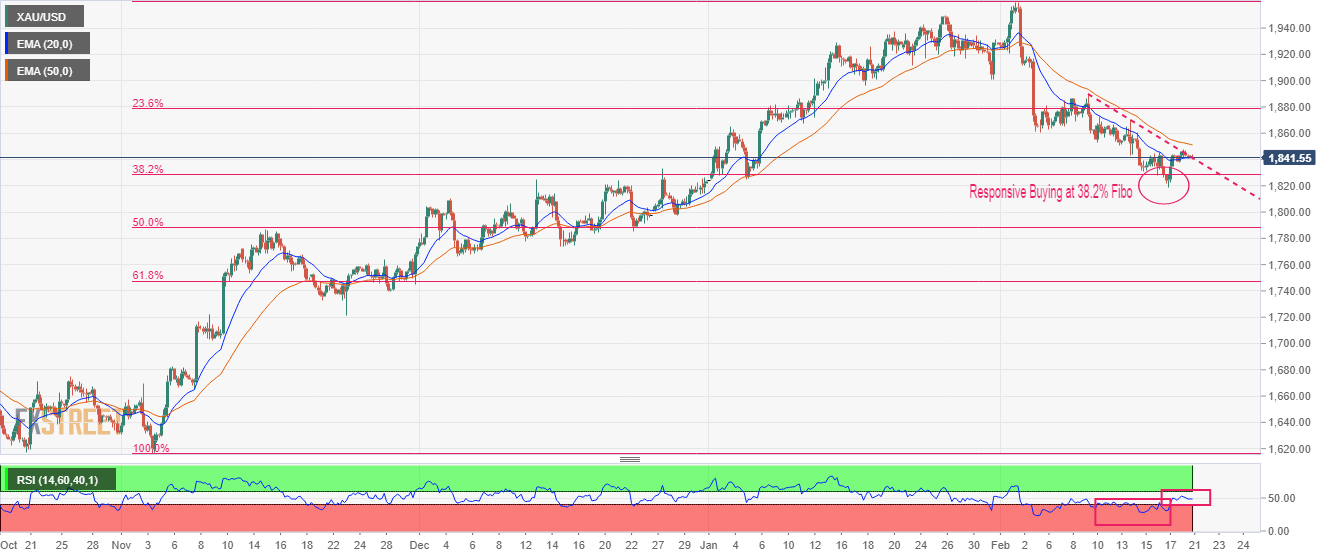
- AUD/USD seesaws around intraday high as full markets recall US Dollar bulls.
- RBA Minutes, Aussie PMIs came in firmer but failed to underpin recovery amid geopolitical fears.
- Risk catalysts eyed for intermediate directions ahead of US PMIs for February, Fed Minutes appear the key.
AUD/USD fades bounce off intraday low while printing mild losses near 0.6900 during early Tuesday. In doing so, the Aussie pair fails to cheer the hawkish Minutes Statement from the Reserve Bank of Australia (RBA), as well as the upbeat Australian activity data. The reason could be linked to the market’s risk-off mood and the US Dollar’s rebound during the first trading day of the week.
US Dollar Index (DXY) snaps a two-day losing streak while marking mild gains near 104.00. In doing so, the greenback’s gauge versus the six major currencies traces the US Treasury bond yields, as well as benefits from the traditional haven status. That said, the US 10-year Treasury bond yields pick up bids to near the highest levels marked since early November 2022, mildly bid around 3.86% at the latest.
While portraying the mood, S&P 500 Futures declined 0.40% intraday to 4,070 at the latest.
Elsewhere, the latest RBA Meeting Minutes signaled that the monetary policy board considered a hike of 25 basis points (bps) or 50bp but not discussed a pause in the rate hikes. The Minutes Statement also raised doubts about the frequent hawkish moves and weighed on the AUD/USD while mentioning, “Monthly meetings allowed for frequent adjustments, rates had already risen substantially.”
It should be noted that the first readings of Australia’s S&P Global PMIs came in better than forecasts in February. However, only Manufacturing PMI crossed the 50.0 benchmark that divides activity contraction from expansion.
On a different page, the US and China alleged each other over the balloon shooting whereas the US diplomatic ties with Taiwan teased Beijing on Monday, which in turn weighed on the sentiment and the risk barometer AUD/USD pair. On the same line, the United Nations (UN) Security Council is alarmed by Japan for North Korea’s missile testing and could help the US Dollar to remain firmer due to its safe-haven status.
Looking forward, a few more PMIs, especially from the US, will be important for the AUD/USD pair traders but major attention should be given to the risk catalysts and the Fed Minutes for clear directions. Should the US data track the recent pattern of posting positive surprises and/or the FOMC Minutes also portray the hawkish mood, the Aussie pair will have a further downside to track.
Technical analysis
Although the 50-DMA puts a floor under the AUD/USD price near 0.6890, the recovery moves need validation from a 13-day-old resistance line, close to 0.6950 by the press time.
- USD/JPY picks up bids to print three-day winning streak, grinds near intraday top.
- BoJ’s Kuroda highlights higher wages, Japan’s Jibun Bank PMIs for February came in mixed.
- Treasury yields reverse Friday’s pullback as full markets return.
USD/JPY grinds higher around intraday top surrounding 134.35-40 amid a three-day uptrend during early Tuesday. In doing so, the Yen pair tracks the recent pick up in the US Treasury bond yields while struggling to justify hawkish comments from Bank of Japan (BoJ) Governor Haruhiko Kuroda and the mixed Purchasing Managers Index (PMI) for February.
That said, preliminary readings of Japan’s Jibun Bank Manufacturing PMI dropped to the lowest levels since September 2020, to 47.4 versus 48.9 expected and prior. The Services PMI, however, offered a positive surprise with 53.6 figure compared to 51.5 market forecasts and 51.1 previous readouts.
Elsewhere, BoJ’s Kuroda said that wage growth will likely accelerate as companies increase pay to compensate households for the higher cost of living, and cope with an intensifying labor shortage. The same raises fears of a higher BoJ rate when Kuroda retires in April.
However, the talks that Kuroda will play his last shot strongly enough to mark his reign at the BoJ as a remarkable dovish one keep the USD/JPY buyers hopeful.
It should be noted that yields recovered on the full markets’ return as hawkish hopes from the US Federal Reserve (Fed) renewed, which in turn underpinned the US Dollar’s recovery. On the other hand, the US and China alleged each other over the balloon shooting whereas the US diplomatic ties with Taiwan teased Beijing. On the same line, the United Nations (UN) Security Council is alarmed by Japan for North Korea’s missile testing and the same weigh on the sentiment, as well as favors the US Dollar.
Against this backdrop, the US 10-year Treasury bond yields pick up bids to near the highest levels marked since early November 2022, mildly bid around 3.86% at the latest. On the same line, S&P 500 Futures declined 0.40% intraday to 4,070 at the latest.
Looking ahead, risk catalysts may entertain USD/JPY traders ahead of the first readings for the US February PMIs. Should the scheduled US PMIs appear firmer than what was marked in January, and also manage to cross the 50.0 mark despite unimpressive expectations, the odds of witnessing further USD/JPY run-up can’t be ruled out.
Technical analysis
A clear upside break of the one-month-old previous resistance line, now support near 134.00, directs USD/JPY further towards the north.
| Raw materials | Closed | Change, % |
|---|---|---|
| Silver | 21.81 | 0.5 |
| Gold | 1841.37 | 0.01 |
| Palladium | 1515.07 | 1.45 |
- Market sentiment remains downbeat as geopolitical fears joins the return of full markets.
- The return of US, Canada traders renew US Treasury bond yields’ run-up amid hopes of hawkish Fed, upbeat US data.
- S&P 500 Futures print four-day downtrend around the monthly low.
Risk profile fades the week-start cautious optimism as hawkish expectations from the key central banks join the fears of recession and geopolitical concerns.
While portraying the mood, the US 10-year Treasury bond yields pick up bids to near the highest levels marked since early November 2022, mildly bid around 3.86% at the latest. On the same line, S&P 500 Futures declined 0.40% intraday at the latest.
An uptick in the yields welcomed the full markets’ return amid hawkish hopes from the US Federal Reserve (Fed), which in turn underpinned the US Dollar’s recovery. On the other hand, the US and China alleged each other over the balloon shooting whereas the US diplomatic ties with Taiwan teased Beijing. On the same line, the United Nations (UN) Security Council is alarmed by Japan for North Korea’s missile testing and the same weigh on the sentiment, as well as favors the US Dollar.
Elsewhere, a cautious mood ahead of the preliminary readings of the S&P Global PMIs for February will be crucial for the market players as recent US data have been mixed, which in turn could recall the US Dollar bears and favor the market’s cautious optimism. Also important will be the Federal Reserve (Fed) talks to watch for clear directions.
Above all, Wednesday’s Fed Minutes will be crucial for the market players to follow as the US monetary policymakers seem to have lacked unity about the next rate hike and the same can weigh on the US Dollar if confirmed by the Minutes Statement.
Apart from what’s already mentioned above, inflation numbers from Canada and the Reserve Bank of New Zealand (RBNZ) monetary policy meeting will also be important for traders. The reason could be linked to the Bank of Canada’s (BoC) hints for pausing the rate hikes, as well as New Zealand’s geopolitical crisis that challenges the Kiwi buyers but also propel the inflation in the nation and favor RBNA hawks.
Also read: Forex Today: Slow start to the week
- EUR/USD takes offers to refresh intraday low, extends U-turn from 10-DMA.
- Bearish MACD signals, clear break of three-month-old ascending trend line favor sellers.
- Ascending trend line from early December 2022 lures Euro sellers.
- Buyers need to cross 1.0805 to jump back in the driver’s seat.
EUR/USD takes offers to extend the week-start losses from the 10-DMA to 1.0670 during early Tuesday. In addition to a pullback from the short-term key moving average, bearish MACD signals and the pair’s sustained downside break of the previous support line from late November 2022 also keep the sellers hopeful.
As a result, the EUR/USD bears are well-set to revisit an upward-sloping support line from early December, close to 1.0620 by the press time.
However, the major currency pair’s further downside appears difficult as lows marked so far during February and January, respectively near 1.0610 and 1.0480, could probe the sellers afterward.
Also acting as a downside filter is the early December 2022 swing low surrounding 1.0440.
On the flip side, the 10-DMA and the three-month-old previous support line could challenge the EUR/USD pair’s recovery around 1.0700 and 1.0730 levels.
Following that, a three-week-long horizontal resistance area near 1.0800-05 could act as the last defense of the EUR/USD bears.
In a case where the EUR/USD pair remains firmer past 1.0805, the odds of witnessing a run-up towards the 1.1000 psychological magnet and then to the monthly high near 1.1035 can’t be ruled out.
EUR/USD: Daily chart
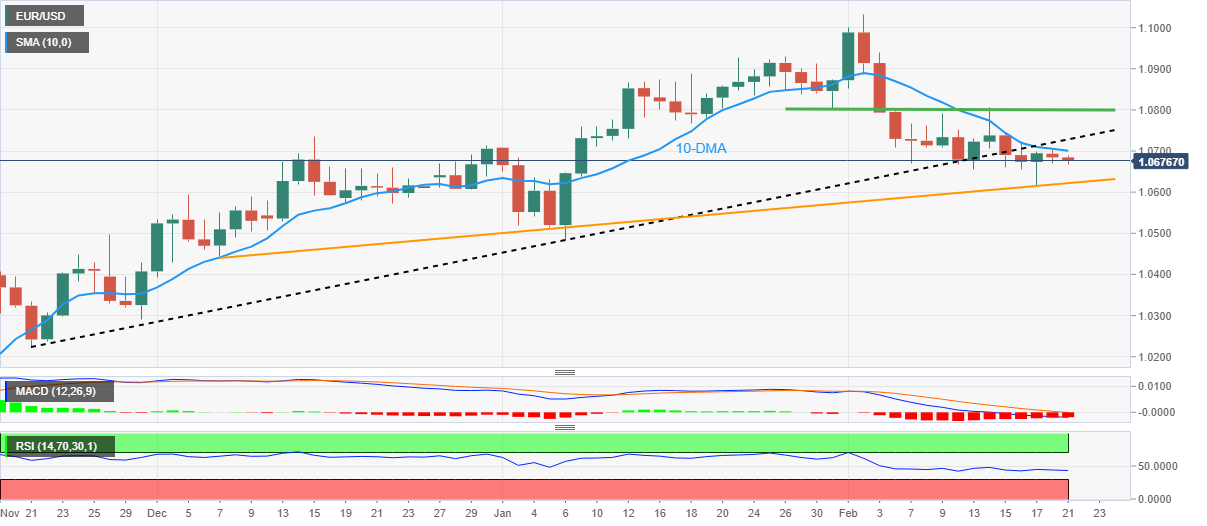
Trend: Further downside expected
- EUR/JPY bullish run is stalling and a long squeeze could be put on.
- The daily chart's W-formation is compelling and a 38.2% Fibonacci comes in at 142.10.
- A 50% mean reversion target comes in at around 141.60 and a 61.8% Fibonacci retracement is near 141.10.
EUR/JPY is flat in Tokyo and sticking to the opening ranges for the week following a low liquidity day in the US holiday markets. However, from a technical standpoint, the coiled conditions could be the foundations for some explosive moves in the forthcoming days as the following analysis will illustrate.
EUR/JPY H1 chart
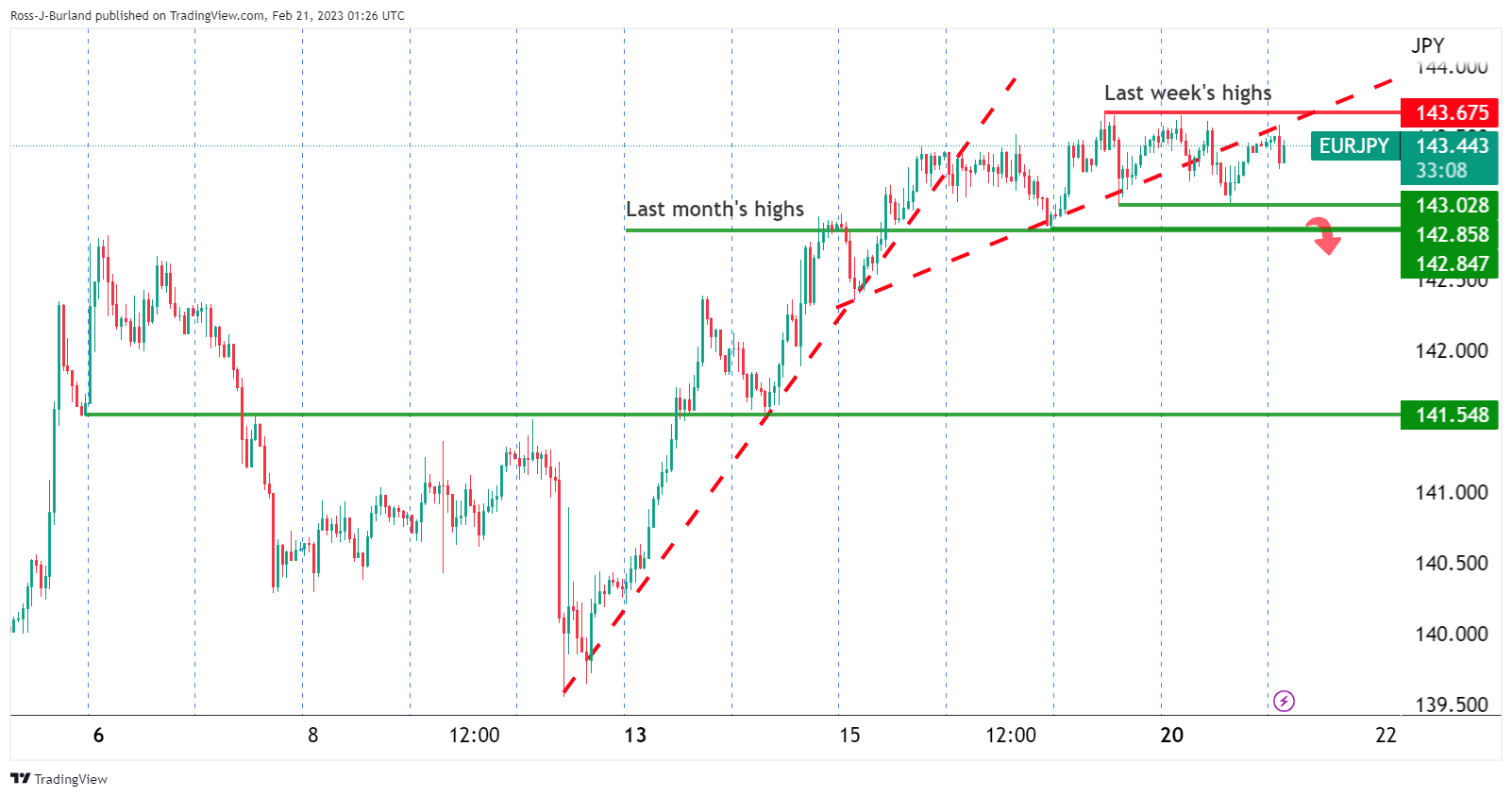
From an hourly perspective, EUR/JPY is coiled at what could be a meanwhile top in the broader bullish trend as per the daily chart below.
A thesis could be that volumes might get trapped up high as higher time frame traders and investors chase the breakout of the prior month's highs. In such a scenario, a long squeeze could be put on a break of the key support structure that is located between 143.00 and the 142.80s. If this area were to break, it would clear the way for lower lows in what could turn out to be a sizeable correction as the following shows:
EUR/JPY daily chart
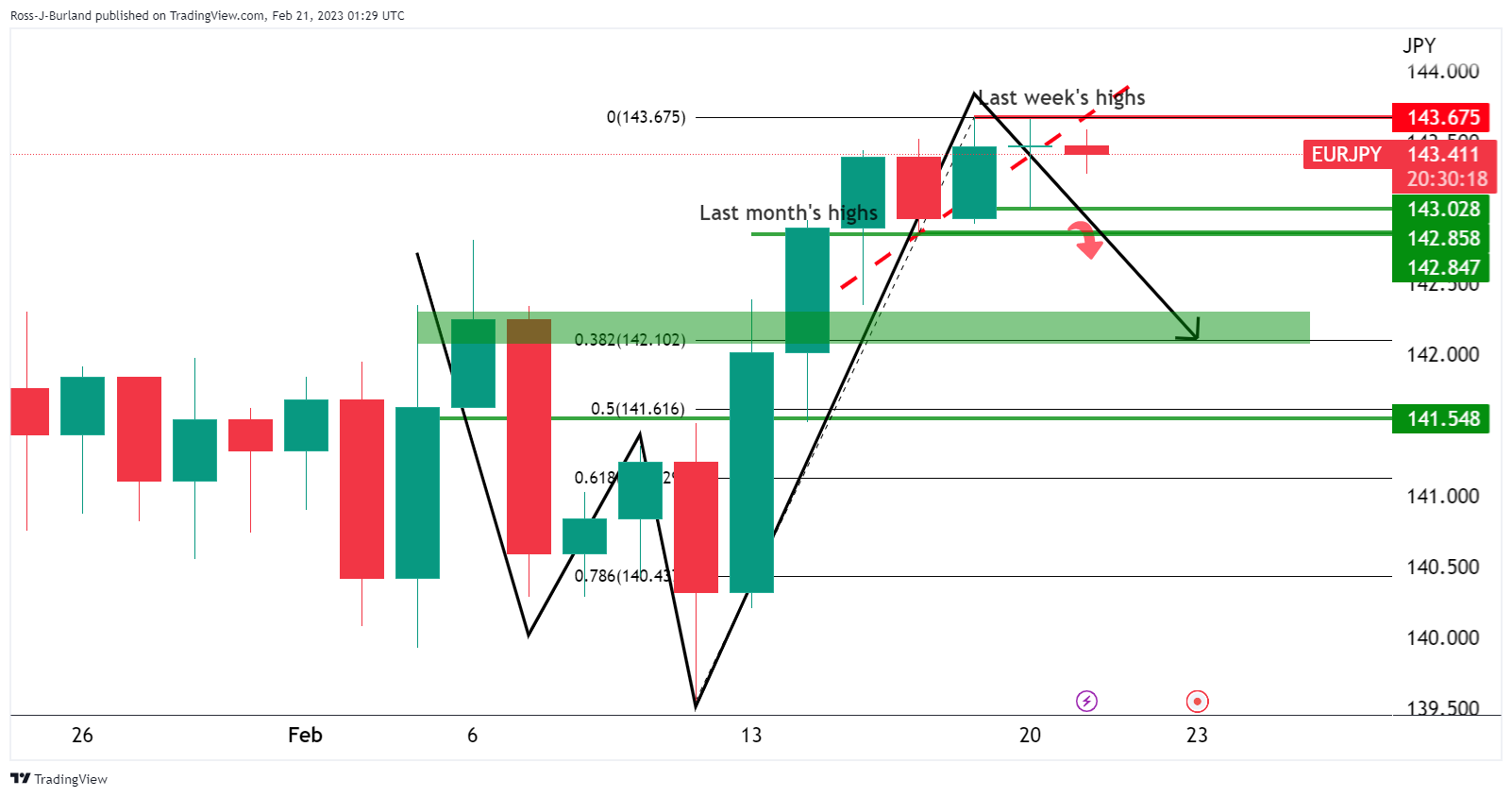
The daily chart's W-formation is compelling and a 38.2% Fibonacci scale drawn on the prior bullish impulse aligns with the resistance area for early February near 142.10. A 50% mean reversion target comes in at around 141.60 and a 61.8% Fibonacci retracement aligns with the neckline of the W-formation near 141.10.
- EUR/GBP is auctioning in a volatility contraction pattern ahead of the UK/Eurozone PMIs release.
- ECB Rehn sees more interest rate hikes beyond March and expects that Eurozone will avoid recession.
- A pause in the policy tightening spell might create troubles for the BoE as the inflation figure is still double in digits.
The EUR/GBP pair is displaying a sideways auction in a narrow range of 0.8870-0.8890 in the Tokyo session. The cross has turned sideways as investors are awaiting the release of the preliminary PMI figures for the Eurozone and the United Kingdom for further impetus.
Considering the fact that economic activities in the UK region are slowing down as the Bank of England (BoE) has increased interest rates dramatically, the street is expecting a pause in the policy tightening spell. This could create trouble for the BoE as the inflation figures are still double in digits.
Meanwhile, Eurozone inflation is declining meaningfully but is still far from the desired rate. European Central Bank (ECB) Governing Council member Olli Rehn cited “It would be appropriate for the European Central Bank to raise rates beyond March and reach the terminal rate this summer,” as reported by Reuters. He further added that Eurozone may avoid recession and the growth will be around 1%.
EUR/GBP is auctioning in a Symmetrical Triangle chart pattern that indicates a sheer contraction in volatility, which is followed by a breakout in the same. The downward-sloping trendline of the above-mentioned chart pattern is placed from February 3 high at 0.8979 while the upward-sloping trendline is placed from January 19 low at 0.8722.
The 20-period Exponential Moving Average (EMA) at 0.8880 is overlapping on the asset price, which indicates indecisiveness in the sentiment of the market participants.
Meanwhile, the Relative Strength Index (RSI) (14) is oscillating in the 40.00-60.00, which signals a lackluster performance ahead.
Should the cross breaks above February 17 high at 0.8929, Euro bulls will drive the asset towards February 3 high at 0.8979 followed by the psychological support at 0.9000.
On the flip side, a breakdown below February 14 low at 0.8804 will expose the asset to January 29 low at 0.8763 and January 19 low at 0.8722.
EUR/GBP four-hour chart
-638125401575656278.png)
In recent trade today, the People’s Bank of China (PBOC) set the yuan at 6.8557 vs. the previous fix of 6.8643 prior close of 6.8563.
About the fix
China maintains strict control of the yuan’s rate on the mainland.
The onshore yuan (CNY) differs from the offshore one (CNH) in trading restrictions, this last one is not as tightly controlled.
Each morning, the People’s Bank of China (PBOC) sets a so-called daily midpoint fix, based on the yuan’s previous day's closing level and quotations taken from the inter-bank dealer.
- GBP/USD takes offers to refresh intraday low after a sluggish start to the week.
- Return of full markets propels yields, renew US Dollar run-up.
- Looming fears over NI Brexit deal and the UK recession weigh on Cable price.
- UK/US PMIs eyed for fresh impulse, risk catalysts are important too.
GBP/USD renews intraday low near 1.2020 during early Tuesday morning as traders cheer the return of the Westerns traders, following an extended weekend due to the US holidays. In addition to the full market’s return, the Cable pair traders also portrays fears emanating from the Brexit deal negotiations and doubts over the small industries’ optimism.
Late on Monday, the UK Times came out with the news suggesting British Ministers are prepared to resign over (Prime Minister) Rishi Sunak’s Brexit deal if it risks Northern Ireland’s place within the UK. “There is a mounting backlash among Eurosceptic Conservative MPs to the deal,” mentioned The Times.
Elsewhere, The Times quotes Barclay’s industrial survey to state that bosses of small companies are increasingly upbeat about their prospects. The same adds to evidence that the outlook for the British economy may not be as bad as has been feared, mentioned the news.
Above all, fears of a monetary policy divergence between the Fed and the Bank of England (BoE), back by the week’s British mixed statistics and the strong US data, seem to weigh on the GBP/USD price.
That said, the US 10-year Treasury bond yields pick-up bids to near the highest levels marked since early November 2022, mildly bid around 3.86% at the latest.
It should be noted that the geopolitical fears emanating from China and Russia also seem to underpin the US Dollar’s safe-haven demand and weigh on the GBP/USD price.
Moving on, preliminary readings of the S&P Global PMIs for February will be crucial for the GBP/USD pair traders. That said, upbeat data from the UK becomes necessary to put a floor under the prices as the latest US Treasury bond yields’ moves favored the US Dollar ahead of the key US PMIs.
Technical analysis
Although Monday’s Doji candlestick keeps GBP/USD bears hopeful, an upward-sloping support line from late November 2022, close to 1.1920 by the press time, puts a floor under the Cable pair.
Bank of Japan Governor Haruhiko Kuroda crossed the wires on Tuesday who has explained wage growth will likely accelerate as companies increase pay to compensate households for the higher cost of living, and cope with an intensifying labour shortage.
Speaking in parliament, Kuroda came out with the following key comments:
Forex moves on various factors, will continue to watch market moves and impact on economy closely.
Important for forex to move stably in way that reflects fundamentals.
Govt will watch economy, markets carefully.
Wage growth likely to accelerate as economy improves given tightening labour market.
Outcome of spring wage negotiations likely to reflect tighten job market, recent price rises.
USD/JPY update
USD/JPY Price Analysis: W-formation's support structure eyed near 132.80
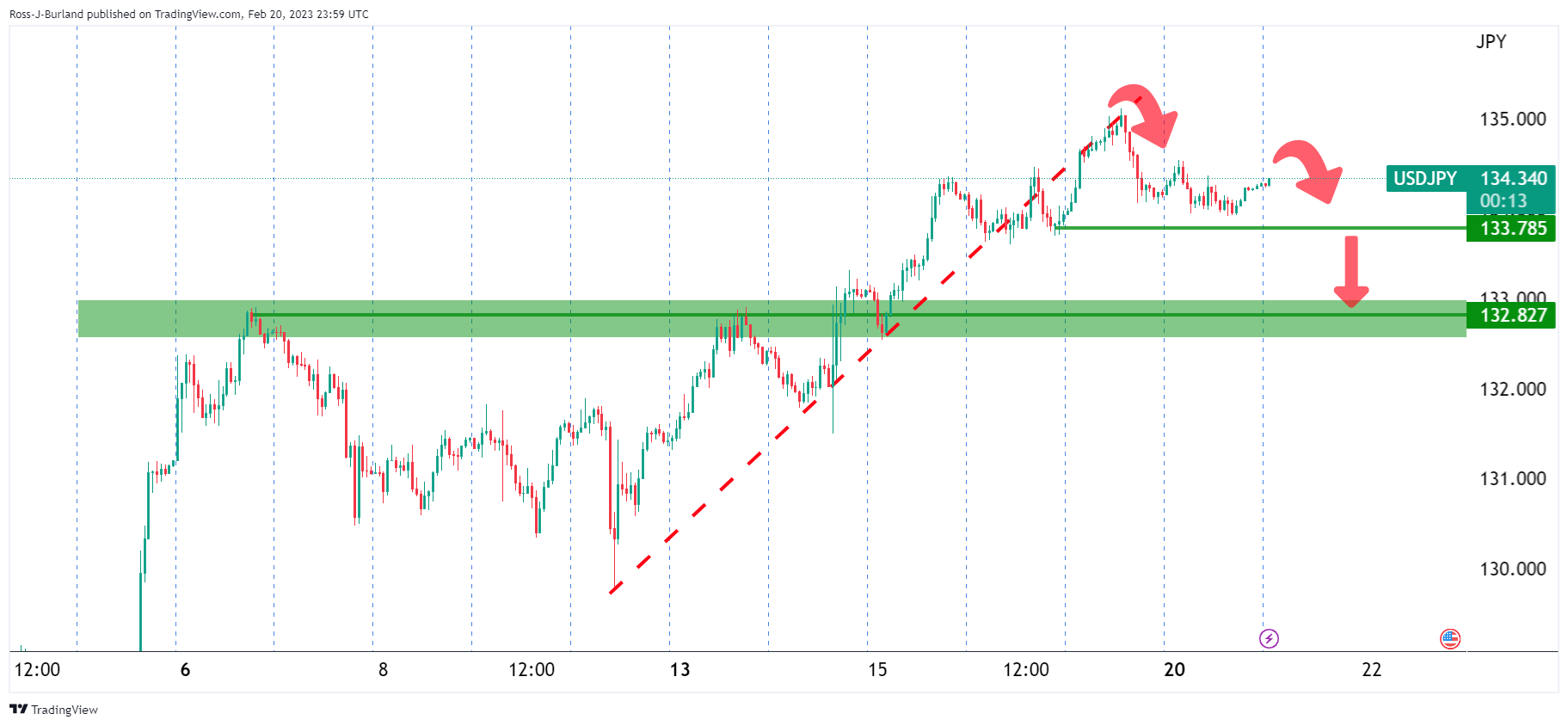
USD/JPY has started to top out and a break below 133.80 structure opens the risk of a significant correction for the day ahead.
- USD/CAD remains sidelined after breaking one-week-old ascending trend line the previous day.
- Bearish MACD signals add strength to the downside bias targeting 200-SMA.
- Bulls need successful break of 61.8% golden Fibonacci ratio to retake control.
USD/CAD struggles for clear directions, despite picking up bids to refreshi ntraday high around 1.3470 during Tuesday’s Asian session, following a downbeat start of the week.
Although holidays in the US and Canada restricted the Loonie pair’s previous moves, the quote’s sustained trading below the previous support line from the last Tuesday, now resistance near 1.3490, keeps the pair sellers hopeful.
Also adding strength to the downside bias are the bearish MACD signals and a clear U-turn from the 61.8% Fibonacci retracement level of the pair’s December 2022 to February 2023 downside, near 1.3540 at the latest.
That said, the USD/CAD bears may aim for the 200-Simple Moving Average (SMA), close to 1.3400 by the press time, as an immediate target during the quote’s fresh downside past the latest low of 1.3440. Following that, the monthly bottom surrounding 1.3260 will be in focus.
Alternatively, the aforementioned support-turned-resistance line and the 61.8% Fibonacci retracement level could challenge the short-term USD/CAD buyers around 1.3490 and 1.3540 respectively.
In a case where the Loonie pair remains firmer past 1.3540, January’s peak surrounding 1.3685 and multiple hurdles marked during late 2022 around 1.3700 will be in the focus of the pair buyers.
To sum up, USD/CAD remains on the bear’s radar despite the latest corrective bounce.
USD/CAD: Four-hour chart
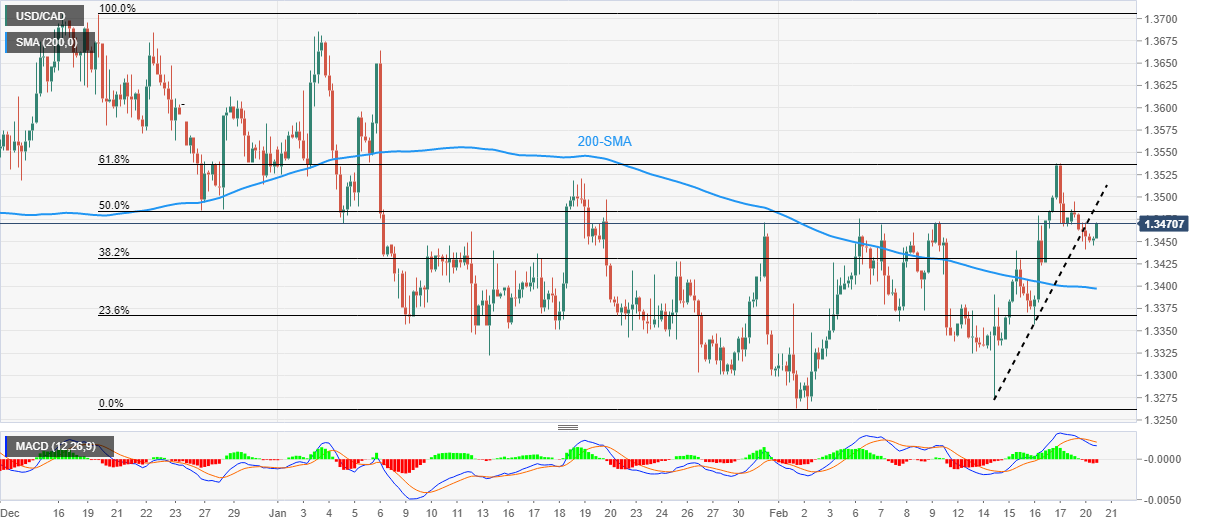
Trend: Further downside expected
- AUD/JPY has jumped toward 93.00 as RBA minutes have cleared that more rate hikes are warranted.
- The RBA members also considered the option of a 50 bps OCR hike increase.
- BoJ Kuroda sees an increase in wages due to labor demand and inflation.
The AUD/JPY pair has climbed to near 93.00 in the Tokyo session after observing a hawkish stance from the minutes released by the Reserve Bank of Australia (RBA). The message from the RBA minutes is clear that more interest rates are warranted as strong consumer demand is not allowing Australian inflation to soften from its peak.
According to the RBA minutes, members also considered the option of 50 basis points (bps) interest rate hike considering the persistence in inflation. The RBA members also highlighted that the Unemployment Rate is the lowest in the past 50 years and job vacancies are extremely high, which is delighting households for flushing surplus funds into the economy.
Apart from that, the Australian economy was benefiting from higher terms of trade and would benefit more than a number of other countries from China’s reopening. The rollback of pandemic controls by the Chinese administration has opened more trade for the Australian economy.
For further guidance, RBA Governor Philip Lowe sees the cash rate rising to 3.75% over time, headline inflation is expected to decline to 4.75% by the end of 2023 and return to around 3% by mid-2025.
Earlier, S&P Global reported upbeat preliminary Australian PMI (Feb) data. The Manufacturing PMI landed at 50.1, higher than the consensus of 49.9 and the former release of 50.0. The Services PMI scaled firmly to 49.2 versus the estimates of 48.4 and the prior release of 48.6.
On the Japanese Yen front, Bank of Japan (BoJ) Governor Haruhiko Kuroda stated “Wages are likely to rise due to labor demand and inflation. The Japanese Yen has not reacted much to the mixed preliminary Jibun Bank PMI (Feb) data. The Services PMI has landed at 53.6, outperforming the estimates of 51.5 and the prior release of 51.1. While the Manufacturing PMI has dropped to 47.4 from the expectations and the prior figure of 48.9.
- AUD/USD picks up bids to extend the bounce off intraday low on RBA Minutes.
- RBA Minutes reject speculations favoring a pause in the rate hikes in February.
- Mixed sentiment, full markets may probe bulls ahead of US PMIs for February.
AUD/USD picks up bids to reverse initial Asian session losses to 0.6910, taking a U-turn from the intraday low to refresh the daily top near 0.6920, as the Reserve Bank of Australia (RBA) rules out dovish hopes on early Tuesday. In doing so, the Aussie pair also marks a late reaction to Australia’s activity data for February. However, the cautious mood ahead of the first readings for the US February PMIs and the return of the full markets seem to probe the traders of late.
The latest RBA Meeting Minutes signaled that the monetary policy board a hike of 25 basis points (bps) or 50bp but not discussed a pause in the rate hikes.
Also read: RBA minutes: The board agreed that additional rate hikes were likely in the coming months
Earlier in the day, Australia’s preliminary readings of the S&P Global PMIs for February came in firmer as Manufacturing PMI rose to 50.1, versus 49.9 expected and 50.0 prior while the Services PMI increased to 49.2 from 48.6 previous readings and 48.4 market forecasts. Further, the S&P Global Composite PMI also improved to 49.2 from 48.5.
It should be noted that the cautious sentiment on the return of the full markets and geopolitical fears surrounding China and North Korea seem to probe the AUD/USD bulls. On the same line could be the hawkish bias about the Fed and the recently firmer US Treasury bond yields, which put a floor under the US Dollar.
Recently, the US and China alleged each other over the balloon shooting whereas the US diplomatic ties with Taiwan teased Beijing. On the same line, the United Nations (UN) Security Council is alarmed by Japan for North Korea’s missile testing and the same weigh on the sentiment, as well as the AUD/USD price.
While portraying the mood, S&P 500 Futures print mild losses near 4,075 amid sluggish US 10-year Treasury bond yields. Even so, the benchmark US bond coupons are near the highest levels marked since early November 2022.
Should the scheduled US PMIs appear firmer than what marked in January, also manage to cross the 50.0 mark despite unimpressive expectations, the odds of witnessing further US Dollar strength and the AUD/USD weakness can’t be ruled out.
Technical analysis
Unless breaking the the 200-DMA, around 0.6800 by the press time, AUD/USD remains on the way to a 13-day-old resistance line, close to 0.6950 at the latest.
The Reserve Bank of Australia's minutes have been released and they state that the board agreed that additional rate hikes were likely in the coming months.
Reuters reported that ''Australia's central bank, startled by the risk that inflation could prove stickier than previously thought, abandoned all thought of pausing at its February policy meeting and signalled more rate hikes would be needed in the months ahead.''
''Minutes of the Feb. 7 policy meeting out on Tuesday showed the Reserve Bank of Australia's (RBA) Board only discussed two options - hiking by 50 basis points or 25 bps.''
''A pattern of upward surprises on inflation and wages had argued for the larger move, the minutes showed.The Board settled on a quarter-point hike, which brought the cash rate to a fresh decade-high of 3.35%, noting an uncertain global outlook, the flexibility it has through the monthly meetings, and the already substantial increase in rates so far.''
Key notes
Board considered hike of 25bp or 50bp, a pause was not an option.
Arguments in favour of both options but board agreed case for 25bp was stronger.
Households facing tighter budgets, falling real incomes argued for 25bps.
Monthly meetings allowed for frequent adjustments, rates already risen substantially.
Pattern of upward surprises on inflation, wages argued for 50bp move.
Longer inflation stayed high, greater the risk of price-wage spiral.
Board agreed further rate increases would likely be needed over the months ahead.
Board noted inflation forecasts based on technical assumption of 3.75% cash rate.
Board noted cash rate was still lower than in many other developed nations.
Board will do what is necessary to return inflation to target.
Australia benefiting from strong terms of trade, large household savings buffers.
Australia to benefit more from china reopening than number of other countries.
AUD/USD update
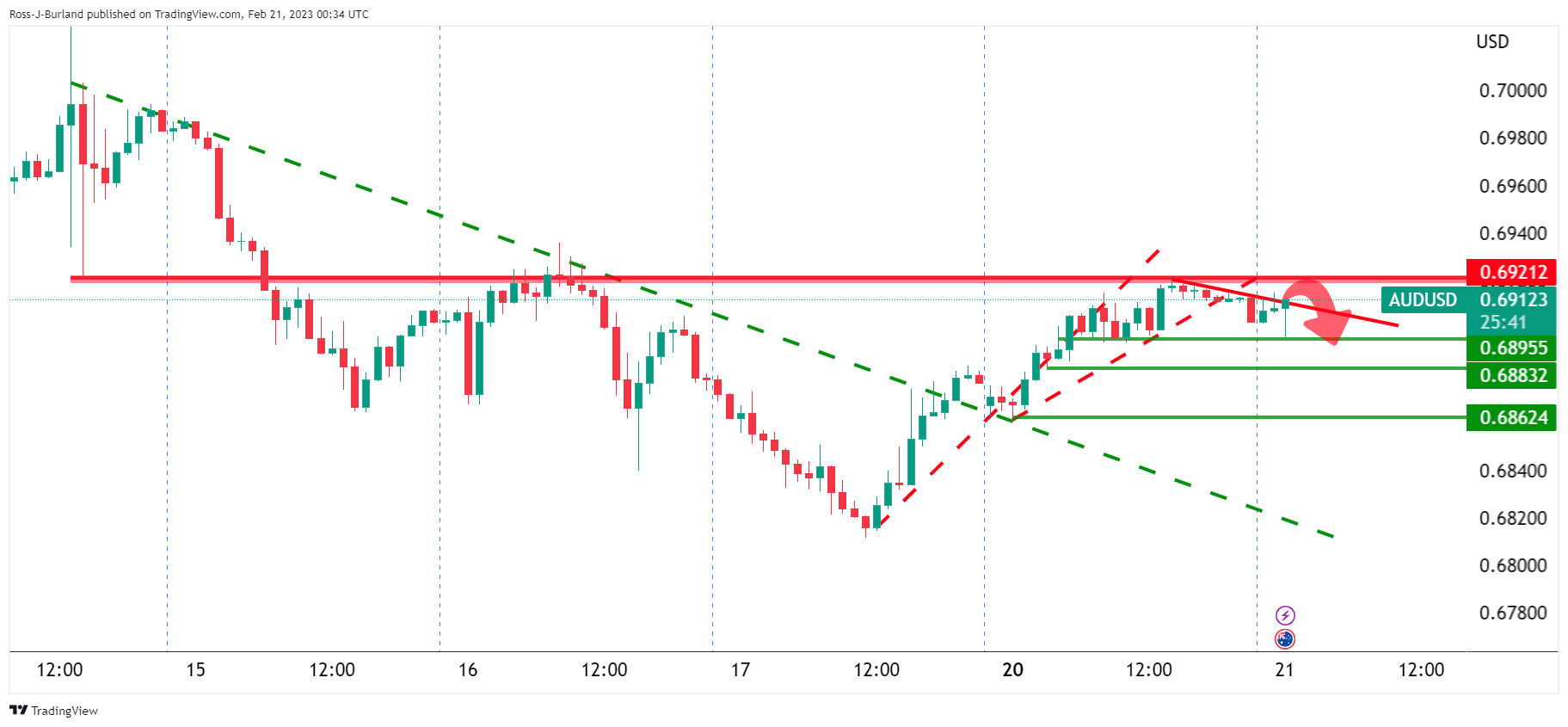
AUD/USD's run to the upside has stalled but a break of 0.6900 is required where otherwise, a continuation beyond 0.6920 opens a risk of a bullish continuation for the day ahead.
About the RBA minutes
The minutes of the Reserve Bank of Australia meetings are published two weeks after the interest rate decision. The minutes give a full account of the policy discussion, including differences of view. They also record the votes of the individual members of the Committee. Generally speaking, if the RBA is hawkish about the inflationary outlook for the economy, then the markets see a higher possibility of a rate increase, and that is positive for the AUD.
- NZD/USD is juggling ahead of the interest rate decision by the RBNZ.
- The Kiwi asset has sensed a decent buying interest after testing the horizontal support plotted from 0.6200.
- RBNZ's Shadow Board recommended a 50bps OCR increase citing strong inflationary pressures.
The NZD/USD pair is juggling below the immediate resistance of 0.6260 as investors are awaiting the interest rate decision from the Reserve Bank OF New Zealand (RBNZ) for further impetus. The New Zealand Consumer Price Index (CPI) has not delivered any sign, which could convey that inflationary pressures are peaked now. Therefore, a continuation of an interest rate hike is expected from RBNZ Governor Adrian Orr.
Meanwhile, a promise of a cyclone relief package of NZ$300 million ($187.08 million) by NZ Prime Minister (PM) Chris Hipkins has triggered fresh concerns about an increment in inflation projections. The release of the helicopter money might propel overall consumer spending and eventually the price pressures. On Monday, RBNZ's Shadow Board recommended a 50bps OCR increase citing strong inflationary pressures.
The US Dollar Index (DXY) is auctioning above 103.50, however, higher volatility cannot be ruled out as United States markets will open after a holiday-truncated weekend.
NZD/USD has sensed a decent buying interest after testing the horizontal support plotted from January 3 low around 0.6200 on a four-hour scale. This indicates a Double Bottom chart formation that results in a bullish reversal. The Kiwi asset is deploying efforts in surpassing the 20-period Exponential Moving Average (EMA) at 0.6258.
Meanwhile, the Relative Strength Index (RSI) (14) has managed to avoid the bearish range of 20.00-40.00. The RSI (14) has climbed back inside the 40.00-60.00 range and is awaiting a fresh trigger for a decisive move.
For further upside, the Kiwi asset needs to surpass January 8 low at 0.6272, which will drive the asset towards January 9 low at 0.6320, followed by February 7 high at 0.6363.
Alternatively, a breakdown of January 6 low at 0.6193 will drag the asset toward November 28 low at 0.6155. A slippage below the latter will expose the asset for more downside toward the round-level support at 0.6100.
NZD/USD four-hour chart
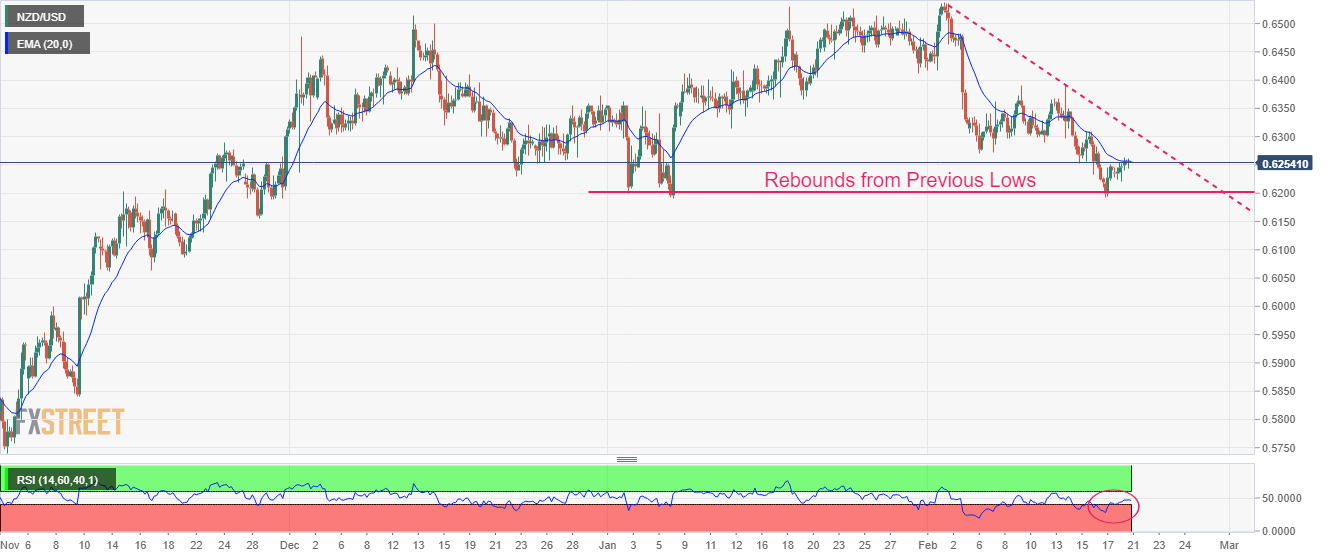
| Index | Change, points | Closed | Change, % |
|---|---|---|---|
| NIKKEI 225 | 18.81 | 27531.94 | 0.07 |
| Hang Seng | 167.15 | 20886.96 | 0.81 |
| KOSPI | 3.91 | 2455.12 | 0.16 |
| ASX 200 | 4.7 | 7351.5 | 0.06 |
| FTSE 100 | 9.91 | 8014.31 | 0.12 |
| DAX | -4.45 | 15477.55 | -0.03 |
| CAC 40 | -12.11 | 7335.61 | -0.16 |
- Gold price remains sidelined between 100-day and 50-day Exponential Moving Averages (EMAs).
- Sluggish markets, mixed sentiment keep traders waiting for fresh clues even as United States data favored XAU/USD bears previously.
- Federal Reserve concerns, geopolitical headlines will be eyed together with the US PMIs for February.
Gold price (XAU/USD) struggles for clear directions around $1,840, following a mildly negative start to the week’s trading, as traders await the preliminary readings of the United States Purchasing Managers Index (PMI) for February. Adding strength to the XAU/USD inaction could be the lack of directives from markets amid Monday’s holiday in the US, as well as a light calendar before Tuesday’s PMIs.
Gold bears remain hopeful but bulls resist stepping back
The fresh hawkish concerns from the United States data surrounding inflation and output have renewed hopes of that the Federal Reserve (Fed) will keep the interest rates higher for longer. The same underpins the US Dollar’s rebound and exert downside pressure on the Gold price.
However, the last round of the Fed policymakers appeared mixed and hence seems to raise doubts on the policy pivot, as well as the future rate lifts from the US central bank, which in turn puts a floor under the XAU/USD price.
Alternatively, hopes of more stimulus from China, as perceived from the People’s Bank of China’s (PBOC) inaction, as well as the government’s measures to defend the struggling housing sector, seems to favor the Gold buyers. Furthermore, the nearness to the Fed’s peak rate also likely to help the XAU/USD bears from rejecting the defeat.
Geopolitical fears, Purchasing Managers Index eyed ahead of Fed Minutes
While the aforementioned catalysts highlight this week’s Fed Minutes for clear directions, fears emanating from China, Russia and North Korea, seem to gain major attention and should be eyed for clear directions of the Gold price. Also important will be the first readings of the global PMIs for February.
Should the scheduled US PMIs appear firmer than January and manage to cross the 50.0 mark, despite unimpressive expectations, that odds of witnessing further US Dollar strength and the XAU/USD weakness can’t be ruled out.
On the contrary, the fears surrounding the US and China are likely to keep exerting downside pressure on the Gold price as neither the US nor China appears interested in solving the political differences. Recently, both the nations alleged each other over the balloon shooting whereas the US diplomatic with Taiwan may tease Beijing. On the same line, the United Nations (UN) Security Council is being alarmed by Japan for North Korea’s missile testing and the same can weigh on the sentiment, as well as the XAU/USD price.
That said, S&P 500 Futures print mild losses near 4,075 amid sluggish US 10-year Treasury bond yields.
Gold price technical analysis
Gold price seesaws between the 100-day and 50-day Exponential Moving Averages (EMAs), respectively near $1,820 and $1,854 by the press time.
The pair’s latest inaction should have taken clues from the sluggish Relative Strength Index (RSI) line, placed at 14.
However, the bearish signals from the Moving Average Convergence and Divergence (MACD) indicator joins the XAU/USD’s sustained break of the previous support line from late November 2022, close to $1,912 at the latest, keeps the Gold bears hopeful.
That said, the two-week-old descending trend line adds strength to the $1,820 support comprising the 50-day EMA.
Hence, the Gold price may keep grinding higher unless declining back below the $1,820. However, the upside appears limited unless the XAU/USD stays below $1,912.
Gold price: Daily chart
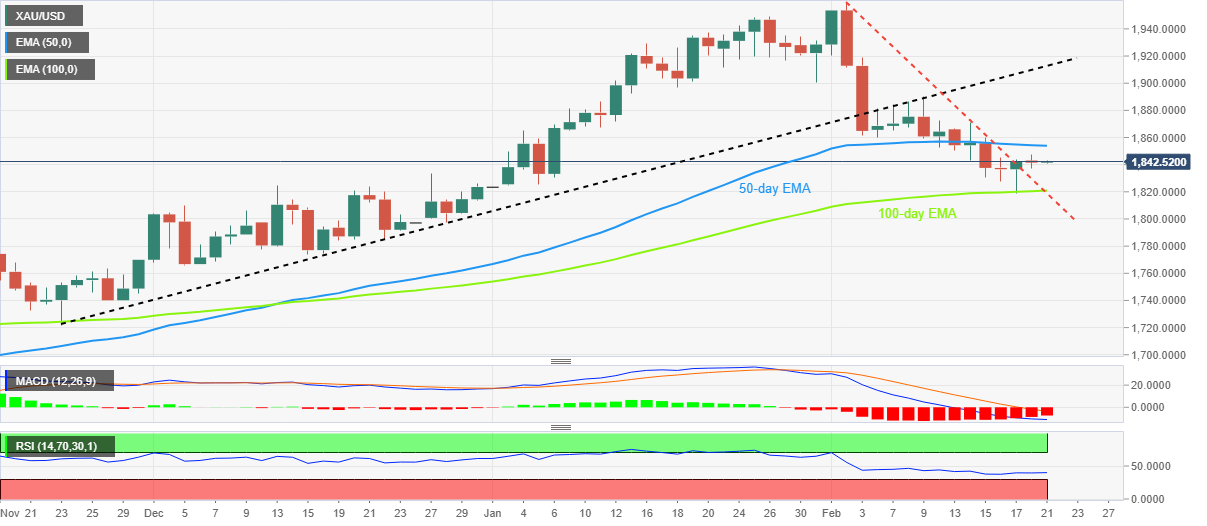
Trend: Further upside expected
- USD/JPY bears are lurking in territories above a critical structure in the 133.70s.
- The W-formation could hamstring further bullish advances.
USD/JPY has been in the hands of the bulls which leaves a bias to the downside for a move into longs that had last accumulated since the middle of the month. The following illustrates the prospects of a move to restest the W-formation's neckline on the daily chart.
USD/JPY daily charts
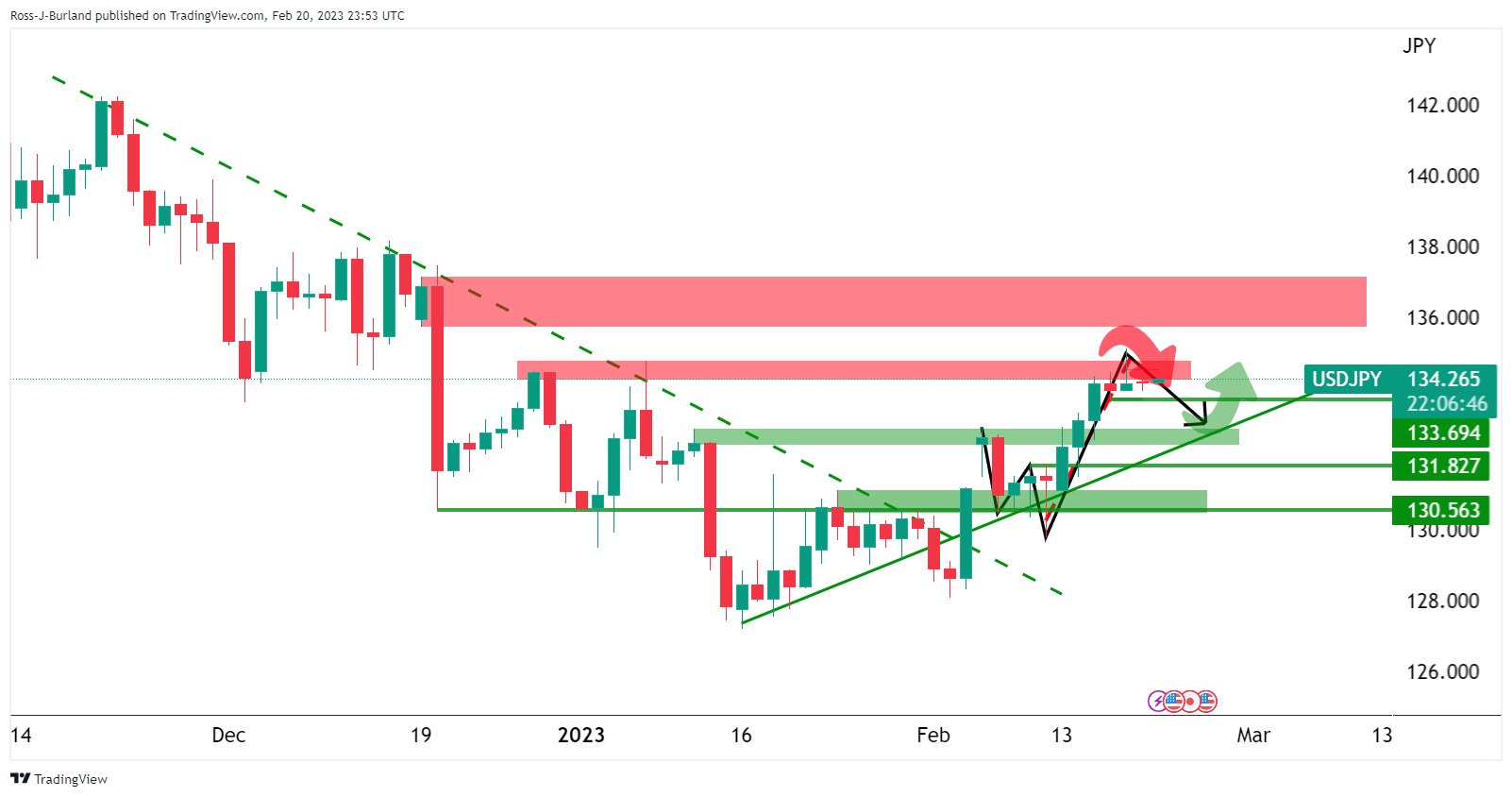
USD/JPY is on the backside of the prior bearish run, which puts the focus on the upside longer-term. However, for the time being, there are prospects of a move into longs above 130.50.
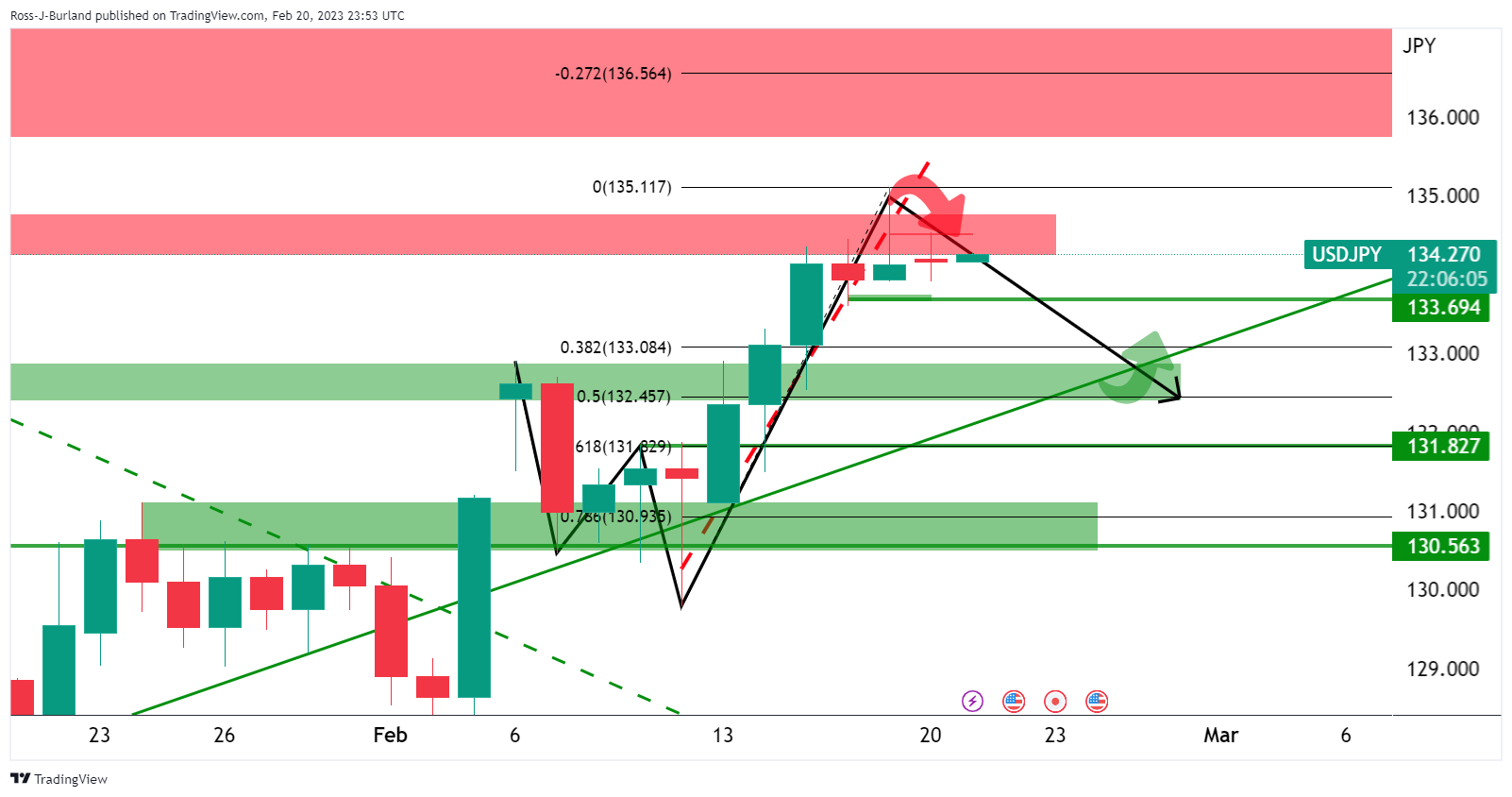
The W-formation is a reversion pattern and the price has a tendency to move back to restest the neckline. However, in this case, the bullish leg is overextended so there are possibilities that the price may only reach as far as the prior resistance near a 38.2% Fibonacci around 133.00.
USD/JPY H1 chart

USD/JPY has started to top out and a break below 133.80 structure opens the risk of a significant correction for the day ahead.
| Pare | Closed | Change, % |
|---|---|---|
| AUDUSD | 0.69104 | 0.6 |
| EURJPY | 143.487 | 0.11 |
| EURUSD | 1.06859 | 0 |
| GBPJPY | 161.706 | 0.22 |
| GBPUSD | 1.20425 | 0.2 |
| NZDUSD | 0.62524 | 0.28 |
| USDCAD | 1.34542 | -0.16 |
| USDCHF | 0.92311 | -0.15 |
| USDJPY | 134.281 | 0.05 |
- EUR/JPY remains sidelined after a sluggish start to the week.
- Hawkish ECB talks, fears that BoJ’s Kuroda could play one last shot before retiring seem to favor bulls.
- Sluggish yields amid US holidays challenged momentum traders ahead of today’s full markets.
- Preliminary readings of February’s activity data eyed for clear directions.
EUR/JPY seesaws around mid-143.00s amid Tuesday’s sluggish Asian session, following an inactive start to the week’s trading.
The cross-currency pair struggles justify the hawkish comments from the European Central Bank (ECB) officials and the upbeat Eurozone data ahead of the key Purchasing Managers Index (PMI) figures for February. Other than the cautious mood before February’s PMIs for Japan, Germany and the Eurozone, flat US Treasury bond yields also challenge the pair’s immediate moves.
ECB governing council member and Finnish central bank Chief Olli Rehn recently said, per Reuters, “ECB should keep raising interest rates beyond March and the rate peak, which should be stuck to for some time, could be reached over the summer.” "With inflation so high, further rate hikes beyond March seem likely, logical and appropriate," Rehn told Germany’s Börsen-Zeitung newspaper.
Also teasing the EUR/JPY bulls could be the upbeat prints of Eurozone Consumer Confidence. That said, the first readings of the bloc’s Consumer Confidence for February matched market forecasts of -19 versus -20.9 prior.
Furthermore, fading hawkish bias about the Bank of Japan’s (BoJ) next moves, amid fears that Governor Haruhiko Kuroda will play his one last shot of ultra-loose monetary policy before retiring in April, also seemed to have favored the EUR/JPY buyers.
On the flip side, challenges to the sentiment, especially emanating from geopolitical fears surrounding China, Russia and North Korea, weigh on the prices. Furthermore, fears of the BoJ’s money market intervention and upbeat Japan data also tease the EUR/JPY sellers.
To portray the mood, S&P 500 Futures print mild losses near 4,075 amid sluggish US 10-year Treasury bond yields.
That said, EUR/JPY traders should keep their eyes on the geopolitical headlines ahead of the key activity data for Japan and the bloc. It should be noted that the firmer prints of the EU PMIs could offer more strength to the EUR buyers than the JPY, in case of upbeat Japanese data, amid dovish bias for the BoJ and the hawkish concerns for the ECB.
Technical analysis
Monday’s Doji candlestick teases EUR/JPY bears but the previous resistance line from late December 2022, around 142.80 by the press time, puts a floor under the prices.
© 2000-2024. All rights reserved.
This site is managed by Teletrade D.J. LLC 2351 LLC 2022 (Euro House, Richmond Hill Road, Kingstown, VC0100, St. Vincent and the Grenadines).
The information on this website is for informational purposes only and does not constitute any investment advice.
The company does not serve or provide services to customers who are residents of the US, Canada, Iran, The Democratic People's Republic of Korea, Yemen and FATF blacklisted countries.
Making transactions on financial markets with marginal financial instruments opens up wide possibilities and allows investors who are willing to take risks to earn high profits, carrying a potentially high risk of losses at the same time. Therefore you should responsibly approach the issue of choosing the appropriate investment strategy, taking the available resources into account, before starting trading.
Use of the information: full or partial use of materials from this website must always be referenced to TeleTrade as the source of information. Use of the materials on the Internet must be accompanied by a hyperlink to teletrade.org. Automatic import of materials and information from this website is prohibited.
Please contact our PR department if you have any questions or need assistance at pr@teletrade.global.
